Clifford Browder's Blog, page 44
October 26, 2014
150. Wall Street, Greed, and Addiction
"Wall Street! Who shall fathom the depth and the rottenness of thy mysteries? Has Gorgon passed through thy winding labyrinth, turning with his smile every thing to stone – hearts as well as houses? Art thou not the valley of riches told of by the veracious Sinbad, where millions of diamonds lay glistening like fiery snow, but which was guarded on all sides by poisonous serpents, whose bite was death and whose contact was pollution?"
So spoke journalist George G. Foster in his book entitled New York in Slices, published in New York in 1849. Which goes to show that Wall Street – meaning not just the street itself but the whole financial community – has from an early date inspired a mix of fascination, puzzlement, and censure.
This post is not about the history of Wall Street, which was dealt with in posts #95, 96, 97; it’s about greed and addiction. Let’s continue where those posts left off, with a look at the façade of the New York Stock Exchange, in the heart, figuratively and literally, of Wall Street. Since 1903 the Exchange’s home has been a noble neoclassical edifice in white marble fronted by six massive Corinthian columns at 18 Broad Street, just south of Wall. It suggests a Greek temple, and its pediment crammed with statuary shows Integrity Protecting the Works of Man. An amply robed Integrity looms centrally, with figures representing Agriculture and Mining on the right, and Science, Industry, and Invention on the left. Who the infants near Integrity’s feet represent, I haven’t been able to determine. But Integrity rules over all … at least in the sculptor’s mind. A reassuring thought, is it not?
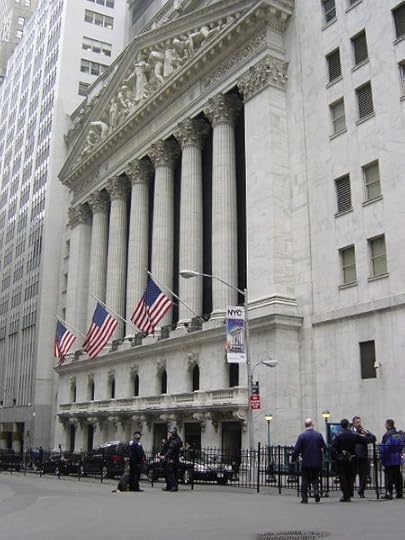 The Stock Exchange, guarded by security personnel and police with M16
The Stock Exchange, guarded by security personnel and police with M16
machine guns and police dogs, following the 9/11 attack.
Kowloonese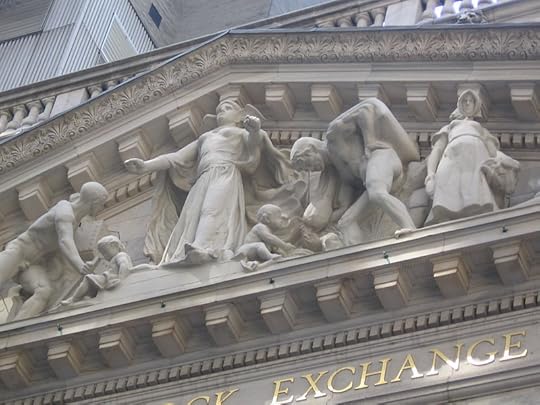 Integrity in the center, stretching both arms out with clenched fists. Agriculture and Mining on the right, with Agriculture shown here as a man bending under the weight of a sack of grain, and a woman in a bonnet and pioneer dress leading a sheep. Science and Industry on the left, shown here as a man pushing a lever.
Integrity in the center, stretching both arms out with clenched fists. Agriculture and Mining on the right, with Agriculture shown here as a man bending under the weight of a sack of grain, and a woman in a bonnet and pioneer dress leading a sheep. Science and Industry on the left, shown here as a man pushing a lever.
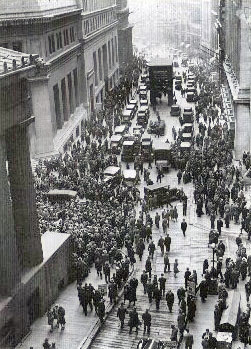 The crowd outside the Exchange
The crowd outside the Exchange
following the 1929 Crash. Now let’s flash back to Thursday, October 25, 1929, Black Thursday, when turmoil raged in the Stock Exchange as prices plummeted, margin calls went out, a crowd gathered outside in the street, and rumors of suicides circulated. That afternoon all eyes were on Richard Whitney, acting vice-president of the New York Stock Exchange in the absence of the Exchange’s president, who was off on an extended honeymoon in Hawaii. A tall, handsome, muscular man, at 1:30 p.m. Whitney walked confidently onto the trading floor and, stopping at Post No. 2, loudly announced, “I bid 205 for 10,000 Steel!” – a bid well above the current market price. Immediately a huge cry went up from the trading floor. Whitney then placed similar bids for AT&T, Anaconda Copper, General Electric, and other blue-chip stocks. Behind him were the combined resources of the leading bankers of the day, to the tune of $130 million, on whose behalf he was acting.
After this show of confidence by Whitney, the panic subsided and people took heart; maybe the dramatic slide was over. Suddenly famous, Whitney looked like a hero, the “Great White Knight” of Wall Street. In the following year the Exchange elected him their president, and in that capacity he made speeches around the country emphasizing the high character of the New York Stock Exchange and the companies that were traded there. “Business Honesty” was the name of one of his speeches, and he stressed an ethical corporate environment as the key to recovery. Above all, the Exchange was not to blame.
Alas, Whitney’s dramatic gesture on the trading floor, and the speeches that followed later, were not enough. On Monday, October 28, the plunge resumed, as the Dow dropped 13%, and on the following day, Black Tuesday, it lost another 12% in the heaviest trading ever. The Great Crash could not be stemmed; stocks recovered, fell again, recovered a bit, and fell once more, not reaching the bottom until 1932, by which time the Great Depression was well under way.
(Wall Street’s history abounds in Black Mondays, Tuesdays, Wednesdays, Thursdays, and Fridays. Saturday seems to have been immune to financial disasters, maybe because, in recent times, the New York Stock Exchange is closed then for trading. And the Sabbath has of course been spared.)
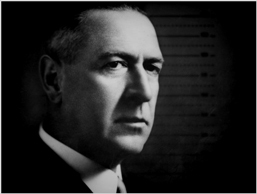
Who was Richard Whitney, this proponent of financial integrity? Born in 1888 to an old patrician family in Boston, he had attended Groton School and Harvard College, then migrated to New York in 1910 to establish his own bond brokerage business and purchase a seat on the prestigious New York Stock Exchange. A member of the city’s elite social clubs and treasurer of the New York Yacht Club, he lived lavishly with his family in a five-story red brick townhouse at 115 East 73rd Street. He also owned a 495-acre thoroughbred horse and cattle farm in Far Hills, New Jersey, was president of the Essex Fox Hounds, and rode elegantly to the hounds on one of his twenty horses. A quintessential Wasp, well groomed, arrogant, and snobbish, he quietly preventing Jewish applicants from attaining significant positions at the Exchange. But to most observers he was the epitome of the gentleman banker.
Everything about Richard Whitney said money; in fact, it almost screamed it. The trouble was, he didn’t have enough of it. His life style required an income that, even with all his connections, he simply didn’t have. He speculated, he suffered severe losses. So finally he went into debt and went in deep.
Flash forward to 1938, when the comptroller of the New York Stock Exchange reported to his superiors that he had absolute proof that Whitney, who had retired as the Exchange’s president in 1935, that Whitney’s company was insolvent and Whitney himself an embezzler. He and his company soon declared bankruptcy and on March 10 he was indicted for embezzlement by District Attorney Thomas E. Dewey. It soon came to light that he had stolen money from the Stock Exchange’s Gratuity Fund, the New York Yacht Club, and his father-in-law’s estate. The financial elite might have forgiven him almost anything, but stealing from the Yacht Club was unpardonable. Urbane and self-possessed, Whitney pleaded guilty to the charges and was sentenced to 5 to 10 years at Sing Sing. Thousands showed up at Grand Central Station to witness a former head of the Exchange being taken to prison handcuffed to two petty racketeers. Informed of his downfall, President Roosevelt, also a graduate of Groton and Harvard, shook his head sadly and murmured, “Poor Groton. Poor Harvard. Poor Dick.” (He might have added, "Poor Stock Exchange," or perhaps, "Poor Yacht Club.") Though Whitney symbolized the very interests that the President’s New Deal was fighting, Roosevelt refused to demonize Whitney, perhaps because they shared the same privileged background.
At first censorious, public opinion had turned sympathetic, seeing in him a stoic martyr who even in disgrace remained a gentleman. Respect for him extended even to Sing Sing, where other inmates as well as guards lifted their caps to him and asked for his autograph. Assigned at first to mop-and-broom duty, he was soon teaching in the prison school and playing on the baseball team. A model prisoner, he served 3 years and 4 months of his term, was released on parole in August 1941, and was reunited with his ever loyal wife. Banned from dealing in securities in New York State, he became manager of a dairy farm and, later, president of a textile company. Living quietly in Far Hills, he died there in 1974.
Richard Whitney was neither the first nor the last Wall Streeter to be caught cheating. Today, the wake of the 2008 panic and resulting Great Recession, the top executives of the biggest (“too big to fail”) U.S. banks have looked suspect to many. Jamie Dimon, top honcho of my own dear J.P. Morgan Chase, has been criticized for presiding over his bank’s six-billion-dollar loss in a 2012 trade in its London office, and its sale of risky mortgages to investors unaware of the risks, leading to an unprecedented $13 billion settlement with the U.S. Justice Department in 2013, with further investigations and resulting settlements pending. Like Whitney, Mr. Dimon is a handsome, well-tailored, clean-cut gentleman, but so far, one unsmirched by prosecution. When questioned by the Senate Banking Committee in 2012, he was treated deferentially like a visiting dignitary and a financial guru oozing deep wisdom, and not like an irresponsible operator who, so his critics assert, had endangered the whole financial system of the country. Immaculately groomed and urbane, though at times showing signs of nervousness, Dimon, like Whitney long before him, seems to elicit admiration, sympathy, and respect. (Dimon is of Greek American stock and not a WASP, which shows progress of a kind, I suppose.)
 Jamie at Davos, Switzerland, in 2013, at the annual World Economic Forum. Immaculately
Jamie at Davos, Switzerland, in 2013, at the annual World Economic Forum. Immaculately
groomed, and looking like a Ruler of the World.
World Economic Forum
What drives these Wall Street people? The nineteenth-century speculator Daniel Drew confessed to a friend, in a rare moment of candor, that it wasn’t the money itself that he loved, but the wild excitement of the game: “I must have excitement, or I should die.” But I would suggest that it’s both the money and the excitement of the game, and that it’s a matter of addiction. I used to think that addiction involved only substance abuse -- alcohol, tobacco, and drugs. But then a friend confessed to me that he was addicted to sex – for me, an innocent when it comes to addiction, a novel and enigmatic idea. To explain, he said that, periodically, if he didn’t go out every night and have sex with another man, he felt totally unworthy and depressed. Hearing that, I had to accept the fact that sex too could be an addiction. So how about money? Can greed also be, in the full and literal sense of the word, addictive?
Relevant here is the article “For the Love of Money” by former hedge-fund trader Sam Polk, which appeared in the Sunday New York Times of January 19, 2014. Polk tells how his dreams of being rich had been nourished by his father, a salesman with huge dreams that never seemed to materialize, while the family lived from paycheck to paycheck off his mother’s salary. When, at age 22, Polk walked onto the trading floor at Credit Suisse First Boston to begin a summer internship, and saw an array of glowing TV screens, high-tech computer monitors, and phone turrets, he knew at once what he wanted to do with the rest of his life: play this video game to become rich and have power.
So began his career as a trader. Three weeks into his internship his girlfriend dumped him: “I don’t like who you’ve become.” Devastated, he consulted a counselor who showed him how he was using drugs and alcohol to blunt the powerlessness he had felt as a kid; his underlying trouble, she explained, was a “spiritual malady.”
A year or so later, having gotten off drugs and alcohol and graduated from Columbia College, he pestered a managing director at Bank of America until the manager took a chance and hired him. At the end of his first year he was thrilled to receive a $40,000 bonus. But a week later a trader only four years his senior was hired away by another outfit for a salary of $900,000 – 22 times the size of his bonus – and he was at once consumed by envy, and then excited by how much money was available.
So it went. He worked hard, moved up the Wall Street ladder, became a bond and credit default swap trader (whatever that is). After four years in his new job Citibank offered him $1.75 million a year. At age 25 he reveled in money and power. But when, at a meeting, he suggested that the new hedge-fun regulations that everyone on Wall Street was decrying might be better for the system as a whole, the room went quiet and his boss shot him a withering look and said emphatically that he couldn’t think about the system as a whole, only about his company. At which point Polk began to view Wall Street with new eyes.
Now Polk noticed how traders hurled vitriol at the government for limiting their bonuses after the crash, and were infuriated by any mention of higher taxes. Having always envied the men who earned more than he did, he now began to be embarrassed for them and himself. Though he made more money in a single year than his mother, a nurse practitioner, had made in her whole life, he realized that, unlike her, he wasn’t really doing anything, wasn’t useful or necessary to society. And having foreseen the 2008 crash and made money off of it, he himself now didn’t like who he’d become. So he decided to get out.
Polk now realized that he was an addict, craving more money just as an alcoholic craves alcohol. And like any addict, he had an incredibly difficult time shaking his habit. All too often he woke up in the middle of the night terrified at the thought of running out of money, of later feeling like an idiot for giving up his one chance to be really important. In time these feelings abated, and he realized that he had enough money and, if he needed more, he could earn it. But just as a recovered alcoholic still craves alcohol, so he still at times craves money and buys a lottery ticket.
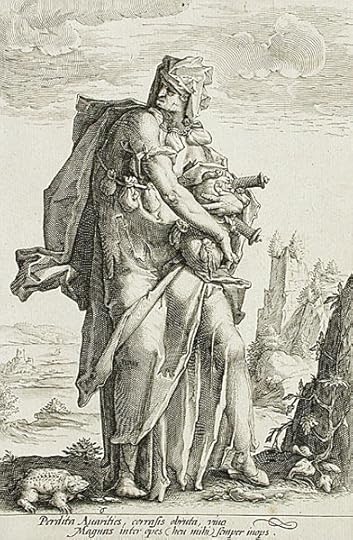 Avarice, an engraving by the Dutch artist Jacob Matham (1571-1631).
Avarice, an engraving by the Dutch artist Jacob Matham (1571-1631).
Now Polk speaks in jails and juvenile detention centers about getting sober, teaches a writing class for girls in the foster system, and manages a nonprofit called Groceryships to help poor families struggling with obesity and food addiction. Which reminds me of a recovered alcoholic I once knew who enlisted in Alcoholics Anonymous to help other alcoholics get free of their addiction. Yet there is no 12-step program for wealth addicts. Why not? he asks. Because our culture supports and even praises the addiction. The superrich appear on the magazine covers at every newsstand, have become our cultural gods. So we all bear some responsibility, Polk insists, for letting wealth addicts exert so much influence over our nation. To which I would add the suggestion that, in a capitalist society, this is close to inevitable. We have always adulated wealth and those who have it.
Sam Polk’s article – well worth reading in its entirety – provides a clear and emphatic answer to the question posed earlier. Can greed become an addiction? Yes!
Coming soon: I haven't the slightest idea. I just hope it happens.
© 2014 Clifford Browder
So spoke journalist George G. Foster in his book entitled New York in Slices, published in New York in 1849. Which goes to show that Wall Street – meaning not just the street itself but the whole financial community – has from an early date inspired a mix of fascination, puzzlement, and censure.
This post is not about the history of Wall Street, which was dealt with in posts #95, 96, 97; it’s about greed and addiction. Let’s continue where those posts left off, with a look at the façade of the New York Stock Exchange, in the heart, figuratively and literally, of Wall Street. Since 1903 the Exchange’s home has been a noble neoclassical edifice in white marble fronted by six massive Corinthian columns at 18 Broad Street, just south of Wall. It suggests a Greek temple, and its pediment crammed with statuary shows Integrity Protecting the Works of Man. An amply robed Integrity looms centrally, with figures representing Agriculture and Mining on the right, and Science, Industry, and Invention on the left. Who the infants near Integrity’s feet represent, I haven’t been able to determine. But Integrity rules over all … at least in the sculptor’s mind. A reassuring thought, is it not?
 The Stock Exchange, guarded by security personnel and police with M16
The Stock Exchange, guarded by security personnel and police with M16machine guns and police dogs, following the 9/11 attack.
Kowloonese
 Integrity in the center, stretching both arms out with clenched fists. Agriculture and Mining on the right, with Agriculture shown here as a man bending under the weight of a sack of grain, and a woman in a bonnet and pioneer dress leading a sheep. Science and Industry on the left, shown here as a man pushing a lever.
Integrity in the center, stretching both arms out with clenched fists. Agriculture and Mining on the right, with Agriculture shown here as a man bending under the weight of a sack of grain, and a woman in a bonnet and pioneer dress leading a sheep. Science and Industry on the left, shown here as a man pushing a lever. The crowd outside the Exchange
The crowd outside the Exchangefollowing the 1929 Crash. Now let’s flash back to Thursday, October 25, 1929, Black Thursday, when turmoil raged in the Stock Exchange as prices plummeted, margin calls went out, a crowd gathered outside in the street, and rumors of suicides circulated. That afternoon all eyes were on Richard Whitney, acting vice-president of the New York Stock Exchange in the absence of the Exchange’s president, who was off on an extended honeymoon in Hawaii. A tall, handsome, muscular man, at 1:30 p.m. Whitney walked confidently onto the trading floor and, stopping at Post No. 2, loudly announced, “I bid 205 for 10,000 Steel!” – a bid well above the current market price. Immediately a huge cry went up from the trading floor. Whitney then placed similar bids for AT&T, Anaconda Copper, General Electric, and other blue-chip stocks. Behind him were the combined resources of the leading bankers of the day, to the tune of $130 million, on whose behalf he was acting.
After this show of confidence by Whitney, the panic subsided and people took heart; maybe the dramatic slide was over. Suddenly famous, Whitney looked like a hero, the “Great White Knight” of Wall Street. In the following year the Exchange elected him their president, and in that capacity he made speeches around the country emphasizing the high character of the New York Stock Exchange and the companies that were traded there. “Business Honesty” was the name of one of his speeches, and he stressed an ethical corporate environment as the key to recovery. Above all, the Exchange was not to blame.
Alas, Whitney’s dramatic gesture on the trading floor, and the speeches that followed later, were not enough. On Monday, October 28, the plunge resumed, as the Dow dropped 13%, and on the following day, Black Tuesday, it lost another 12% in the heaviest trading ever. The Great Crash could not be stemmed; stocks recovered, fell again, recovered a bit, and fell once more, not reaching the bottom until 1932, by which time the Great Depression was well under way.
(Wall Street’s history abounds in Black Mondays, Tuesdays, Wednesdays, Thursdays, and Fridays. Saturday seems to have been immune to financial disasters, maybe because, in recent times, the New York Stock Exchange is closed then for trading. And the Sabbath has of course been spared.)

Who was Richard Whitney, this proponent of financial integrity? Born in 1888 to an old patrician family in Boston, he had attended Groton School and Harvard College, then migrated to New York in 1910 to establish his own bond brokerage business and purchase a seat on the prestigious New York Stock Exchange. A member of the city’s elite social clubs and treasurer of the New York Yacht Club, he lived lavishly with his family in a five-story red brick townhouse at 115 East 73rd Street. He also owned a 495-acre thoroughbred horse and cattle farm in Far Hills, New Jersey, was president of the Essex Fox Hounds, and rode elegantly to the hounds on one of his twenty horses. A quintessential Wasp, well groomed, arrogant, and snobbish, he quietly preventing Jewish applicants from attaining significant positions at the Exchange. But to most observers he was the epitome of the gentleman banker.
Everything about Richard Whitney said money; in fact, it almost screamed it. The trouble was, he didn’t have enough of it. His life style required an income that, even with all his connections, he simply didn’t have. He speculated, he suffered severe losses. So finally he went into debt and went in deep.
Flash forward to 1938, when the comptroller of the New York Stock Exchange reported to his superiors that he had absolute proof that Whitney, who had retired as the Exchange’s president in 1935, that Whitney’s company was insolvent and Whitney himself an embezzler. He and his company soon declared bankruptcy and on March 10 he was indicted for embezzlement by District Attorney Thomas E. Dewey. It soon came to light that he had stolen money from the Stock Exchange’s Gratuity Fund, the New York Yacht Club, and his father-in-law’s estate. The financial elite might have forgiven him almost anything, but stealing from the Yacht Club was unpardonable. Urbane and self-possessed, Whitney pleaded guilty to the charges and was sentenced to 5 to 10 years at Sing Sing. Thousands showed up at Grand Central Station to witness a former head of the Exchange being taken to prison handcuffed to two petty racketeers. Informed of his downfall, President Roosevelt, also a graduate of Groton and Harvard, shook his head sadly and murmured, “Poor Groton. Poor Harvard. Poor Dick.” (He might have added, "Poor Stock Exchange," or perhaps, "Poor Yacht Club.") Though Whitney symbolized the very interests that the President’s New Deal was fighting, Roosevelt refused to demonize Whitney, perhaps because they shared the same privileged background.
At first censorious, public opinion had turned sympathetic, seeing in him a stoic martyr who even in disgrace remained a gentleman. Respect for him extended even to Sing Sing, where other inmates as well as guards lifted their caps to him and asked for his autograph. Assigned at first to mop-and-broom duty, he was soon teaching in the prison school and playing on the baseball team. A model prisoner, he served 3 years and 4 months of his term, was released on parole in August 1941, and was reunited with his ever loyal wife. Banned from dealing in securities in New York State, he became manager of a dairy farm and, later, president of a textile company. Living quietly in Far Hills, he died there in 1974.
Richard Whitney was neither the first nor the last Wall Streeter to be caught cheating. Today, the wake of the 2008 panic and resulting Great Recession, the top executives of the biggest (“too big to fail”) U.S. banks have looked suspect to many. Jamie Dimon, top honcho of my own dear J.P. Morgan Chase, has been criticized for presiding over his bank’s six-billion-dollar loss in a 2012 trade in its London office, and its sale of risky mortgages to investors unaware of the risks, leading to an unprecedented $13 billion settlement with the U.S. Justice Department in 2013, with further investigations and resulting settlements pending. Like Whitney, Mr. Dimon is a handsome, well-tailored, clean-cut gentleman, but so far, one unsmirched by prosecution. When questioned by the Senate Banking Committee in 2012, he was treated deferentially like a visiting dignitary and a financial guru oozing deep wisdom, and not like an irresponsible operator who, so his critics assert, had endangered the whole financial system of the country. Immaculately groomed and urbane, though at times showing signs of nervousness, Dimon, like Whitney long before him, seems to elicit admiration, sympathy, and respect. (Dimon is of Greek American stock and not a WASP, which shows progress of a kind, I suppose.)
 Jamie at Davos, Switzerland, in 2013, at the annual World Economic Forum. Immaculately
Jamie at Davos, Switzerland, in 2013, at the annual World Economic Forum. Immaculately groomed, and looking like a Ruler of the World.
World Economic Forum
What drives these Wall Street people? The nineteenth-century speculator Daniel Drew confessed to a friend, in a rare moment of candor, that it wasn’t the money itself that he loved, but the wild excitement of the game: “I must have excitement, or I should die.” But I would suggest that it’s both the money and the excitement of the game, and that it’s a matter of addiction. I used to think that addiction involved only substance abuse -- alcohol, tobacco, and drugs. But then a friend confessed to me that he was addicted to sex – for me, an innocent when it comes to addiction, a novel and enigmatic idea. To explain, he said that, periodically, if he didn’t go out every night and have sex with another man, he felt totally unworthy and depressed. Hearing that, I had to accept the fact that sex too could be an addiction. So how about money? Can greed also be, in the full and literal sense of the word, addictive?
Relevant here is the article “For the Love of Money” by former hedge-fund trader Sam Polk, which appeared in the Sunday New York Times of January 19, 2014. Polk tells how his dreams of being rich had been nourished by his father, a salesman with huge dreams that never seemed to materialize, while the family lived from paycheck to paycheck off his mother’s salary. When, at age 22, Polk walked onto the trading floor at Credit Suisse First Boston to begin a summer internship, and saw an array of glowing TV screens, high-tech computer monitors, and phone turrets, he knew at once what he wanted to do with the rest of his life: play this video game to become rich and have power.
So began his career as a trader. Three weeks into his internship his girlfriend dumped him: “I don’t like who you’ve become.” Devastated, he consulted a counselor who showed him how he was using drugs and alcohol to blunt the powerlessness he had felt as a kid; his underlying trouble, she explained, was a “spiritual malady.”
A year or so later, having gotten off drugs and alcohol and graduated from Columbia College, he pestered a managing director at Bank of America until the manager took a chance and hired him. At the end of his first year he was thrilled to receive a $40,000 bonus. But a week later a trader only four years his senior was hired away by another outfit for a salary of $900,000 – 22 times the size of his bonus – and he was at once consumed by envy, and then excited by how much money was available.
So it went. He worked hard, moved up the Wall Street ladder, became a bond and credit default swap trader (whatever that is). After four years in his new job Citibank offered him $1.75 million a year. At age 25 he reveled in money and power. But when, at a meeting, he suggested that the new hedge-fun regulations that everyone on Wall Street was decrying might be better for the system as a whole, the room went quiet and his boss shot him a withering look and said emphatically that he couldn’t think about the system as a whole, only about his company. At which point Polk began to view Wall Street with new eyes.
Now Polk noticed how traders hurled vitriol at the government for limiting their bonuses after the crash, and were infuriated by any mention of higher taxes. Having always envied the men who earned more than he did, he now began to be embarrassed for them and himself. Though he made more money in a single year than his mother, a nurse practitioner, had made in her whole life, he realized that, unlike her, he wasn’t really doing anything, wasn’t useful or necessary to society. And having foreseen the 2008 crash and made money off of it, he himself now didn’t like who he’d become. So he decided to get out.
Polk now realized that he was an addict, craving more money just as an alcoholic craves alcohol. And like any addict, he had an incredibly difficult time shaking his habit. All too often he woke up in the middle of the night terrified at the thought of running out of money, of later feeling like an idiot for giving up his one chance to be really important. In time these feelings abated, and he realized that he had enough money and, if he needed more, he could earn it. But just as a recovered alcoholic still craves alcohol, so he still at times craves money and buys a lottery ticket.
 Avarice, an engraving by the Dutch artist Jacob Matham (1571-1631).
Avarice, an engraving by the Dutch artist Jacob Matham (1571-1631).Now Polk speaks in jails and juvenile detention centers about getting sober, teaches a writing class for girls in the foster system, and manages a nonprofit called Groceryships to help poor families struggling with obesity and food addiction. Which reminds me of a recovered alcoholic I once knew who enlisted in Alcoholics Anonymous to help other alcoholics get free of their addiction. Yet there is no 12-step program for wealth addicts. Why not? he asks. Because our culture supports and even praises the addiction. The superrich appear on the magazine covers at every newsstand, have become our cultural gods. So we all bear some responsibility, Polk insists, for letting wealth addicts exert so much influence over our nation. To which I would add the suggestion that, in a capitalist society, this is close to inevitable. We have always adulated wealth and those who have it.
Sam Polk’s article – well worth reading in its entirety – provides a clear and emphatic answer to the question posed earlier. Can greed become an addiction? Yes!
Coming soon: I haven't the slightest idea. I just hope it happens.
© 2014 Clifford Browder
Published on October 26, 2014 05:12
October 19, 2014
149. Fulton J. Sheen and Norman Vincent Peale
A superb showman, he appeared on television before a live audience on Tuesday nights at 8:00 p.m. in full episcopal regalia: a long purple cape over a black cassock, and on his chest a gleaming gold cross. Of medium height and slender build, he had graying wavy hair, deep-set, penetrating eyes with a hypnotic gaze, and the look of an ascetic – albeit a sumptuously garbed ascetic. His rich, cultivated voice caressed, compelled. Looking right at the camera, with graceful arm gestures and quick changes of facial expression he spoke of good and evil, marriage problems, prayer as a dialogue, the holy spirit, the commandments, sin and penance, the sacraments, but in such a way as to appeal not just to Catholics but to a nationwide audience. The set was a study with a desk, chairs, and in the background, shelves of books, perhaps a reminder of his solid Catholic scholarship. At times he drew simple diagrams or wrote significant phrases on a blackboard, his only prop; if the blackboard was full, an unseen stagehand whom he called his “angel” would erase it, so it could receive more simple diagrams and significant phrases.
[image error]Archbishop Fulton John Sheen Spiritual Centre
The bishop’s stage presence and sensitivity to the audience’s mood were remarkable, and he was, to use a newly current word of the time, supremely telegenic. Competing with comedian Milton Berle, “Mr. Television,” whose program was on at the same time as his, the bishop’s program “Life Is Worth Living” had an audience of some thirty million a week. In 1952 his face appeared on the cover of Time magazine – itself a consecration – and the magazine proclaimed him “perhaps the most famous preacher in the U.S., certainly America’s best-known Roman Catholic priest, and the newest star of U.S. television.”
Such were the unexpected fame and success of the Most Reverend Fulton J. Sheen, Auxiliary Bishop of the Archdiocese of New York, in the 1950s. The number of stations carrying his program, which was filmed at the Adelphi Theater on West 54thStreet in New York, went from three to fifteen in less than two months. The demand for tickets for the show was too overwhelming to be met, and fan mail came pouring in at the rate of 8,500 letters a week. For instance:
A Massachusetts nurse: “I looked to my minister for advice, but because the matter was so personal I resisted asking him outright. Therefore I am writing to you….”
A South Dakota housewife: “I feel worried….”
A Philadelphia professional woman: “Last year it was made clear to me that my husband had an affair with a married woman…. Please use some theme which you think might bear on the remorse and regret which will follow if homes are wrecked by such relationships.”
He had a good sense of humor, used jokes and memorable one-liners:
“I see you’ve come to have your faith lifted.”
“An atheist is a man without visible means of support.”
“Long time no Sheen.”
Once, imitating his friendly rival Milton Berle, known to viewers as “Uncle Miltie,” he began, “Good evening, this is Uncle Fultie.” And he gave credit to his writers, Matthew, Mark, Luke, and John. Though inspirational, he was fun as well.
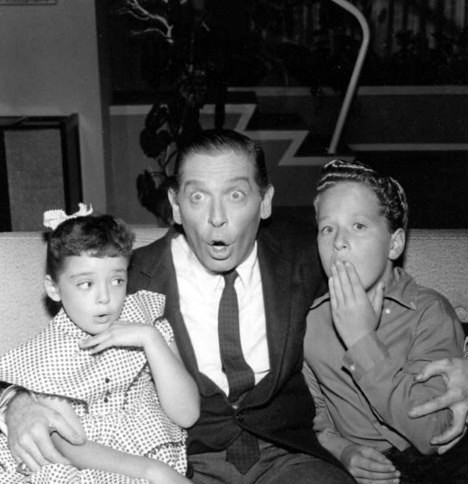 Uncle Miltie and friends.
Uncle Miltie and friends.“Hearing nuns’ confessions,” he confessed, “is like being stoned to death with popcorn.” “The big print giveth,” he observed, “and the fine print taketh away.” And perhaps his Irish American background inspired the comment, “Baloney is flattery laid on so thick it cannot be true, and blarney is flattery so thin we love it.” Being famous and acclaimed, he probably got a good bit of both.
Born in 1895 to a farming family near Peoria, Illinois, he was Irish on both sides, showed an early preference for books over farm work, and was ordained a priest in 1919. Subsequently he earned a doctorate in philosophy at the Catholic University of Louvain in Belgium, and claimed to have earned another doctorate in Rome, though this has been challenged; he may have invented it so as to speed up his advancement. Be that as it may, he had a solid foundation in Catholic philosophy and theology before beginning his career in media with a weekly radio broadcast in 1930. Time magazine in 1946 referred to him as “the golden-voiced Monsignor Fulton J. Sheen, U.S. Catholicism’s famed proselytizer,” but his real career and fame began in 1952, when Sheen, lately made a bishop, began his program “Life Is Worth Living” on television, the medium in which his splendor of presence could at last be fully conveyed to an audience. And conveyed it was, magnificently, to millions. Soon hailed as the first televangelist, he was unpaid, and the commercials were kept to a minimum.
Especially memorable was a program in February 1953 when Sheen, a fierce anti-Communist but no follower of Senator Joe McCarthy, denounced Stalin’s regime in Russia and gave a reading of the burial scene in Shakespeare’s Julius Caesar, substituting the names of the most prominent Soviet leaders, with Stalin as the murdered Caesar. “Stalin must one day meet his judgment,” he concluded. Stalin suffered a stroke a few days later and died on March 5, 1953.
It is no surprise, then, that FBI director J. Edgar Hoover admired Sheen and kept a file on him, since he liked to keep track of friends as well as enemies. On June 12, 1953, at Hoover’s invitation, the man who some thought had foretold the death of the villainous Stalin addressed the graduation exercises of the FBI National Academy in Washington, following which J. Edgar wrote him to say that his address was one of the most inspirational talks he had ever heard. And from the FBI files on the bishop we can glean an array of interesting tidbits:
· Sheen likes ice cream and angel food cake.· He likes to play tennis and wears a white scarf and white flannel trousers when doing so.· At a dinner for a group of men, when asked if he got all he wanted for Christmas, he said no, he wanted some royal blue silk pajamas. The next day he received twenty pairs of the same, each of the men thinking he was acting alone.· For years he drove a light cream-colored convertible, wearing a camel hair coat, a white scarf, and dark glasses while driving, so as to avoid being recognized. (His announced appearances were always mobbed by fans.) If stopped by a motorcycle cop for speeding, he used all his powers of oratory to avoid a ticket.· He lives simply in New York, rising at 6:00 a.m., attends a private Mass, isn’t at his desk before nine.
As these items suggest, Sheen didn’t live the life of a saint; he dressed fashionably, lived luxuriously, and enjoyed the attention he got in the media and the applause of adoring crowds. Humility was not his thing.
Even so, he brought Catholicism into mainstream television and was responsible for some remarkable conversions: author and Congresswoman Clare Booth Luce, Henry Ford II of the automobile dynasty, violinist Fritz Kreisler and his wife, actress Virginia Mayo, and ex-Communist turned anti-Communist Louis F. Budenz, whose conversion must have especially delighted him.
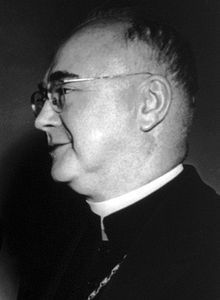 Less elegant than Sheen, but more
Less elegant than Sheen, but morepowerful. The bishop was said to be at times difficult, if his authority was challenged. Why his TV program ended in October 1957, when he was at the height of his television fame, was at the time something of a mystery. It seems that he tangled with another man who could also be difficult, if challenged: his superior, Cardinal Francis J. Spellman of New York. (For more on Spellman, see post #136.) In 1950 Sheen had become director of the New York-based Society for the Propagation of the Faith, and in 1957 he and Spellman engaged in a bitter feud. When Spellman demanded that the Society pay his archdiocese millions for a large quantity of powdered milk that Spellman had given the Society to distribute to the poor, Sheen flat-out refused.
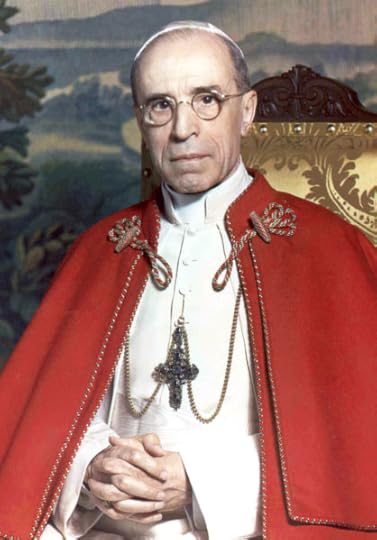
When two colossal egos, one a powerful cardinal archbishop and the other a beloved and charismatic television star, collide, clerical sparks fly. Spellman took the issue all the way to Pope Pius XII, a personal friend, and a private audience resulted where he and Sheen pleaded their respective cases. To get the facts straight, the Pope phoned President Eisenhower, who confirmed Sheen’s account that the U.S. government had given the food to the Church free of charge. His Holiness then sided gently with Sheen, urging reconciliation and dismissing them while giving both men his blessing. Infuriated, the Cardinal reportedly told Sheen afterward, “I will get even with you. It may take six months or ten years, but everyone will know what you’re like.” Spellman quickly got Sheen’s television program canceled and saw to it that his speaking invitations declined and his fund-raising became more difficult. Sheen was, in effect, hounded out of the archdiocese
That was not the end of Fulton J. Sheen. He hosted another TV series in the 1960s, wrote numerous books, and became Bishop of Rochester in 1966, and when, at age 74, he resigned the position in 1969, he was made Archbishop of the Titutular See of Newport, Wales, a ceremonial post that let him devote his time to writing. In 1977 he underwent surgeries that weakened him and made preaching difficult, and two years later he died of heart disease in New York and was interred in the white marble crypt of Saint Patrick’s Cathedral, in close proximity to his nemesis, Cardinal Spellman. Reruns of his programs are still aired, his talks are available on DVDs, and a museum bearing his name houses a collection of his personal items in Peoria, Illinois, where he was first ordained and said his first Mass. In 2002 Bishop Daniel Jenky of the Diocese of Peoria launched a campaign for his canonization.
But that is still not the end of the story. In 2010 the canonization campaign was suspended, owing to a disagreement between the Archdiocese of New York, which possesses Sheen’s remains, and the Diocese of Peoria, which wants the remains returned to Peoria, so they can be examined and relics secured, as required prior to beatification and canonization. In 2012 the Vatican announced that it had recognized Sheen’s life as one of “heroic virtue,” a significant step toward canonization; as a consequence, Sheen is now to be referred to as a “Venerable Servant of God.” For the canonization process to continue, two miracles are necessary, and one was soon forthcoming: a stillborn infant who, thanks to Sheen’s prayers, is said to have lived to be healthy.
Meanwhile the fight continues. Peoria has drawn up blueprints for an elaborate shrine in its cathedral to house the tomb, but Cardinal Timothy Dolan of New York refuses to part with the body, citing the wishes of Sheen’s family and Sheen himself, who spent only a few years in Peoria and many in New York, a city that he loved. Also, Sheen is a personal hero for Dolan, who knew the TV programs as a young boy. He has offered Peoria some bone fragments and other relics from the tomb, but not even a limb or two, much less the body itself. So last September Bishop Jenky announced “with immense sadness” that the campaign had been suspended yet again. There is lamentation in Peoria, but some Catholic observers applaud the delay, saying that canonization should not be rushed, that the old fifty-year rule should be restored, allowing time for a cult to grow organically and prove itself genuine or, in some cases, time for it to die out. And so matters stand to date. Meanwhile the archbishop has been inducted into the Irish American Hall of Fame, an award now proudly displayed in … Peoria.
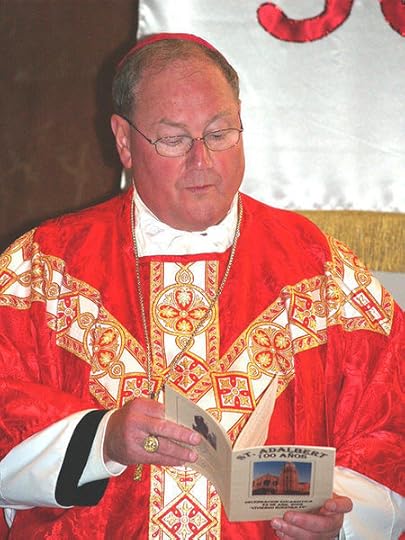 Cardinal Timothy Dolan, who just can't let go.
Cardinal Timothy Dolan, who just can't let go.Cy White
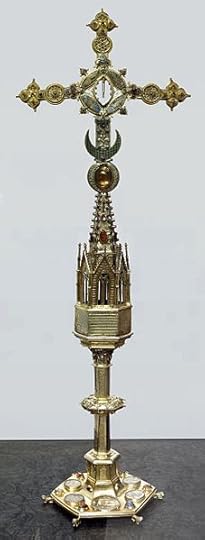 Reliquary with a thorn
Reliquary with a thorn from Christ's crown of
thorns, in the Archbishop's
Museum in Cologne.
Raimond Spekking These events I have watched from afar, a Protestant pressing his stubby nose to a window – perhaps a stained-glass window – in amazement and disbelief at the goings-on within. Catholicism has always fascinated me, ever since, on my first trip to Europe long ago, I discovered the magnificent crumbling churches, always undergoing urgent repairs, with their marvelous statuary and windows, their flickering tapers, their venerable tombs and, displayed in glass cases, dimly visible bits of hair or bone, and once, on a trip to Mexico, the petrified heart of a bishop. These ancient remains, both architectural and human, have puzzled and mystified and intrigued me: this obsessed fixation on the physical is totally alien to Protestantism, yet essential to Catholicism and its cult of miracles.
Perhaps this fixation achieved the ultimate in the worship of the Holy Prepuce, which various churches in Europe have claimed to possess in the past, some even insisting it was a gift from Charlemagne. And if Jesus' foreskin is preserved and enshrined, why not some shorn locks (assuming he ever saw a barber) or some nail clippings? Where indeed does it end? (Incidentally, I have a number of Catholic friends quite firm in their faith, none of whom is concerned about relics.)
And the very idea of Sheen’s body being, as a compromise, divided between Peoria and New York – poor provincial Peoria, so often derided as the quintessential small Midwestern town, and huge, exciting, cosmopolitan New York – the very idea of it shocks and amuses and perplexes me.
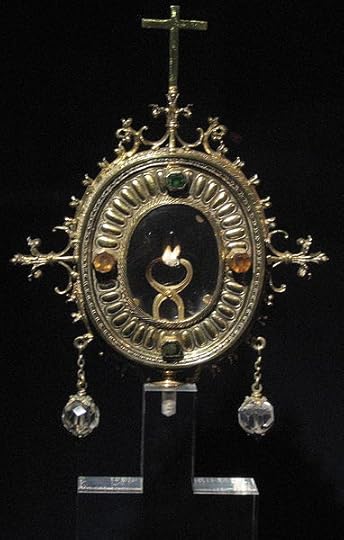 Reliquary with the tooth of Saint Apollonia,
Reliquary with the tooth of Saint Apollonia,in the cathedral of Porto, Portugal. But there is a long history of dividing up sanctified remains. Saint Catherine of Siena’s body is enshrined in Rome, but Siena, allegedly after a bit of smuggling abetted by a miracle, has her head. (Legend has it that the people of Siena tried to sneak the head out of Rome in a bag. When the Roman guards inspected the bag, they found only rose petals, but back in Siena the head reappeared.) And Saint Francis Xavier’s body is in Goa, India, but his right forearm is enshrined in a reliquary in Rome.
Be that as it may, in the case of the Venerable Sheen I wish both dioceses well and hope the process of canonization can continue, so I can go on being shocked and mystified and fascinated, and the deceased archbishop can be properly and definitively entombed somewhere and venerated, bringing comfort and joy to many, as his presence on television did in life.
* * * *
Sheen was not without critics in his own time. He was called glib and superficial, an exponent of the “feel-good religion” of the time. “Americans like to feel good about themselves,” a young Russian acquaintance once said to me with a mischievous smirk, and I can’t deny the truth of his statement. We are an irrepressibly and incurably optimistic race, as witnessed by President Reagan’s cheery message, “It’s morning in America.” There is a whole industry devoted to making Americans feel good about themselves, and to make sure they do, there’s another industry devoted to their self-improvement. In 1923 the French psychologist Émile Coué toured the U.S., teaching audiences to recite, mantra-like, “Every day in every way I’m getting better and better.” In 1936 Dale Carnegie’s How to Win Friends and Influence People was published and soon became a huge best seller still selling today, telling Americans that one could change how other people behave toward you by changing how you behave toward them. “Happiness doesn’t depend on any external conditions, it is governed by our mental attitude,” he asserted. To which he added, “Most of us have far more courage than we ever dreamed we possessed.” It cannot be denied that Sheen’s television program, “Life Is Worth Living,” for all its solid foundation in Catholic thinking, partook of this tradition. Which needn’t mean that it was glib and superficial, though it was certainly of its time.
Also of its time and partaking of that tradition was Dr. Norman Vincent Peale’s The Power of Positive Thinking: A Practical Guide to Mastering the Problems of Everyday Living, published in 1952, whose introduction announced that “you do not need to be defeated by anything, that you can have peace of mind, improved health, and a never ceasing flow of energy.” The book stayed on the best seller list for 186 weeks, sold 5 million copies, and was translated into 15 languages.
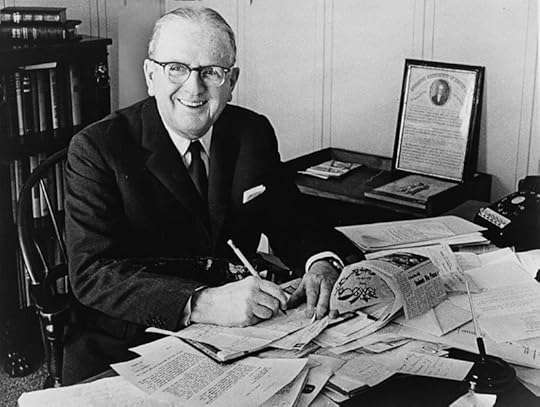 No glamor, just a friendly smile. Born in Ohio in 1898 and ordained a Methodist minister in 1922, ten years later Peale switched to the Reformed Church in America so he could become pastor of the Marble Collegiate Church at 272 Fifth Avenue, on the corner of West 29th Street in Manhattan. (Protestants change sects as easily as they change a hat or a suit of clothes; for Catholics it’s a bit more complicated.) Walking down Fifth Avenue, many a time I passed the church’s marble façade, Romanesque with a dash of Gothic, and saw the reverend’s name emblazoned on a plaque, until one day his name was replaced by another. That would have been in 1984, when he ended his 52-year tenure as pastor, during which the membership grew from 600 to over 5,000, and he became one of the city’s most renowned preachers. He was also on radio for 54 years and later transitioned to television.
No glamor, just a friendly smile. Born in Ohio in 1898 and ordained a Methodist minister in 1922, ten years later Peale switched to the Reformed Church in America so he could become pastor of the Marble Collegiate Church at 272 Fifth Avenue, on the corner of West 29th Street in Manhattan. (Protestants change sects as easily as they change a hat or a suit of clothes; for Catholics it’s a bit more complicated.) Walking down Fifth Avenue, many a time I passed the church’s marble façade, Romanesque with a dash of Gothic, and saw the reverend’s name emblazoned on a plaque, until one day his name was replaced by another. That would have been in 1984, when he ended his 52-year tenure as pastor, during which the membership grew from 600 to over 5,000, and he became one of the city’s most renowned preachers. He was also on radio for 54 years and later transitioned to television.Here are some examples of Peale’s “applied religion”:
· Anybody can do just about anything with himself that he really wants to and makes up his mind to do. · Throw your heart over the fence and the rest will follow.· Don’t walk around with the world on your shoulders.· Believe it is possible to solve your problem. Tremendous things happen to the believer. So believe the answer will come. It will.· Start each day by affirming peaceful, contented and happy attitudes and your days will tend to be pleasant and successful.· Practice happy thinking every day. Cultivate the merry heart, develop the happiness habit, and life will become a continual feast.· It’s always too early to quit.· Fill your life with love. Scatter sunshine. Forget self, think of others.
For Peale, religion and psychology were fused to the point that you could hardly tell one from the other. His followers lapped it up, but not everyone was impressed. When I saw the 1964 film One Man’s Way, Hollywood’s version of his life to date, and his name was pronounced early in the story, there were groans throughout the theater; most of the audience had come for the other film being shown and had no idea what – or who – this one was about.
But there were serious criticisms of his book as well. Mental health experts didn’t hesitate to label him a con man and a fraud. The book was full of vague references to a “famous psychologist,” a “practicing physician,” and countless others, none of them identified. Critics called his understanding of the mind inaccurate, superficial, simplistic, false, and said his reliance on self-hypnosis was potentially dangerous. For him, they asserted, such unpleasant phenomena as murderous rage, suicidal despair, cruelty, lust, and greed don’t really exist; they are simply trivial mental processes that will evaporate if one’s thoughts become more cheerful. And on a lighter note, when Adlai Stevenson, running for the presidency in 1956, was told that Peale had endorsed the incumbent, Eisenhower, Stevenson replied, “Speaking as a Christian, I find the Apostle Paul appealing and the Apostle Peale appalling.”
These criticisms evidently stunned Peale, who later said he even considered resigning his post at the Marble Collegiate Church. What kept him there was the realization that, whatever his critics said, he was sure he was helping millions. On occasion he voiced a political opinion, as when he opposed the election of John F. Kennedy in 1960, insisting that Kennedy would serve the interests of the Catholic Church before those of the United States. This statement provoked condemnations by Harry Truman, the Board of Rabbis, and the leading Protestant theologians of the day, following which Peale seems to have gone into hiding and once again threatened to – but did not – resign from his church. (It’s always too early to quit.) After that he refrained from partisan political pronouncements. But did he ever read Dale Carnegie’s book?
When Richard Nixon was in the White House, Peale was persona most grata there and even officiated at the wedding of Julie Nixon and David Eisenhower. During the Watergate crisis that forced Nixon from office, he continued to frequent the White House, explaining that “Christ didn’t shy away from people in trouble.” One wonders if he told the besieged President to cultivate a merry heart, or advised him that it was always too early to quit.
Presidents simply couldn’t ignore the man, whether living or dead. In 1983 President Reagan awarded Peale the Presidential Medal of Freedom, the highest civilian honor in the U.S., for his contributions to the field of theology (which must have been news to Protestant theologians of the time). And when Peale departed this earth in 1993 (scattering sunshine, one hopes), President Bill Clinton said that Peale’s name would always be associated “with the wondrously American values of optimism and service.” As regards optimism, who could argue?
The 1950s are often dismissed as dull and conformist, when compared with the raging ’60s, but for spiritual sustenance they offered a range of options. For those not attuned to the splendor of Bishop Sheen’s Catholicism or the merry optimism of Dr. Peale’s Protestantism, there was always Billy Graham.
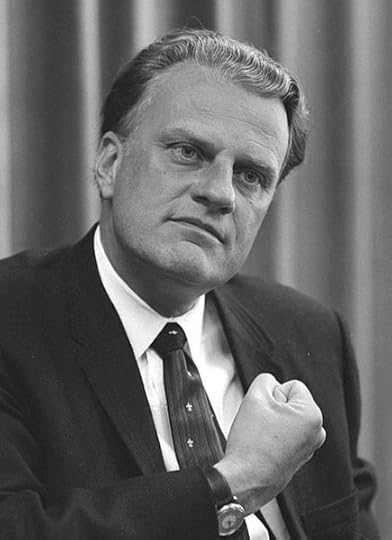 Square-jawed, and as clean-cut as they come.
Square-jawed, and as clean-cut as they come.A memorable Wednesday: At 1:00 a.m. I was wakened by a loud crash in the apartment. My flashlight revealed nothing out of order in the bedroom, but when I looked into the middle room I saw chaos. Four bookshelves attached to the wall had come loose and fallen down, heaping my partner Bob’s books on my computer, Bob’s wheelchair, and the floor. I have never seen such devastation in the apartment. Had I been sitting at my computer, I might well have received a concussion from the falling shelves. The books have now been removed to a bunch of cartons, and I shall see about restoring the shelves, which I installed when we moved in a mere 44 years ago. Bob has vowed to get rid of many books, which is music to my ears, since there are more shelves attached to a longer wall behind the computer, likewise installed 44 years ago. Nothing lasts forever.
Though neither of us had a full night’s sleep, I went to the Union Square greenmarket as usual, and there encountered the following:· A woman whose T-shirt proclaimed, GOD BELONGS IN MY CITY.· Little kids four feet tall with clipboards, making notes on what they experienced in the market.· A bearded drummer sitting shrouded in a long plastic bag, beating obsessively on a cardboard box and being photographed by tourists.· An Asian couple, each with a tiny infant suspended on their chest.· A six foot plus young black man being towed on a skateboard by his girlfriend.· An Asian and a Caucasian woman, surprised to see each other there and flashing smiles and greeting each other rapturously.· An older black woman in radiant blue, walking slowly, inch by inch, with a cane.· Little kids staring in wonder at pumpkins almost as big as they were.· A vendor at my organic bread stand whose T-shirt insisted, “Tibet sera libre.”· And a vast array of apples (maybe fifteen kinds), peaches, plums, root vegetables, a dozen kinds of winter squash, celeriac (“The frog prince of vegetables”), broccoli, kale, bison meat, cheeses, bread, preserves – you name it.
For a taste of the energy and diversity of New York, you can’t do better than the Union Square greenmarket.
Coming soon: Wall Street, greed, and addiction. And when a former president of the New York Stock Exchange pleaded guilty to grand larceny, what one offense did his colleagues find unforgivable?
© 2014 Clifford Browder
Published on October 19, 2014 04:51
October 12, 2014
148. Dorothy Norman and Jawaharlal Nehru.
 Dorothy Norman, by Alfred Stieglitz.
Dorothy Norman, by Alfred Stieglitz.Philadelphia Museum of Art Last week’s post was about Dorothy Norman, the woman who knew everyone, and her relationship with Alfred Stieglitz. This week’s post tells the story of her friendship with Jawaharlal Nehru, the prime minister of India. She had long been interested in Indian art and culture, had discussed Hinduism with the Ceylonese philosopher Ananda Coomaraswamy, had advocated independence for India, and had come to know Madame Pandit, Nehru’s sister, who was India’s U.N. ambassador. Then, on October 11, 1949, two years after India achieved independence, Nehru himself came to the U.S., landing at Washington National Airport, where he and his sister, Madame Pandit, India’s U.N. ambassador, were received by President Truman. And when Nehru came to New York on the 15th, Dorothy Norman and her husband were among those who welcomed him at LaGuardia Airport and were briefly introduced; he struck her as elegant, handsome, bemused by the reception, radiant.
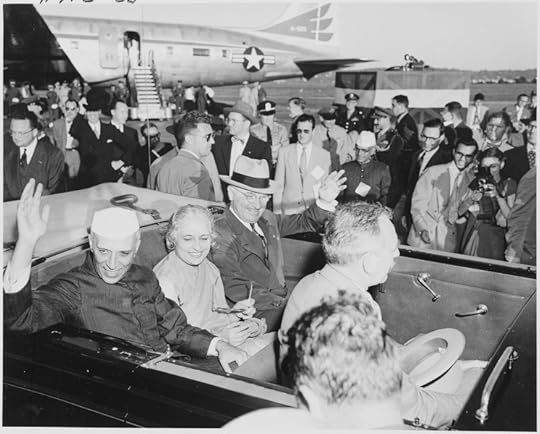 Nehru, Madame Pandit, and President Truman at Washington National Airport.
Nehru, Madame Pandit, and President Truman at Washington National Airport.At a reception at the Waldorf-Astoria that evening Nehru, now wearing Western clothes, seemed distant, yet unofficial, natural, and boyish. His baldness accentuated the noble cast of his face, with its high cheekbones and sharply sculptured nose; he had the bearing of a prince. Introduced again, she felt awkward, but her banal remarks provoked a smile from him, then laughter. Toward the end of the reception Madame Pandit asked her to remain after the others left, as her brother wished to speak to her. Nehru then explained, in his clipped British accent, that for a literary tea the following day the guest list included only familiar names and old fogies; could she include some younger, more progressive people? And if that was impossible, could she invite such people to a tea at her house the day after, when he would be available for no more than forty-five minutes, starting at 3:30 p.m.? His sister had assured him that she knew everyone, could arrange it. And would she please report to him at exactly 9:30 the following morning.
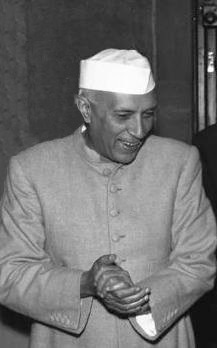 She admired his princely features,
She admired his princely features,his sharply sculptured nose.
Bundesarchiv This request astonished her. She had not been invited to the tea, whose hosts – author Pearl Buck and her husband – would resent her interference. She explained the awkwardness of her position, but Nehru and his sister reassured her: “Blame it on us. There will be no problem at all.” And since she knew Mayor O’Dwyer, could she ask him to cut the morning ceremonies the next day to a minimum? With that, he wished her good night, bowed, and joined the graceful, tapering fingers of both hands in an Indian salutation.
She was baffled, perplexed, and on the verge of laughter. But for this handsome, princely man she was determined to do what she could. Phoning Mayor O’Dwyer at 8:30 a.m. on October 16, she got him to shorten the ceremonies. A half hour later she phoned Pearl Buck, explained the situation, apologized; she and her husband agreed to add a few names, then invited her to the tea and asked her to help them take care of Nehru. She then phoned Nehru, who was grateful for the shortened ceremonies, though he would have to endure the traditional ticker-tape parade on Lower Broadway. Resigning himself to the tea, he repeated his request that she entertain him on the following afternoon. Who should she invite, and how many? “I leave everything to you.”
She and her husband were invited to most of the welcoming events of the day, but she managed to make out a list of guests for her reception and telegrammed invitations. Never before had she been asked to arrange and preside over a gathering if such significance, and on such short notice, but arrange it she did. The following afternoon the Norman living room on East 70th Street was crowded with writers, editors, publishers, intellectuals, and some of Nehru’s family and entourage. Nehru made no speech but answered questions. Cameras clicked, questions followed, and his answers often, to everyone’s surprise, provoked laughter. He stayed not forty-five minutes but an hour and a half, seemed relaxed and happy. When they saw him down to his limousine, he invited her to accompany him to Boston the next day. It would be her first flight and the thought of it terrified her, but she agreed.
She went on the plane with Madame Pandit and Nehru’s only daughter, Indira Gandhi (no relation to the Mahatma), a shy young woman burdened by her role as the prime minister’s daughter. Nehru had Norman sit next to him and they discussed Hinduism and Buddhism. In Boston, more ceremonies, more visits. Together they visited Boston’s two Indian spiritual centers, following which he said to her, “You should be glad, Dorothy, that we don’t have three spiritual centers in Boston.” Back in New York, he gave her a book of his, The Unity of India, drew her attention to a passage describing the beauty of Kashmir as resembling a supremely beautiful woman; their eyes met, and when his revealed a tenderness she hadn’t seen before, she burst into tears. Soon afterward, with his official visit to the city at an end, he left; she joined others at the airport to see him off.
 Sukarno, a professed admirer of the U.S. That was hardly the end of the friendship. Nehru invited her to India for the January 1950 celebrations of the founding of the republic. With her children grown and her journal Twice a Year at an end, she was able to take a leave of absence from the New York Post and go. Arriving at Bombay airport, she was shocked by the two-thin dark bodies on the roads, and the contrast between street beggars and prosperous Indians in their fine cars. In New Delhi she stayed in the Prime Minister’s residence, attended by servants in sashes and turbans, and had breakfast and dinner daily with Nehru and his family. Ceremonies, vast crowds, pageantry. At a formal dinner she chatted with Nehru and President Sukarno of Indonesia, who told her of being raised on Whitman and Lincoln and announced with a superior air that, unlike the British-educated Nehru and other Indian leaders, he had been nurtured by the democratic American tradition. On one occasion Nehru, following behind his household, suddenly stopped and stood on his head. Those ahead of him didn't see it, but he cast an amused look at her to see if she had noticed. She had, their eyes met, and she forced herself not to laugh, while he walked on as if nothing had happened. Throughout her stay she accompanied Nehru on visits, talked with him, got to know his shy daughter Indira better. At times he looked at Norman with the eyes of a child; at times he seemed burdened, trapped in a cage, distant; at times he was relaxed, his charm devastating.
Sukarno, a professed admirer of the U.S. That was hardly the end of the friendship. Nehru invited her to India for the January 1950 celebrations of the founding of the republic. With her children grown and her journal Twice a Year at an end, she was able to take a leave of absence from the New York Post and go. Arriving at Bombay airport, she was shocked by the two-thin dark bodies on the roads, and the contrast between street beggars and prosperous Indians in their fine cars. In New Delhi she stayed in the Prime Minister’s residence, attended by servants in sashes and turbans, and had breakfast and dinner daily with Nehru and his family. Ceremonies, vast crowds, pageantry. At a formal dinner she chatted with Nehru and President Sukarno of Indonesia, who told her of being raised on Whitman and Lincoln and announced with a superior air that, unlike the British-educated Nehru and other Indian leaders, he had been nurtured by the democratic American tradition. On one occasion Nehru, following behind his household, suddenly stopped and stood on his head. Those ahead of him didn't see it, but he cast an amused look at her to see if she had noticed. She had, their eyes met, and she forced herself not to laugh, while he walked on as if nothing had happened. Throughout her stay she accompanied Nehru on visits, talked with him, got to know his shy daughter Indira better. At times he looked at Norman with the eyes of a child; at times he seemed burdened, trapped in a cage, distant; at times he was relaxed, his charm devastating. After a visit of three and a half months, she returned to New York, determined to lobby the government to send food to starving India. The amazing beauty of India, as well as its poverty, haunted her, but what haunted her most was the face of Nehru, its every feature and nuance. Yet when her husband greeted her at the airport, she was overjoyed. For all the wonder of India, she knew that he, her children, and New York were her reality; she still hoped their marriage would survive.
It didn’t. Edward became dictatorial, stern, forbidding, harsh with the children and her. His outbursts multiplied, followed by depression; she came to fear sudden violence on his part. Then, with the children grown, she urged him to find a more compatible woman and marry her; he tried, seemed to find one, but it didn’t work out. Though he pleaded with her not to, in 1953 she went to Reno and initiated divorce proceedings. After six weeks in Reno she obtained the divorce; both were heartsick.
And of course the inevitable question: Were she and Nehru lovers? The memoir certainly indicates a mutual attraction on their part, and the headstand antic, done expressly for her amusement, implies complicity. But to my knowledge she never acknowledged such an affair, and his life was so in view, with his relatives close at hand, and so relentlessly scheduled, that it is hard to imagine. Nehru, whose wife died in 1936, evidently had a protracted affair with Lady Mountbatten, the attractive wife of the last Viceroy of India. A photo of the Viceroy, his wife, and Nehru shows Lord Mountbatten, splendidly garbed in an immaculate white naval uniform, looking serious and official, while Nehru and Lady Mountbatten are convulsed with laughter over something that the Viceroy is unaware of or chooses to ignore. Certainly there was a bond between the Prime Minister and the Vicereine, embarrassing as it is today for the Indian government, so eager to preserve Nehru’s legendary status that it canceled a film being made in Delhi that would have told the story of the illustrious triangle. When Edwina Mountbatten died in 1960 and her body was given a sea burial off the coast of England, Nehru sent an Indian Navy frigate to cast a wreath into the waters on his behalf. So if her face didn’t launch a thousand ships like Helen of Troy, she at least launched one.
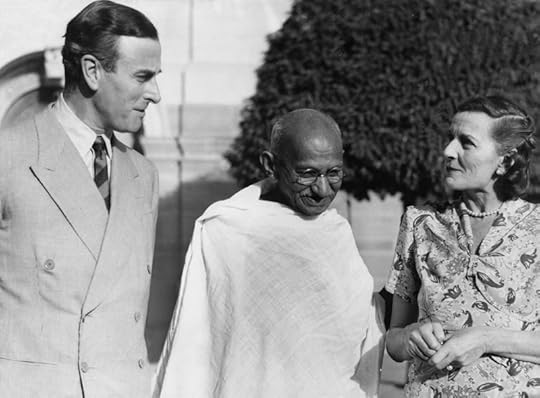 Lord and Lady Mountbatten with you-know-who. In his presence they were both
Lord and Lady Mountbatten with you-know-who. In his presence they were both on their best behavior.
But if Nehru and Dorothy Norman ever trysted and kept it secret, it was a miracle of amorous discretion. So perhaps their relationship was simply friendship. She had no official position, didn’t represent her country, didn’t criticize him for his nonaligned position in the Cold War, so in her presence he could be candid and relaxed, and even, as in the headstand stunt, a mischievous boy showing off for his girl. But his influence on her was deep, and in time she edited a collection of his writings, Nehru, the First Sixty Years, that was published in two volumes in 1965.
Dorothy Norman went on to more “encounters” – the artists Willem de Kooning and Jackson Pollock, the Protestant theologian Paul Tillich, the photographer Henri Cartier-Bresson and his wife, others – and turned away from politics and social welfare concerns to develop a keen interest in myth and symbolism. Her memoir ends with a moving account of her mother telling her at last, and fervently, how much she loved her, and then dying in her arms.
Norman does not chronicle her later years, and the memoir, with a single exception, offers only photographs of her in her youth, several of them by Stieglitz. And afterward? She wrote, she edited, she gave her collection of Stieglitz photographs to the Philadelphia Museum of Art. As for her personal life, I know only what the in-house editor at Harcourt told me, how in her later years she surrounded herself with a circle of friends, all male homosexuals, among them the Japanese American artist and landscape architect Isamu Noguchi. (I have found no evidence online that Noguchi was gay, though his father was.) Once her youthful looks had faded, was this Norman’s refuge, among men who could offer, not romance or sex, but friendship? Even as she worked on her memoir, she told the editor it could never be published while Georgia O’Keeffe was alive. O’Keeffe died in 1986; the memoir was published in 1987 with a dedication “To Edward, my first love.” Dorothy Norman died in 1997 at age 92.
What is one to make of this woman who knew everyone? Limousine liberal, do-gooder, dilettante – she can be stuck with all these labels, but I think it would be unfair. She served the great – Stieglitz, Nehru, others -- without herself attaining greatness. She never worked a day in her life, in the sense of a salary-paying job, but she was constantly busy, never idle. A doer, she made things happen. What was it that let her bond so easily with others? Her beauty, her charm, her intelligence. And from that bonding came results: books, articles, exhibitions, food for a starving India, her biography of Stieglitz, her collection of Nehru’s writings, the Alfred Stieglitz Center in Philadelphia. And if her later turn toward myth and symbolism gets a bit vaporous and “New Agey,” that is probably the case with most Western followers of the great traditions, which for deep understanding require a focused lifelong commitment that few of us can offer.
Time and again Dorothy Norman was in just the right place at just the right time. When her friend the renowned photographer Edward Steichen was putting together a photographic exhibition, The Family of Man, to be presented at the Museum of Modern Art in 1955 -- an exhibition that would show the oneness of human hopes, fears, and preoccupations among all races, nations, and cultures throughout the world, and that would be the culmination of his career -- he found that the photos by themselves seemed lifeless, they needed captions; in desperation he appealed to her. Seeing a print of the first photo, showing a reflection of light on earth and water, she at once proposed a line from the opening of Genesis, “And God said, Let there be light.” Seeing another print of lovers in an intimate embrace, she suggested the closing lines of Joyce’s Ulysses, with Molly Bloom’s rapturous “Yes!” For other photos she drew on the Bible, Greek tragedy, Saint-John Perse, the Bhagavad Gita, other sources. When the exhibition opened, it was a great success, following which it toured the world for eight years and was seen by over nine million people. Decidedly, the right person in the right place at the right time. Her memoir too, evoking timeless myths, ends with an inspiring “Yes.”
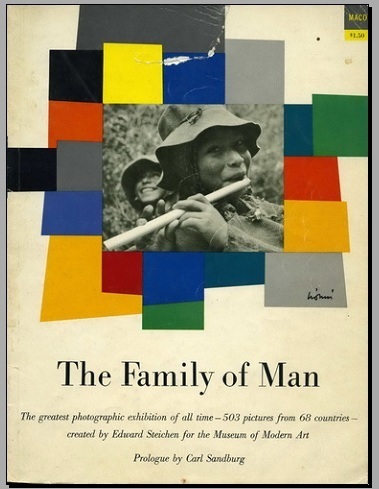 Front page of the exhibition catalog.
Front page of the exhibition catalog.Dinales
Source note: The sources for this post are the same as those mentioned in the previous post: the 1977 interview and Norman’s Encounters: A Memoir (Harcourt Brace Jovanovich, 1987).
Are the Yahoos coming? I do not mean this blog to be political, but occasionally I feel compelled to voice an opinion. A New York Times article of September 29 reported that, among the Republican nominees likely to be elected to the House of Representatives in November, are some who have made these statements:
· Single parenthood should be reclassified as child abuse.· Four “blood moons” will herald world-changing events.· Islam is not a religion but a “complete geopolitical structure” unworthy of tax exemption.· Hillary Clinton is the Antichrist.· Equal-pay legislation should be opposed, because money is more important to men than to women.· Evolution is a lie from the pit of hell.
No further comment is necessary.
Coming soon: The bishop whose splendor of presence almost eclipsed comedian Milton Berle, who was known as Mr. Television. And to round things out, I’ll toss in merry optimism and the Power of Positive Thinking. Also: Peoria vs. New York or, Who will get the archiepiscopal remains?
© 2014 Clifford Browder
Published on October 12, 2014 04:28
October 5, 2014
147. Dorothy Norman and Alfred Stieglitz
She is 23, dark-haired, beautiful, with big brown eyes, and wants to know about art. He is 64 -- old enough to be her father and then some -- with deep-set, piercing eyes framed by glasses, his hair and mustache gray and bristling, and he knows all about art. She encounters him in a shabby little gallery on Park Avenue where he holds forth daily in a resonant voice, telling visitors that the world of our dreams is more real than the world that exists, and that art, like all love, is rooted in heartache. He makes the first satisfying statements about art she has ever heard and speaks with total conviction; she is entranced.
The young woman goes back to the little gallery again and again, listens to the man talk to others about art, learns his name, writes down afterward what he has said. The paintings shown there fascinate her, as does the man himself. Finally she speaks to him, talks with him about art. His words pour forth, don’t explain anything, but change something indefinable inside her. Though the paintings exhibited are available for purchase, he isn’t selling them, just talking about them, about art. He says the very things about art that she has been waiting to hear from someone knowledgeable and mature. Finally she writes him a breathless letter, says she can’t keep away from the gallery, loves what he is doing there, would like to help him do it. Answering her letter in bold black strokes of a pen that are almost chilling in their beauty, he tells her to feel free to come to the gallery and ask all the questions she likes. She does. She talks with him, looks at his photographs, feels his attraction like a great force of nature.
One day they find themselves alone in the gallery; a tense silence, as they look at each other intently.
“I want to say something to you,” she whispers.
“Say it,” he says. His voice is encouraging, but she holds back. “Say it.” “I can’t.”
“Say it.”
She makes a great effort. “I love you.”
His face softens. “I know – come here.”
He kisses her. Their lives are changed forever.
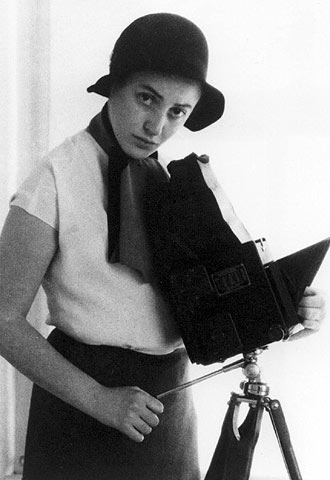 Dorothy Norman. Stieglitz encouraged
Dorothy Norman. Stieglitz encouragedher to become a photographer. She is Dorothy Norman, a young woman from an affluent Jewish family in Philadelphia who is now living in New York. He is Alfred Stieglitz, a renowned photographer and fervent advocate of contemporary American art. The year is 1928. She has met the man who, more than any other, will profoundly influence her life. There is just one problem: they are both married, but not to each other, and feel a loyalty to their respective spouses. And she has just given birth to her first child. So begins a long, fervent, but complicated relationship that could have happened only in New York.
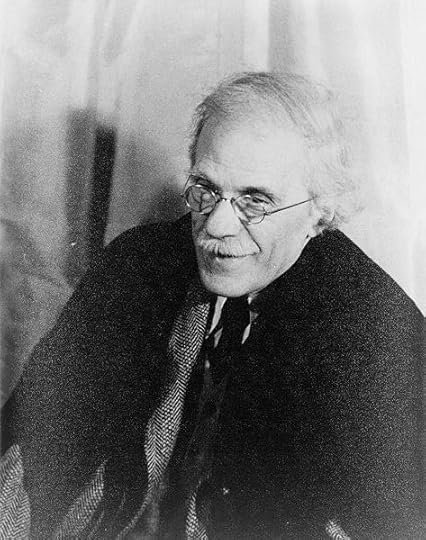 Alfred Stieglitz, 1935.
Alfred Stieglitz, 1935.Born Dorothy Stecker to an affluent Jewish family in Philadelphia, she grew up surrounded by privileges that puzzled, then annoyed her. At a party in New York in 1924 she met Edward Norman, the son of a wealthy Sears Roebuck heir and they fell in love; overcoming opposition from both families, they married in 1925; she was 19, he was 25. On the wedding night he was dismayed, then angry, to learn that her parents had told her nothing about sex. When he entered her, she felt agonizing pain, bled, sobbed; in the morning, apologies on both sides, tenderness, assurances that all would be well.
They moved into an apartment on East 52ndStreet in New York, lived well but not lavishly, traveled abroad, became involved in progressive causes, advocated reform, not revolution. Though given at times to outbursts of anger, her husband was intelligent, knowledgeable, idealistic; she admired him greatly. She did volunteer work for the ACLU, visited art galleries and then, at the Intimate Gallery on Park Avenue, she met Alfred Stieglitz.
A strange but passionate relationship developed. Stieglitz was wise, informed, mature, yet possessed a youthful vigor and sense of fullness about life unlike anyone she had ever known. She didn’t see in him a father but a lover and mentor; they wrote, phoned, and saw each other daily, experienced physical love that she found breathtaking, almost frightening, in its intensity.
And the spouses? She still loved her husband, but in a different way, had no thought of divorcing him. They lived, vacationed, and traveled together, but the relationship must have been altered since he surely knew of her affair with Stieglitz almost from the start. How did he feel about a wife who, to be sexually and emotionally fulfilled, needed both a husband and a lover? Candid as her autobiography can be, of this she says almost nothing. She and Edward shared much, and yet …
 Georgia O'Keeffe, circa 1920.
Georgia O'Keeffe, circa 1920.Stieglitz had good taste. As for Stieglitz, he was married to the artist Georgia O’Keeffe, 23 years his junior, and likewise had no thought of divorce. He had discovered her years before, a talented young artist who had yet to make a name for herself, and had divorced his first wife to marry her and promote her work. To judge from Dorothy Norman’s memoir, one might think that O’Keeffe and Stieglitz were by now estranged, but O’Keeffe’s biographer, Hunter Drohojowska-Philp, tells it differently: O’Keeffe was heartbroken by her husband’s open affair with Norman but endured it until 1933, when she suffered a nervous breakdown that hospitalized her for two months. After that there was indeed estrangement, as more and more she pursued her art in New Mexico, far from Stieglitz and Norman.
A personal note: I first heard of Dorothy Norman when, as a freelance editor in the early 1980s, I was hired by Harcourt Brace Jovanovich to edit the manuscript of her memoir, Encounters. I worked with an in-house editor from whom I learned certain things about Norman not mentioned in the memoir; I will introduce them when and if relevant.
With Stieglitz’s help, as well as her own beauty, intelligence, and charm, Dorothy Norman expanded her horizons and deepened her understanding of art. At a party she met the artist John Marin, whose work she particularly esteemed, and the sculptor Gaston Lachaise, and became good friends with both. She met Georgia O’Keeffe, a handsome woman strikingly dressed in black with a touch of white, though for obvious reasons the acquaintance could only go so far. In 1929, when Stieglitz learned that the Intimate Gallery must vacate the premises, she and O’Keefe and others helped finance a new and better gallery, An American Place, at 509 Madison Avenue. There Stieglitz, who disapproved of the recently founded Museum of Modern Art’s emphasis on “French Old Masters” (meaning Impressionists and Post-Impressionists), could continue to exhibit and promote American art. At his insistence the walls were painted white and gray and were unadorned, so as to convey an atmosphere of austerity, nor was it listed in the phone book. But right from the first – even in the wake of the Crash – people flocked to it.
Among those she came to know at this time, whether at An American Place or elsewhere, were the poet Hart Crane and the young theater director Harold Clurman. Clurman took to her at once and expounded excitedly on the American theater’s need for direction, for a philosophy of life, and she helped raise funds so he and his colleagues could found the Group Theatre and put these ideas into practice. Through Stieglitz and her own social connections she was now well on her way to becoming the self-assured and knowledgeable young woman who knew everyone.
And her husband? She continued to admire his honesty, intelligence, and integrity, but realized with great regret that they were growing differently, and apart. Further endangering their relationship were his irrational outbursts of anger and her increased awareness that he was psychologically disturbed. Concern for their two children and a persistent devotion sustained their marriage, and every year they summered together in Woods Hole, Massachusetts. But their youthful hopes and dreams were fading fast.
Stieglitz photographed her repeatedly and taught her to become a photographer herself. And in 1932 he arranged the publication of her poetry, which she herself feared was too immature. In her memoir she tells how she sent the volume to her British friend Dorothy Brett, an artist and onetime associate of D.H. Lawrence living in Taos, New Mexico, and was amazed by Brett’s enthusiastic response, which proclaimed the poems “beautiful” and “incorruptible.” Yet in the manuscript I edited, as I recall, it went somewhat differently. Yes, Brett praised the poems, but only after Norman waited anxiously for a response and finally queried Brett about her reaction, thus putting Brett in an awkward position, torn between candor and the claims of friendship. Was Brett’s response the response of friendship or was she truly impressed? And wasn’t Norman a bit of a dabbler here? Serious poets work at their craft for years. Norman didn’t pursue her poetry, having other and stronger claims on her attention. Throughout her life she had so many interests, and went in so many directions, that she risked – perhaps unfairly -- the label of dilettante.
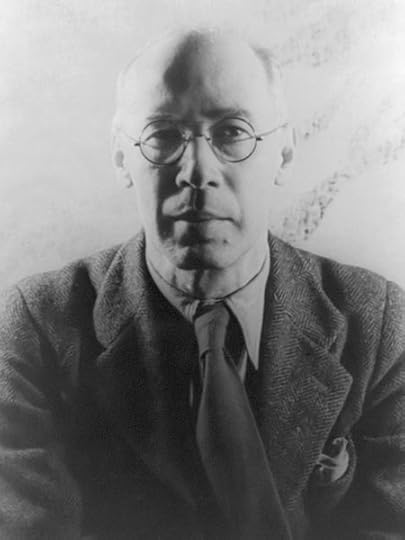 Henry Miller in 1940. Returning to
Henry Miller in 1940. Returning to America, he was shocked when someone
talking with him used a four-letter word. Indeed, she had so many commitments and knew so many people, only a few of her “encounters” can be chronicled here. She helped Henry Miller financially so he could return from Europe and, when she met him, was surprised to find, not the sensual, rather ferocious man she anticipated, but a modest and proper individual who resembled a preacher. Through him she met his inamorata the author Anaïs Nin, who struck her as almost nunlike in her simple gray coat and hat, though her small mouth was carefully painted, and her mascaraed eyes stared at Norman ecstatically. Norman soon realized that Nin was slowly drifting apart from her wealthy banker husband, just as she was drifting apart from Edward.
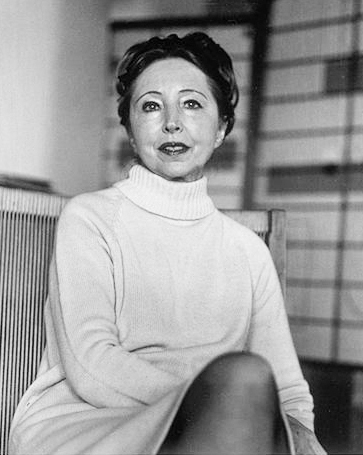 Anaïs Nin in the 1970s. Not so different from
Anaïs Nin in the 1970s. Not so different fromthe younger woman described by Norman.
Elsa Dorfman In 1937 she began publishing Twice a Year, a journal of literature and art, which she herself financed; well-known writers, including European expatriates soon displaced by the war, appeared on its pages: Sherwood Anderson, Richard Wright, Thomas Mann, Bertolt Brecht, and later Sartre and Camus. Then in 1942 she began writing a column for the New York Post entitled “A World to Live In,” commenting on social welfare issues and politics. The column would continue for seven years, and she became involved in city and state politics, even to the point of being offered political positions and a chance to run for Congress, invitations that she always turned down, knowing that politics and the compromises it entailed were not for her.
Neither she nor her husband liked living ostentatiously. Their Park Avenue apartment building was designed to look imposing, with a gloomy and pretentious entrance hall, a uniformed doorman and elevator man, and an apartment with ugly windows, false moldings, and sconces with pointed light bulbs absurdly imitating candles. So the Normans engaged a large real estate firm to find them an unrenovated house no wider than twenty feet, with no tall buildings in front or back, the rear facing south, and not near an elevated or bus line, since they both slept badly. And it should not be above 79thStreet or below 68th Street on the East Side of Manhattan. Rather strict requirements for a couple in search of something simple, but they found it: a Victorian brownstone at 124 East 70th Street, nineteen feet wide with a high front stoop, in dire need of renovation. Months of work followed as the front of the building was moved forward, the rear slanted to admit the most daylight possible, and the interior reorganized imaginatively to create spare, clean lines throughout. Finally, in 1941, they moved in. The building was voted one of the two best new buildings of the time; photographs of it were exhibited at the Museum of Modern Art; and architecture students gathered outside to sketch it and often asked to be shown through. Simplicity had been achieved.
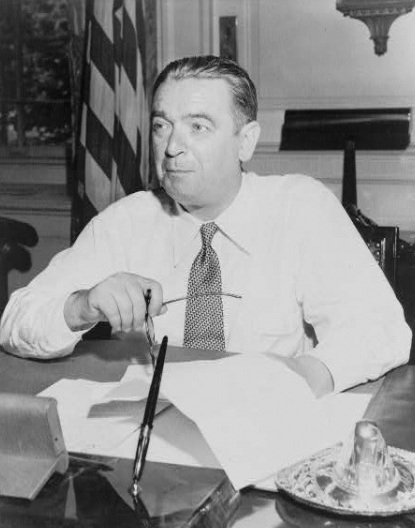 Mayor William O'Dwyer. Not handsome,
Mayor William O'Dwyer. Not handsome,but gifted with a great sense of humor. Joining the newly established Liberal Party in 1944, she found herself involved in debates as to who the party should endorse for mayor. The feeling against William O’Dwyer, a former Brooklyn district attorney, was strong, since he had Tammany backing, but she decided to interview him for her column. Since he was off in seclusion in California planning his strategy, she made a long-distance call and, to her surprise, reached the man himself. A candid conversation followed, and an invitation to meet him in New York. He proved to be a ruddy-faced man, well built but hardly handsome, with an Irish sense of humor, and she urged him to run for mayor and be a great one. Leaving the Liberal Party, she supported O’Dwyer and was delighted when he won. From then on she called him daily at 8:30 a.m. on a private line and had talks with him that were often hilarious. He read passages from Yeats to her, then they talked politics; he listened to her suggestions about health and hospitals, day-care centers, delinquency, whatever. Knowing she was “in” with the mayor, people played up to her, hoped for an introduction. “Of course you’re having an affair,” a journalist friend told her. “Everyone knows it.” Which made her furious, since she never saw O’Dwyer alone, was most definitely not having an affair with Hizzoner, and had even declined positions that he and others offered her.
In July 1946, while summering in Woods Hole, she got a phone call from a friend informing her that Stieglitz had had a stroke and was in a hospital, and she must come at once; O’Keeffe was in the Southwest. Her husband was kind and understanding, had no objection to her going. She rushed back to New York, went to the hospital, found him in a coma but with a look of peace on his face; later she broke down, wept. O’Keeffe arrived the next day, their paths didn’t cross; Norman made no further attempt to see him, knew that he was dead. Harold Clurman phoned her in sympathy, found her a typewriter so she could do a brief obit for the Post, then accompanied her to a restaurant for dinner. They were sitting at a table outside when suddenly, quite by chance, Eleanor Roosevelt walked by with a companion and saw her. The former First Lady approached and greeted her graciously and in a warm and cordial voice asked what she was doing in New York in the miserable summer heat.
“I’m here because a great friend, Alfred Stieglitz, has died. I’ve come down for his funeral.”
Eleanor Roosevelt looked at her, perplexed, not having the slightest idea who Stieglitz was. Norman wept, uttered a perfunctory wish that Mrs. Roosevelt was well.
Did Norman and O’Keeffe encounter each other at the funeral? Her memoir doesn’t say, but one suspects that they maintained a discreet distance. Back in Woods Hole, having read again the last note Stieglitz had sent her the day before he died, she wrote a poem that she could show to know one.
Stieglitz’s death, however shattering, did not keep her from being Dorothy Norman, the woman who knew everyone. Her “encounters” continued: Jean-Paul Sartre and Simone de Beauvoir when they visited this country, then Albert Camus. The African-American author Richard Wright, whose dignity and quiet demeanor and eloquence impressed her. D.T. Suzuki, whose course in Zen Buddhism she took at Columbia, and whom she came to know and learn from afterward. Osbert Sitwell and his sister Edith, the latter with honey-colored hair and a head like a great regal bird; following a reading there, she drove them around Florida in a rented car, Sir Osbert hiding behind a thinly iridescent veil that he could at will turn into a cold and solid wall, and Dr. Edith, garbed heavily in the Florida heat, distantly polite, but dropping an iced curtain before anyone who aroused her ire. Yet another acquaintance was Natacha Rambova, the former wife of Rudolph Valentino, a handsome but fragile woman who monologued to her about the great traditions, about theosophy,symbolism, and myth, and who became a personal friend and mentor.
With Stieglitz out of her life, did she have affairs with other men? “Dorothy Norman was a very beautiful woman,” the in-house editor at Harcourt told me. “All these men were her lovers.” I at the time assumed O’Dwyer was one of them, but on rereading the memoir am convinced that he was not. Many other men are mentioned in the memoir, without her admitting intimacy.
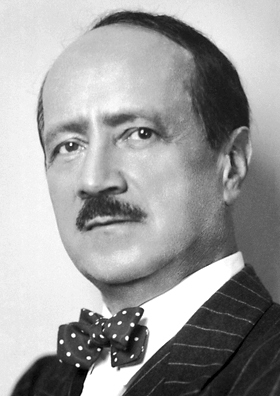 Saint-John Perse in1960, the year he
Saint-John Perse in1960, the year hewon the Nobel Prize for Literature.
Nobel Foundation One candidate is the French poet Saint-John Perse (Alexis Saint-Léger Léger), whom she met after the war in Washington, where he was then living. At their first meeting he gazed at her fiercely and then, after a moment of silence, asked, “When did you last cry?” Immediately she felt a hypnotic power overwhelming her and told him how on the plane returning from India she had wept for the poverty and misery she had seen there. Later she photographed him in his apartment. As the friendship developed, they talked about his wartime opposition to the Vichy government, his decision to remain in the U.S. after the war, his poetry, their mutual interest in India. His eloquence and depth of perception, his rich vocabulary, his poetry entranced her. After one of their meetings, she left behind a pair of gloves. He later told her their presence was “not like a farewell, but plumage shed in full flight.” A poet, certainly. A lover? Probably.
And Jawaharlal Nehru, the charismatic first prime minister of India? That’s a story in itself, rather complicated, to be covered in next week’s post.
Source note: For information about Dorothy Norman I am indebted to her 1977 interview with William McNaught for the Archives of American Art, available online, and her memoir, Encounters: A Memoir, published by Harcourt Brace Jovanovich in 1987.
© 2014 Clifford Browder
Published on October 05, 2014 05:17
September 28, 2014
146. Ralph Fasanella
Oil on canvas, 40 by 70 inches. In the center, a pyramid of newspapers in the form of a giant A rises into the sky with headlines where one catches the words NIXON and EISENHOWER and YANKS DEFEAT REDS and FBI RAIDS and REDS and ROSENBERGS EXECUTED AS ATOM SPIES. In the sky, on the left two signs outlined in red blazon SAVE, and a red cross topped by a blue SAVE floats on the far right, suggesting another meaning, this one religious, of “SAVE.” At the lower left mourners follow a coffin or coffins in an open vehicle, a huge crane lowers two coffins into the ground, and a flowered gravesite bears over it the words SAVE THE ROSENBERGS. In the center foreground two eyes stare from wall. At the lower right uniformed guards guard a grilled gateway in front of what seems to be one or several courthouses, the Washington Monument, and what may be the seated Lincoln of the Lincoln Memorial, while in the background looms the dome of the U.S. Capitol. All of which only begins to convey the cluttered urban complexity and rich panoramic detail of a work named “McCarthy Press.”
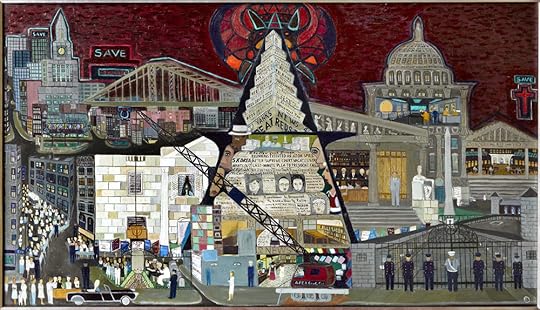 McCarthy Press, 1958.
McCarthy Press, 1958.American Folk Art Museum
To try to understand this work is like coping with the symbolic details in a landscape by Pieter Bruegel the Elder; every detail has intention, if only one can decipher it. (For Bruegel, see post #70, “Me and the Seven Deadly Sins,” with the Flemish artist’s illustrations of the sins.) The artist of “McCarthy Press” is obviously very political and of the Left, but no realist, since his canvas is a jumble of locales and rich in symbols. And no portraitist either, since his small human figures have only the barest suggestion of facial features. So are you confused? But maybe just a bit intrigued? So was I, when I first encountered him. Welcome to the art of Ralph Fasanella.
To understand “McCarthy Press,” one needs to know something of the mood of the country in the early 1950s, when Dwight D. Eisenhower was the newly elected President, and Richard Nixon his Vice-President, in the first Republican administration in some twenty years. Looming large was Senator Joseph McCarthy, Republican from Wisconsin, who had convinced many Americans that their government was riddled with Communist spies and sympathizers, opinions echoed by much of the press at the time. It was in this atmosphere that Julius and Ethel Rosenberg were accused of passing information about the atomic bomb to Soviet Russia – in those early days of the Cold War, the worst possible accusation against anyone. Convicted in 1951 after a very controversial trial, they were executed in the electric chair at Sing Sing in New York State on June 19, 1953. Many, including Fasanella, believed in their innocence, though today it seems likely that Julius, but not his wife, was guilty. “McCarthy Press” is Fasanella’s comment on the Red Scare of the time and the execution of the Rosenbergs. The giant A formed by the pyramid of newspapers suggests the atom bomb, and the eyes staring from the wall imply government surveillance of its citizens.
A personal note: At the time of the Rosenberg execution I was a student in Lyons, France. At that remove I couldn’t follow the trial closely and so had no strong opinion about their guilt or innocence, but some of my French friends, of the Left but not Communists, were convinced of their innocence and, when news came of their execution, attended a memorial service by way of protest. Which goes to show that even in provincial France the Rosenberg trial was followed with interest and provoked controversy. As for McCarthy, whose alcoholism was not yet known to the public, I had to reassure a German friend that McCarthy was not to Eisenhower as Hitler had been to President Hindenburg of Germany; he was vastly relieved to learn that McCarthy was not about to take over the nation.
I discovered Ralph Fasanella recently when, expecting quilts and purses and weathervanes, I went for the first time to the American Folk Art Museum opposite Lincoln Center and found the regular collection closed off, and Fasanella’s works on display instead – a rare exhibition, some of the works from private collections, that had come here from the Smithsonian in Washington. By the time I finished looking at his art, I was hooked in a very special way by this artist whom I had never even heard of before – no more than several of my friends, quite knowledgeable about American art but totally unaware of Fasanella. So who was he?
Ralph Fasanella (1914-1997) was the third of six children of Italian immigrants living in the Bronx and then in Greenwich Village, his father an iceman delivering ice to residences, and his mother a worker in a dress shop. Young Fasanella helped his father deliver ice from his horse-drawn wagon, tough work that involved lugging heavy chunks of ice on his shoulder from the cart to the house. His mother, an anti-fascist and trade union activist, instilled in him a strong sense of social justice and political awareness that would be with him all his life. After his father, disillusioned with America, abandoned his family and returned to Italy in the 1920s, young Ralph was sent twice to Catholic reform schools for truancy and running away from home, an experience that reinforced his deep hatred of authority. Leaving school with only a sixth-grade education, during the Depression he worked as a garment worker and truck driver in New York, then for a year served as a volunteer in the Abraham Lincoln Brigade, fighting for the Spanish republic against the fascist forces of Francisco Franco.
Returning to the U.S., he worked as a union organizer in the city, and in 1944, as an exercise to ease the pain of arthritis in his fingers, took up painting at age 30. Thus was born a self-taught artist. So taken with painting was he, that he quit his union work to paint full time, while operating a filling station on the side to support himself. The outsized canvasses he produced were never intended for the homes of rich collectors, but for union meeting halls, and that was where they were exhibited for years to come. This being the time of Abstract Expressionism, the art world dismissed him as a self-taught primitive – a Grandma Moses with a leftist twist -- and since it was also the era of McCarthyism, dealers and galleries blacklisted him because of his known leftist sympathies.
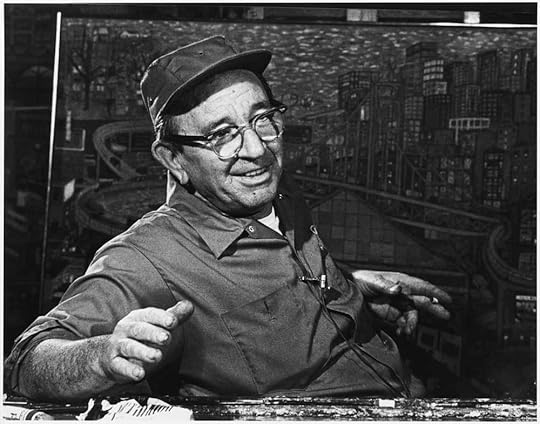 Fasanella in 1970.
Fasanella in 1970.American Folk Art Museum
Then, in 1972, he appeared on the cover of New York magazine, which hailed him as the best primitive painter since Grandma Moses, and suddenly he became famous nationwide. He was interviewed, he was written about, he was exhibited, he sold. For a while. He could stop pumping gas in his filling station, but he insisted he was still the regular working-class guy he’d always been. “I think the kids are much brighter today,” he said in a 1973 interview, “but they also have less experience. They don’t know what a union is all about, they’ve never worked with their hands. Without knowing what labor’s about a man’s not worth a damn cent. But a laborer has to know how to read books. It takes a blending of the two things to become a full person.” And Ralph Fasanella was certainly a full person, a reader and artist with dirty fingernails, a pock-marked face, and a sense of humor who could bond instantly with workers.
His 5-foot by 10-foot painting “Lawrence 1912: The Great Strike” (1978) was purchased by donations from fifteen unions and given to Congress, where it hung for years in the Rayburn Office Building hearing room of the House Subcommittee on Labor and Education. But when the 1994 elections brought a new Republican majority to the House of Representatives, the word “Labor” was eliminated from the committee’s name, and a Republican staffer had Fasanella’s painting, the only labor painting in the Capitol, removed from the hearing room and returned to its owners. In 1995, on the other hand, his “Subway Riders” (1950) was installed in the Fifth Avenue and 53rd Street subway station in Manhattan. Toward the end of his long life his social and political messages fell out of favor, and with them his art. But with his death in 1997, his work began to be reappraised yet again, as witnessed by the current exhibit at the Folk Art Museum, which will run until November 30. I urge all who can to go see it and then judge for themselves. Personally, I think his work well worth the effort; it is a revelation to me, a whole new aspect of the American art scene that I had hardly been aware of – or appreciative of – until now. Here are a few of the works exhibited, with my layman’s reaction and commentary. But to really grasp the details that are so significant, you need to see his paintings full size as displayed at the museum. If you can enlarge them as presented here, by all means do so.
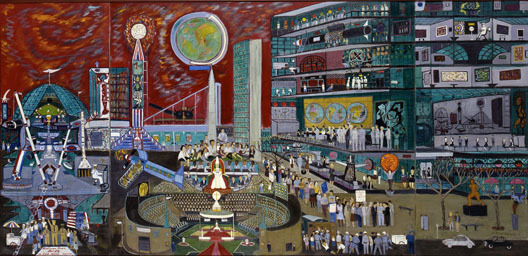 Modern Times (1966)
Modern Times (1966)American Folk Art Museum
In “Modern Times” (1966) he contrasts humanistic values with the cold technological world of our present and our future. In the center foreground we see the 1965 visit of Pope Paul VI, who attended a Mass in Yankee Stadium; perhaps the Pope is presented as representing ethical and spiritual values, but he also symbolizes authority, to which, in all its forms, Fasanella was vehemently opposed. In the lower left, soldiers come home from the war, greeted by the words WELCOME HOME BOYS; nearby is a stack of flag-draped coffins. But in the center foreground, to the right of the stadium, war protesters burn their draft cards or are dragged into a police van. In the center left background a black helicopter gunship is seen against a red sky, while near it a rocket amusement ride looms, with a giant baseball bursting from its cone. On the far right, museumgoers garbed in black and grey visit a museum full of abstract art, and the technological means of war are displayed. Well-groomed ladies lunch inside the museum, while a statue outside shows a worker holding up the world. And these comments barely scratch the surface of this multilayered, complex work, many of whose details I cannot decipher.
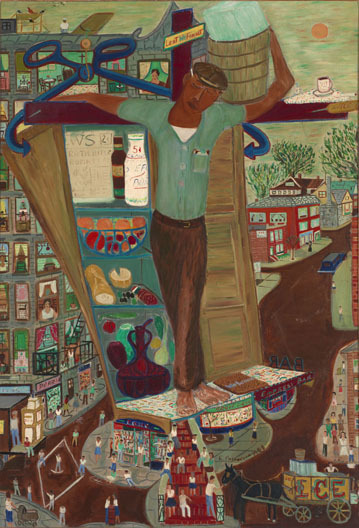 Iceman Crucified #4 (1958)
Iceman Crucified #4 (1958)Smithsonian American Art Museum
Less enigmatic is a series of paintings named “Iceman Crucified” honoring his father, who worked as an iceman delivering ice to homes in Greenwich Village. In “Iceman Crucified #4” (1958) the figure of his father dominates, standing against a cross topped by giant ice tongs (instead of a crown of thorns) and holding a large bucket of ice on his shoulder. At the top of the cross appear the words “Lest We Forget,” indicating Fasanella’s determination to remember and honor his origins. On the cross to the right are a cup of coffee and a cigarette, suggesting a brief respite from work. Also present, I’m told, is an alarm clock set at 6:50, a reminder of when the iceman had to be at work, though I confess I have yet to make it out. In the lower right is an ice cart minus its iceman driver, while in the lower left a refrigerator is being delivered, marking the end of the iceman profession.
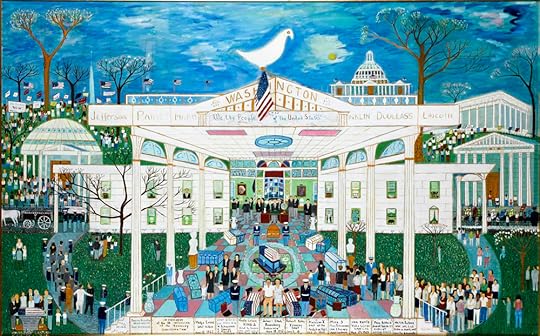 American Heritage (1974)
American Heritage (1974)American Folk Art Museum
In “American Heritage” (1974) the White House, topped by an outsized white dove of peace, an American flag, and the word WASHINGTON and “We the People of the United States,” opens up to reveal its interior. Inside are a number of coffins, some of them flag-draped, suggesting, as Fasanella explained in an interview, the memorable deaths of recent years: the Kennedys, Malcolm X, civil rights workers in the South, the students at Kent State, and all who were killed while fighting for an ideal. Standing next to their ironically flag-draped coffins in the center foreground are Julius and Ethel Rosenberg, whose fate obviously haunted the artist.
Fasanella wasn’t interested in what critics said of his art, which was addressed not to them but to working people and their allies. But of course the critics had their say. Having at first dismissed him as a primitive, from 1972 on they began taking him seriously, praising his bold images and vibrant colors. His ability to present individual scenes and yet unify them in a single coherent image was recognized. His masses of somewhat stiff and static human figures, their features barely indicated, could be criticized; he rarely did portraits, rarely tried to individualize his figures. Some critics have insisted that he expressed nostalgia for a past more imaginary than real, but others have hotly defended his championing of the struggles of the working class, his feel for their griefs and joys and hopes – a view that I personally think justified.
For a closing note, I can’t do better than quote a memorable saying of Fasanella’s:
Remember who you are.Remember where you came from.Don’t forget the past.Change the world.
Coming soon: A woman who knew everybody from Eleanor Roosevelt to Mayor Bill O'Dwyer, not to mention Nehru and Alfred Stieglitz, but who kept her distance from Georgia O'Keeffe, and for good reason. Plus other topics cooking on a low flame.
© 2014 Clifford Browder
Published on September 28, 2014 04:34
September 21, 2014
145. New York Brownstones
First, the material. What is it?
A soft sandstone quarried in northern New Jersey and Connecticut and shipped by barge to New York City to be used in the construction of row houses. It served chiefly to cover the houses’ brick façades; brownstone residences, like the Greek Revival houses before them, were basically built with bricks.
When were brownstones built?
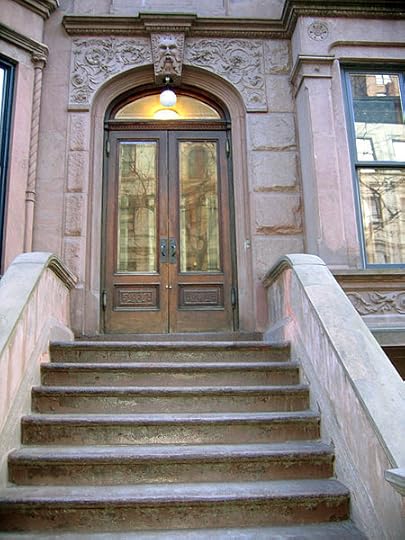 An Upper West Side brownstone, used in
An Upper West Side brownstone, used inthe TV series A Nero Wolfe Mystery.
WFinch
In Manhattan, in the 1850s and 1860s, when the Italianate style was in vogue. By the 1880s brownstones were being built on the Upper West Side of Manhattan, where Queen Anne and Renaissance styles replaced the earlier and simpler Italianate. And throughout the rest of the century brownstones were being built in various neighborhoods of Brooklyn, their façades adorned with bay windows and balconies.
 Brooklyn brownstones, late nineteenth century.
Brooklyn brownstones, late nineteenth century.
Why?
The growing affluent middle class wanted residences more impressive in appearance than ordinary brick, and more durable than wood. Also brownstone, being soft, could be shaped and sculpted so as to provide decorative detail on the façades. People fell in love with brownstone, which took on a deep chocolate color with time; they thought it was elegant, distinctive, genteel, and “Romantic” (Romanticism and broody moodiness were “in”). The brownstone residence became a symbol of bourgeois comfort and status. (A side thought: If chocolate is Romantic, would vanilla be Classical?)
Italianate style
The popular Italianate style brownstone, first developed in Great Britain, included these features:
· A steep front stoop, thought to be stately and elegant, though it took energy to negotiate it; ascending, one supposedly left the hurly-burly of street and sidewalk life behind and accessed something nobler and more genteel.· An impressive front doorway with double doors topped by a rounded arch and a projecting hood and flanked by pilasters, informing all who managed to get up the stoop – formal callers, ministers, doctors, lawyers, and such -- that this was a residence of wealth and refinement.· A basement door under the stoop to accommodate the lower orders: deliverymen, tradesmen, servants, and other social inferiors.· A basement (sometimes called a garden floor, since its rear door led out to the garden) and four stories.· Tall first-floor windows.· Handsome cast-iron railings for stoops and area fences.· A flat roof with a boldly protruding cornice (the horizontal projection at the top of the building), providing a sharp limit to the structure’s monumental rise.· By the 1860s, a steeply sloping mansard roof installed above the cornice, a hot new architectural feature imported from Second Empire France, adding a fifth story with dormer windows.· A parlor floor with three parlors, each one with sliding doors opening into the next, the first two often serving as a single deep parlor and the last as a dining room, the food coming up from the kitchen below by that marvelous new invention, the dumbwaiter.· Folding wooden shutters to shield the parlor floor from the view of nosy passers-by who, looking up from the sidewalk, could at best see only a patch of ceiling and maybe a chandelier (I know, because I’ve tried).· Ornate decorations sculpted in the brownstone, foliage and cutesy little animals and strange mythological faces and scrolls and curlicues.
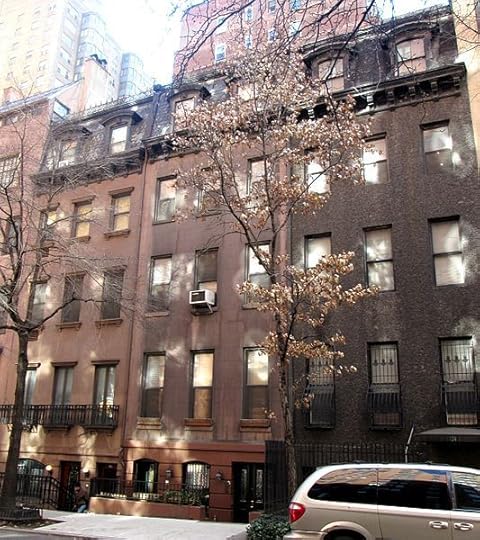 Brownstones with mansard roof, East 37th Street, Manhattan, late 1860s.
Brownstones with mansard roof, East 37th Street, Manhattan, late 1860s.Beyond My Ken
What amenities did they have?
· Heat: A coal-burning furnace in the cellar, generating hot air that was conducted in pipes to the lower floors, and coal-burning fireplaces for the top floors where servants resided. Coal provided a steady heat far superior to what wood-burning fireplaces had once provided.
· Lighting: Gaslight for the lower floors, kerosene lamps for the upper floors with the servants’ rooms. Oil was discovered in Pennsylvania in 1859, making kerosene readily available, since it is obtained by distilling petroleum. The kerosene lamp then replaced the whale-oil lamp.
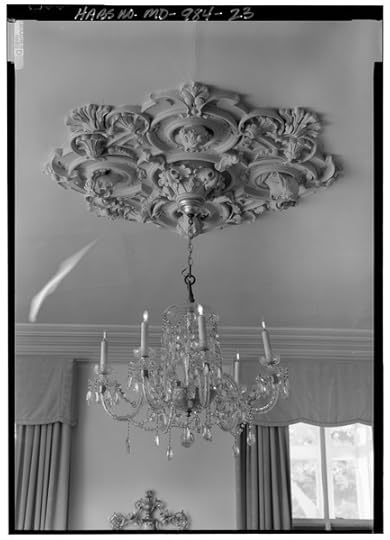 Chandelier suspended from ceiling medallion.
Chandelier suspended from ceiling medallion.Gaslight chandeliers lit the parlors.
· Running water: Since 1842, when the city began getting clean water from upstate reservoirs, anyone who paid the water tax could have running water in their homes. The result: indoor plumbing providing plentiful water for cooking and dishwashing, for shower baths and tub baths whenever you liked, and for that miracle of modern miracles, the flush toilet, replacing primitive improvisations that I don’t have the heart to describe. From 1842 on, soap sales presumably went up, while perfume sales declined. All over Manhattan a joyous chorus rose of showering burgers reveling in the miracle of running water. No wonder nineteenth-century Americans believed in Progress. But tenement dwellers still had to rely on the well in the yard and tote their water in.
What was a brownstone parlor like?
Volumes could be written … and have been. The Victorian parlor was the shrine and sanctuary of the affluent middle class, its best stab at propriety, calm, and culture, its chance to put its best foot forward. Plush and velvet abounded, Brussels carpets ran from wall to wall, elegant little spindle chairs dared intruding males to risk their bulk upon them, and antimacassars pinned to the backs of overstuffed sofas and armchairs protected the sacred upholstery from masculine locks reeking of Macassar oil. More ornamental now than essential, white marble fireplaces gave off a lustrous sheen, and over them the mantel featured a large bronze or marble clock backed by a gilt-framed mirror rising five or six feet, or even eight feet all the way to the ceiling.
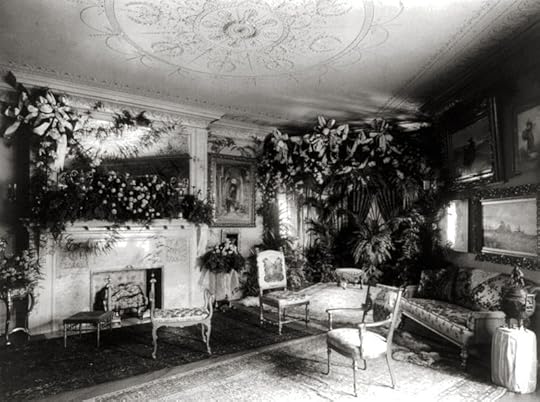 This parlor was heavy on floral adornments. Some of them settled for a few pressed rose petals.
This parlor was heavy on floral adornments. Some of them settled for a few pressed rose petals.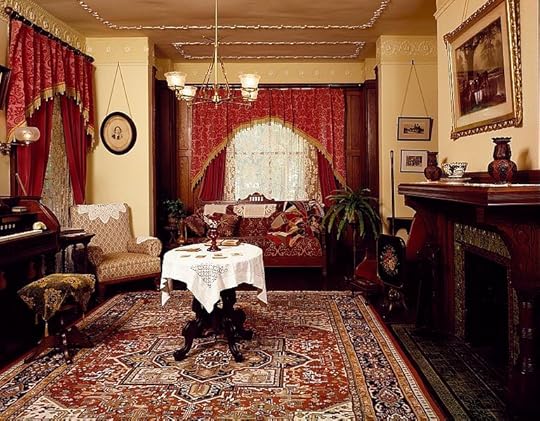 This one features fringed curtains, plus antimacassars on the armchair and sofa.
This one features fringed curtains, plus antimacassars on the armchair and sofa.From the walls ancestors in gilt frames stared dourly down, or perhaps, more benignly but grandly, the master and mistress of the house. Displayed prominently was that inevitable symbol of bourgeois refinement, the pianoforte, its gleaming ivory keys awaiting the deft fingerings, at family gatherings, of the young ladies of the household, nervously anxious to reveal their accomplishments. Cluttered on whatnots were assorted bibelots, framed locks of the dear departed, and stuffed birds under glass. A cool gloom prevailed, and by day shades or drapes were drawn, and shutters closed, lest sunlight smite the damask. Here, in an atmosphere scented with cedar and cinnamon and lavender from pomanders and potpourris, the mistress of the house presided; children were to be seen but not heard; and males of all ages were on their best behavior, never quite at ease, their conversation scrubbed and disciplined. Loud talk was discouraged, arguments banished, smoking forbidden; gentility reigned supreme.
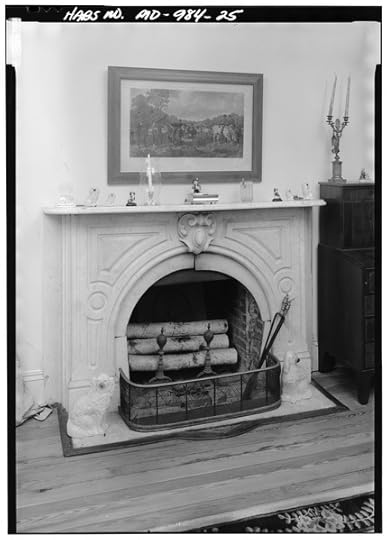 The white marble fireplace could dominate the room. The logs would be
The white marble fireplace could dominate the room. The logs would befor show; hot air from the furnace usually heated the parlor.
And the other rooms?
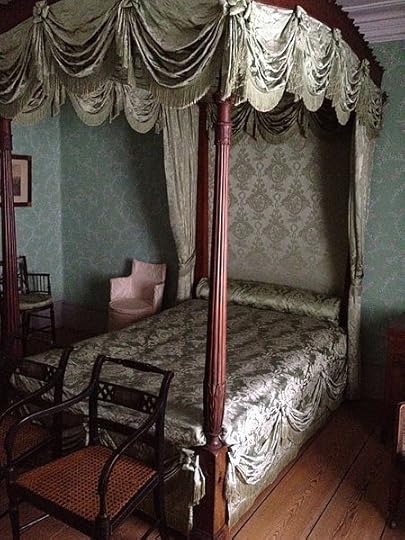 Sleeping in a bed like this, you had to feel important.
Sleeping in a bed like this, you had to feel important.TwdkThe dining room, the back parlor on the parlor floor, matched the front parlor in elegance and refinement; here, attended by servants, the family could dine in state. On the second floor the front room was often a sitting room or library where the family could gather casually and relax, without the formality required by the parlor; it was the forerunner of today’s living room. (The parlor, on the other hand, has no equivalent today; it disappeared with the Victorian mores that created it.) The back room on the second floor was the parents’ bedroom, featuring an imposing four-poster and having access to a bathroom that, in some instances, was regal in splendor, with a marble or mahogany washstand with gleaming silver-plated faucets, a commode of polished porcelain, and a polished metal or marble tub; the air was scented with fragrant powders and soaps.
The third and fourth floors had bedrooms for the children. At the very top, often including a fifth floor under a mansard roof, there were small rooms for the servants, who usually had to do without running water, gaslight, and central heating, relying instead (as their masters had a generation earlier) on coal in the fireplace, a wash basin with a pitcher, and the indignity of the chamber pot, and for their weekly bath, a tub or sink in the kitchen. (In some brownstones, even so, heat from the coal-burning furnace in the basement reached even the topmost floors.)
With five floors and up to sixteen rooms, a brownstone afforded privacy to parents, children, and servants, but at the cost of endless climbing and descending stairs. Brownstones were not for the weak of limb, though an ailing master or mistress might install themselves, bed and all, on the parlor floor and receive callers there in state.
Are there any old brownstones left on Fifth Avenue?
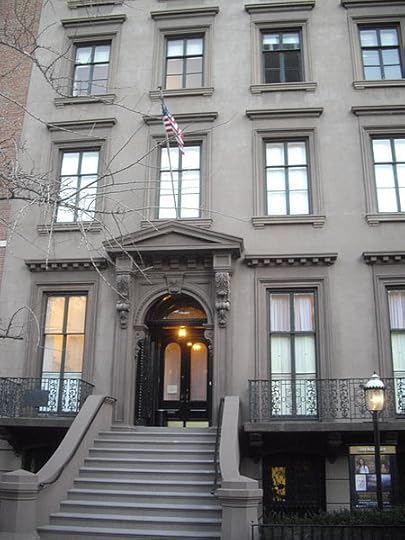 DmadeoTo my knowledge just one, at 47 Fifth Avenue, between East 11th and 12th Streets in the West Village. Built in 1853 as a residence for Irad Hawley, the first president of the Pennsylvania Coal Company, and his wife, it showed the world that the Hawleys and their coal business were doing quite well. And how could they not be? Coal was in great demand for heating interiors, and for powering both the many palace steamboats gliding smoothly over the Hudson, and their screechy upstart rivals, the railroads. The building’s exterior still has the classic features of the early Italianate brownstone: an imposing stoop rising to an entrance with double doors flanked by pilasters and topped by a rounded arch and a projecting hood; tall parlor-floor windows; and four floors topped by a cornice. The stoop, however, isn’t centered, having two parlor-floor windows on the right, and one on the left, with balconies. Inside, some vestiges of the old brownstone remain, notably the two front parlors joined into one, each with a white marble fireplace with foliage and figures in relief, and a chandelier suspended from a ceiling rosette; between the parlors are four Corinthian columns with elaborately carved capitals. One can well imagine the Hawleys receiving guests in front of such fireplaces aglow with coal, under chandeliers ablaze with gaslight. Since 1917 the building has housed the Salmagundi Club, a nonprofit center for artists and collectors that offers art classes and exhibitions.
DmadeoTo my knowledge just one, at 47 Fifth Avenue, between East 11th and 12th Streets in the West Village. Built in 1853 as a residence for Irad Hawley, the first president of the Pennsylvania Coal Company, and his wife, it showed the world that the Hawleys and their coal business were doing quite well. And how could they not be? Coal was in great demand for heating interiors, and for powering both the many palace steamboats gliding smoothly over the Hudson, and their screechy upstart rivals, the railroads. The building’s exterior still has the classic features of the early Italianate brownstone: an imposing stoop rising to an entrance with double doors flanked by pilasters and topped by a rounded arch and a projecting hood; tall parlor-floor windows; and four floors topped by a cornice. The stoop, however, isn’t centered, having two parlor-floor windows on the right, and one on the left, with balconies. Inside, some vestiges of the old brownstone remain, notably the two front parlors joined into one, each with a white marble fireplace with foliage and figures in relief, and a chandelier suspended from a ceiling rosette; between the parlors are four Corinthian columns with elaborately carved capitals. One can well imagine the Hawleys receiving guests in front of such fireplaces aglow with coal, under chandeliers ablaze with gaslight. Since 1917 the building has housed the Salmagundi Club, a nonprofit center for artists and collectors that offers art classes and exhibitions.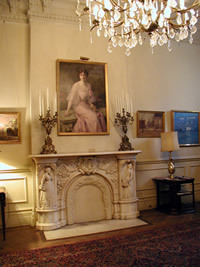 The parlor fireplace.
The parlor fireplace.Salmagundi Club
Who maintained a brownstone?
Not the owners. Yes, they paid bills for the necessary services and labored to keep up appearances, but the real work was done by the servants, sometimes black, more often Irish. In the mid-nineteenth century an affluent New York family had at least 6, probably 7: a cook, a waiter, a parlor maid, an upstairs maid, a laundress, a houseman, and probably a coachman; ordinary middle-class families made do with 3: cook, waiter, and maid. The servants cooked, washed, scrubbed, dusted, polished, stoked the furnace, removed cinders and ash from the fireplaces and resupplied them with coals, trimmed the wicks and cleaned the chimneys of the kerosene lamps, and toted the trash out to the curb for collection. After a hard day’s work they would trudge wearily upstairs to their ill-heated rooms on the top floors, perhaps lighting their way with a candle until they lit a kerosene lamp in their room. If there was a garden in back, that needed tending too, unless a gardener was hired. The coachman would be lodged separately, usually upstairs in the coach house, a small two-story structure on a nearby side street where coach and horses were lodged. (Ironically, though certainly not luxury housing at the time, coach houses today are sought after by tenants willing to pay a high rent.)
Were there freestanding brownstone houses also?
Not many, given the soaring land values in Manhattan; except for the very wealthy, row houses were the rule. But there was one freestanding brownstone mansion that managed to be the most scandalous residence in the city: a handsome four-story structure on the northeast corner of Fifth Avenue and 52nd Street with a steep stoop rising to a monumental entrance, its recessed doors flanked by pilasters and topped by a protruding ornamental hood. In 1864 a lavish housewarming revealed the interior to guests and the press: three vast ground-floor parlors in bronze and gold with yellow satin hangings; enormous mirrors with mosaic gilding; ceilings adorned with costly frescoes by Italian artists; and an abundance of paintings, curios, bronzes and statuettes, candelabras, and ornamental clocks. Even the upper floors were on display: the second floor, with the hosts’ sumptuous master bedroom; the third, with servants’ rooms with Brussels carpets and mahogany, and a picture gallery; and the fourth, with a billiard room and ballroom.
 The Lohman residence. Driving up Fifth Avenue to Central Park, you couldn't miss it.
The Lohman residence. Driving up Fifth Avenue to Central Park, you couldn't miss it.Courtesy of the Museum of the City of New York
Definitely not on conspicuous display was the silver plate bearing the engraved word OFFICE that later appeared on a gate in the railing at 1 East 52nd Street, just around the corner from the main entrance. There, steps descended to a basement side entrance where heavily veiled women were seen furtively coming and going by day. This was the office of the mistress of the mansion, Mrs. Charles Lohman, better known as Madame Restell, the town’s most notorious – and successful – abortionist. That she should reside so sumptuously on the city’s most fashionable avenue only two blocks from the rising walls of Saint Patrick’s Cathedral, and just across the street from the spacious grounds of the (O irony!) Catholic Orphan Asylum, was an enduring scandal of the Gilded Age, constantly whetted by visitors innocently asking who lived in that palatial brownstone that drew every eye. Imagining dire happenings in its shadowy interior, knowledgeable New Yorkers labeled it a palace of death.
What became of brownstones?
In Manhattan, taste changed. What looked fashionably dark and “Romantic” in the 1850s came to look like cold chocolate, dingy and depressing. When the Vanderbilts and Astors and other moneyed clans built their mansions on the Upper Fifth Avenue from 1880 on, they preferred brighter limestone residences in the French-chateau style. But brownstones continued to be built on the Upper West Side in Manhattan, and in many neighborhoods in Brooklyn, where they sprouted balconies and porches and bay windows alien to the formal and rather severe earlier Italianate style. By the end of the nineteenth century, however, people were complaining about soft brownstone crumbling and cracking and flaking, which further doomed brownstone construction. Since then, many brownstone façades have been replaced with brown cement-based masonry, a cheaper alternative. Still, brownstones had a certain aura that persisted, and the second half of the twentieth century saw a brownstone renovation movement take hold in older cities throughout the East, often with impressive results.
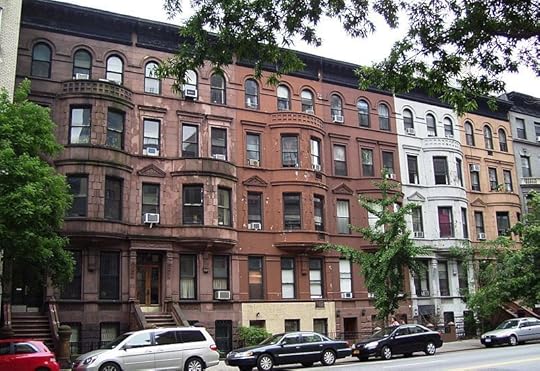 Six brownstone row houses on West 96th Street, built in 1891-92 in the Renaissance Revival style.
Six brownstone row houses on West 96th Street, built in 1891-92 in the Renaissance Revival style.Beyond My Ken
What happened to the brownstone quarries?
The last New Jersey quarries ceased operation in the 1930s, owing to lack of demand. When the quarries in Portland, Connecticut, were flooded by a 1936 storm and proved impossible to drain, they shut down. In the mid-1990s a geologist named Mike Meehan reopened the ground on the edge of the Connecticut quarries and sold brownstone for historic and restoration projects and lavish private homes. But in 2012 his quarry, the last of its kind in the region, finally shut its doors, to the great regret of preservationists trying to match the brownstone of old residences; it marked the end of an era. But in his retirement Meehan, a true lover of brownstone, planned to use some of the remaining little slabs to make birdbaths and benches, not to sell but for the fun of it.
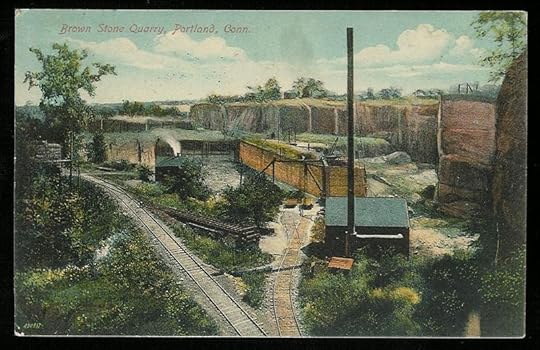 Quarries in Portland, Connecticut, in 1911.
Quarries in Portland, Connecticut, in 1911.A tale of two cities: Prague and New York: A friend recently told me two contrasting stories. His aunt was on a bus tour in the Czech Republic when suddenly she had symptoms of a serious heart problem. Alerted, the authorities sent a nurse from Prague to take her back there and see her into a hospital. After several days in the hospital she was ready to fly back, as planned, to Holland. The nurse accompanied her to the airport, went through security with her, and saw her onto the plane. Only when the nurse saw his aunt comfortably settled in her seat did she leave her. My friend’s comment: the Czechs treated her wonderfully! His other story: A friend of his was dying of AIDS. He left a New York hospital, had a relapse, wanted to return to the hospital, where he was known and his medical records were available. No, the rule was that he had to go to the nearest hospital, where he was unknown. Admitted there, he showed the staff his living will, refusing various kinds of treatment and resuscitation procedures. The staff ignored the living will completely and gave him all kinds of unnecessary and futile treatments, so as to run up the bill. Finally, when they trundled in some monster machine for yet another procedure, my friend objected. “Are you a relative?” they asked him. “No,” he said, “but his mother is downstairs.” Alerted, the mother refused the treatment emphatically, and the staff did not insist. His friend then died more or less peacefully. All of which says a lot about Czech vs. American health care.
Coming soon: Ralph Fasanella and his take on Joe McCarthy, the Rosenbergs, Watergate, and a crucified iceman. In the offing (in no particular order): Wall Street cheats; Dorothy Norman, the woman who knew everyone (Nehru stood on his head for her -- literally); and maybe two holy men who were no strangers to publicity and who wanted to make you feel good: a media-savvy and very photogenic archbishop whose remains are now in archiepiscopal dispute, and the Power of Positive Thinking.
© 2014 Clifford Browder
Published on September 21, 2014 04:45
September 14, 2014
144. Smells of New York
If you ask New Yorkers what their city smells like, their immediate and vigorous answer will include such items as these:
· Garbage· Dog poop· Urine· Sweat (from other people, as in the subway)· Chemical vapors· Gas· Mold· Grilled meat from block parties· Diesel fumes· Smells from halal and hot dog vendors
 The Staten Island Landfill, where garbage from Manhattan used to be brought by barge, to be dumped at the outer edge of the landfill. The landfill has since been closed, but imagine the aroma wafted by breeze to the nostrils of Staten Islanders. No wonder they wanted to secede!
The Staten Island Landfill, where garbage from Manhattan used to be brought by barge, to be dumped at the outer edge of the landfill. The landfill has since been closed, but imagine the aroma wafted by breeze to the nostrils of Staten Islanders. No wonder they wanted to secede!Summer, of course, is the worst season for unpleasant smells, since the heat “cooks” the garbage and other undesirable deposits.
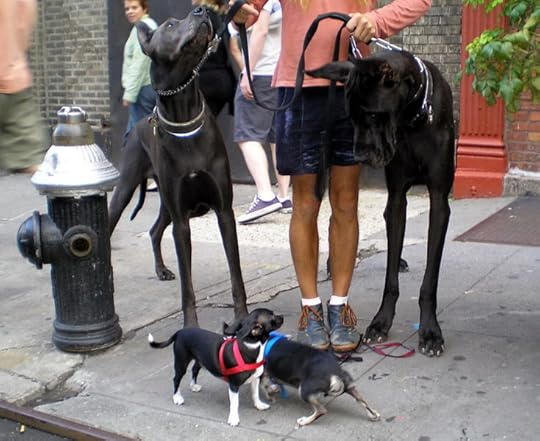 Man's best friend, but ...
Man's best friend, but ...David Shankbone
To these I’ll add another provided by a friend who lived for many years in Brooklyn: the sickly sweet smell of mice dying in the walls after the landlord has spread poison, a smell that lasts from ten days to two weeks until their little bodies desiccate. For my friend this is quintessential olfactory New York.
And if you press New Yorkers for some positive olfactory experiences, they’ll think a minute and perhaps come up with
· Toasted bagels· Fruit tree blossoms in spring· The aroma from a pizzeria, with hints of yeasty bread, cheese, and sausage· In Brooklyn, the aroma of freshly roasted coffee emanating from several little wholesale coffee companies hidden in brick buildings· Italian sausage cooking at stands at the annual Feast of San Gennaro in Little Italy
 Sausage stand at the Feast of San Gennaro.
Sausage stand at the Feast of San Gennaro.Nightscream Obviously, the negative experiences outweigh the positive ones. And New Yorkers complain: 13,054 odor complaints to 311 (the city’s complaint and information number) over the last four years, or about eight gripes per thousand residents. And to judge by the number of complaints, Manhattan is the smelliest borough by far. Unless, of course, it simply has the most residents willing to lodge a complaint, which may well be the case.
To the smells already mentioned, I’ll provide a few more, both pleasant and unpleasant, from my own experience.
· The aroma of fresh baked bread emanating from some invisible bakery nearby, especially delicious on a cold winter night· On the street, the acrid smell of fresh asphalt when a pothole has just been filled· Roasted chestnuts from sidewalk stands in the fall· Hot air from dry cleaners, sometimes with a chemical edge to it that is probably toxic· A smell of rubble, plaster, and splintered wood heaped in dumpsters outside residences or shops undergoing renovation, their interiors, when glimpsed from the sidewalk, totally gutted and devastated· Exhaust fumes from buses as they pull away from the curb· In parks, the cloyingly sweet summer fragrance of Canada thistle and milkweed flowers, the soothing scent of a wild mint and, in the fall, a rich cidery tang from rotting apples scattered on the ground under apple trees· When pavement is being replaced, a smell of wet cement
 Canada thistle, a fragrance that intoxicates.
Canada thistle, a fragrance that intoxicates.SriMesh
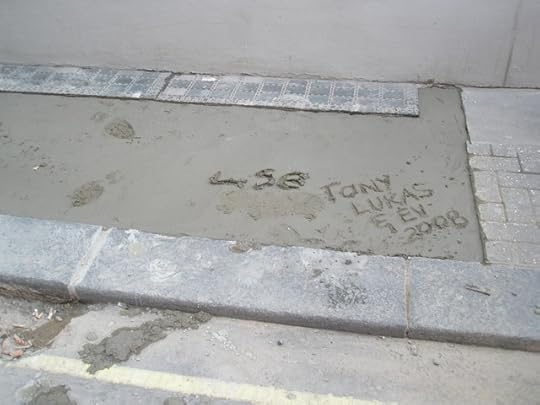 Wet cement plus graffiti. The photographer wonders: vandalism
Wet cement plus graffiti. The photographer wonders: vandalismor history in the making? Will it one day be another Pompeii?
Basher Eyre
Yet many smells escape me, for my sniffer isn’t the most efficient. So let’s consult an expert. A neuroscientist in town last spring to register the smells of a New York morning stood outside Grand Central Station during the morning rush hour and reported the following:
· A toasted onion bagel· The “briny, salty, fishy” smell of the East River, delivered by the breeze· A “really powdery, moist, kind of sweet smell” from steam rising from underground
And inside the terminal, where shops abound:
· High-end coffee (instead of the cheap coffee of the 1980s)· After-shave· Toothpaste· Disinfectant from trains· Brown-black shoe polish· Cheap air freshener from a Town Car coming from a man’s suit
And outside again, going toward Bryant Park:
· Hot dogs· Doughnuts· The “sour, tangy, birdy smell of pigeons”· Cigar smoke
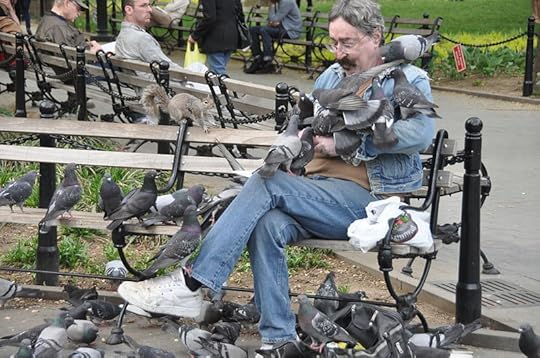 They're hard to get away from, but you don't have to feed them.
They're hard to get away from, but you don't have to feed them.JoeinQueens There speaks a true expert, a scientist of smell. And recently, on a so-called Smellwalk in Brooklyn, participants who sniffed trash cans and doorways and even trees reported such smells as these:
· Garlic· Acqua di Gio cologne from a European tourist· Recently chewed gum in a trash can· Cigarette smoke· A marijuana joint· Blended wheatgrass
But when the tour organizer, who has led walks to create Smellmaps of various European cities, was asked for the characteristic smell of New York, she reflected a moment, then announced, “A warm, musty smell that comes from the cellar.” Not, I confess, a smell that I have experienced.
Every so often an unusual smell – unusual for the city – arrives to spice our urban living. In April of this year New Yorkers awoke to a heady smell of windborne smoke whose source was easily located: a brush fire in New Jersey a good hundred miles away. And periodically, from 2005 to 2009, a mysterious maple-syrup-like aroma visited our nostrils, its source an enigma. Finally, in 2009, Mayor Bloomberg announced triumphantly that the probable source had been detected: fragrance-processing plants in New Jersey making use of fenugreek seed, a spice employed in this country more for industrial than culinary purposes. Not an unpleasant odor, but many New Yorkers were of the opinion that New Jersey should keep its smells to itself. (I shan’t chronicle the smells of northeastern New Jersey, which combines extensive marshland, a pig farm, and an oil refinery.)
The city of New York, then, teems with smells, some offensive and some not, though New Yorkers tend to emphasize the stinks. For perspective, let’s have a look at nineteenth-century New York and see how it compares.
By all accounts, nineteenth-century New York stank. Sidewalks were often piled high with kitchen slops, cinders, coal dust, broken cobblestones, and dumped merchandise, while the streets were rich in horse manure that, in rain, became a thick, ankle-deep slime that smelled like bad eggs dissolved in ammonia. And when dry weather prevailed, the thick traffic on streets like Broadway ground the manure into dust that blew up from the pavement as a piercing powder that covered the clothes of passersby, invaded their nostrils, stung their eyes, and even blew into their residences to assail the furniture and upholstery. And in any weather there might be a dead horse in the street. Only the arrival of the horseless carriage relieved the city of these pestilential smells.
And that wasn’t all. The middle class lived in handsome, well-scrubbed brownstones on Fifth and Madison Avenues and their side streets, well removed from the seedy West Side of the 30s and 40s, which housed the gas facilities that provided them with gaslight, and such urban amenities as stables, distilleries, hog pens, slaughterhouses, tanneries, swill milk dairies, breweries, and a varnish factory, all of which emitted their distinctive aromas. But if the wind was from the west, this symphony of smells could find its way eastward to the fashionable shops and restaurants and hotels on Broadway and to the brownstone neighborhoods as well.
So how did people cope? By holding handkerchiefs to their nose. Ladies, if they had to face these affronts to gentility, sprinkled flower scents on their handkerchiefs, behind their ears, and on perfumed sachets that they carried with them. But the best solution was to retreat into the sanctity of the home and guard it with vigilance, and so arose the cult of the parlor.
The parlor was the shrine and sanctuary of the affluent middle class, its refuge from the nasty smells – and nasty sounds and sights – of the turbulent city outside. It was a feast of velvet and brocade, a stage for the gleaming white keys of a pianoforte, an assemblage of bibelots on whatnots, its shaded sanctum scented with cedar and lavender and rose. Here one received callers of note, prominent among them the minister of one’s church. In such an atmosphere one could forget for a while the reek of manure-laden streets, a whiff of hog pens and distilleries, and clouds of eye-stinging dust. (More on the parlor in a future post.)
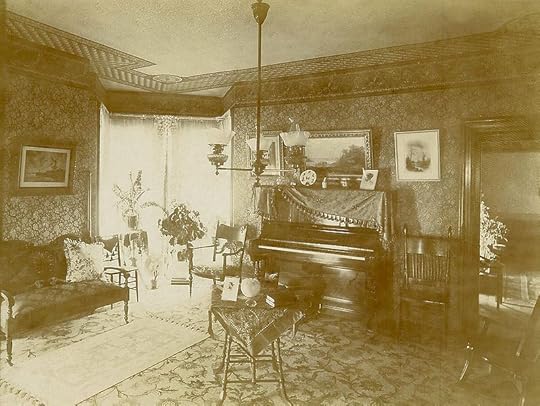
Another feature of nineteenth-century New York was a section of the city where no lady ever set foot, except to take a ferry or steamship: the waterfront. But that waterfront offered a unique assortment of smells, as its docks welcomed ships from every major port in the world. A stroll there brought to one’s nostrils an amazing sequence of aromas: fresh pineapple from a stand; sawn wood from a steam engine cutting up firewood; gas smells from a riverfront gas works; garbage smells from a mountain of refuse fed continually by a line of carts, while ragpickers crawled over the trash to scavenge bits of food, or shoes or scraps of metal to sell to the junk man; smelly hides being unloaded from a ship; hogsheads of tobacco ready to be shipped abroad; hints of tea, palm oil, and strange spicy aromas from crates and barrels being unloaded on docks serving the China, Australian, and African trade; a fine mist of flour as a grain elevator delivered flour from a spout to be weighed, bagged, and carted off; a smell of coal as workmen grimy with coal dust and sweat unloaded coal from a canal boat; and a smell of brine from an oyster market, and fish smells from a fish market. Such a roster of smells reveals the tremendous activity of the waterfront in those days, and what the city has lost commercially since, albeit with an improvement in relative tranquility and waterfront recreation.
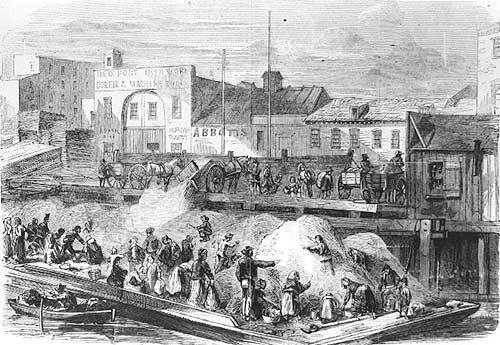 Ragpickers scavenging in a mountain of trash, 1866.
Ragpickers scavenging in a mountain of trash, 1866.Let’s return now to the smells of today and end by mentioning two less than enticing aromas imposed on us by those longtime friends of mine, the trees. An import from China, the gingko (Gingko biloba) is a common shade tree here with distinctive fan-shaped leaves that turn yellow in the fall. At the same time it bears its fruit, tawny or yellowish little balls that litter the ground, the smell of whose fleshy pulp has been likened to dog poop, an odiferous cheese, rancid butter, or vomit. If one endures the smell and if, wearing disposable gloves to prevent irritation to the hands, one removes the pulp, inside is a greenish nut that some consider tasty. Having endured the stink, cracked the shell, and fought through to the nut, I once tried it but found it uninteresting, not worth the ordeal required to harvest it. Furthermore, if consumed in quantity, it can be toxic. In the city the fallen nuts get crushed by pedestrians on the sidewalk, and people wonder where that offensive smell comes from. Yet up in the North End of Central Park I have seen Chinese ladies gathering the fruit on the ground, whether for culinary or medicinal purposes, I do not know, since Chinese tradition sanctions both. My conclusion: leave the gingko fruit to the Chinese ladies, who probably know what to do with it; only the hardy should mess with it.
 Fruit of the gingko.
Fruit of the gingko.Wolfgang H. Wögerer
And if, strolling the city’s streets in spring, you should detect an odor that some have described as a mix of (ahem!) semen and rotting fish, though others just say semen, don’t assume some oversexed teenager has been active in the vicinity. Instead, look around and see if you don’t find one or several trees bearing quantities of little five-petaled white flowers that, if sniffed, prove to be the source of this wanton odor. Such is the callery pear (Pyrus calleryana), another import from Asia and the second commonest shade tree in the city, which puzzled me for years until I finally consulted the city and they identified it. I knew it only as a mystery tree with white flowers in the spring; I had never stuck my schnozzola into its blossoms to discover this surprising -- and for some, offensive – odor.
 Charming to look at ... until you sniff.
Charming to look at ... until you sniff.Alpsdake Finally, to end on a more positive note, I’ll mention McNulty’s at 109 Christopher Street (yes, that street) in the West Village, which boasts of being the country’s leading purveyor of choice coffees and rare teas. Entering, you encounter the aura of a bygone era with sacks of coffee and chests of tea with obscure markings from faraway lands all around you, and even scales reminiscent of the nineteenth century. Above all, one’s sniffer is intoxicated by the mix of aromas: oolong and herbal and black and green teas from India and Kenya and Sri Lanka and China, and coffees from Indonesia and Hawaii and Jamaica and Costa Rica and Columbia and Uganda and Ethiopia and Yemen and – but why go on? A rare symphony of aromas, unique, unforgettable.
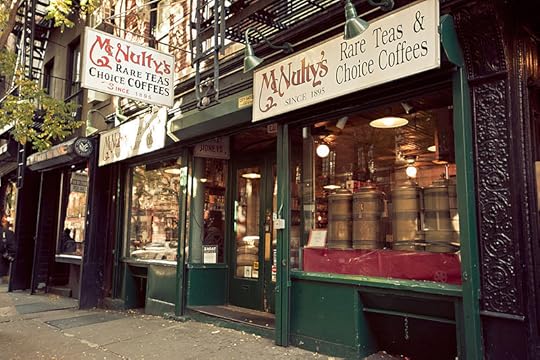 Alphachef
AlphachefMy Gauge of Estimation: Just devised, it’s self-explanatory. Very subjective; feel free to challenge or supplement it.
The Gauge of Estimation
My rating of the living creatures known to me; a purely personal judgment, riddled with prejudices, flexible, subject to change.
I admire (from most to much)
1. Activist American nuns (they’ve even gone to jail for their convictions)2. Nurses3. Dalai Lama4. Honeybees (industrious, well organized, essential as pollinators)5. Doctors Without Borders (they have guts)6. Teachers (minus a few bad apples; overscrutinized, underpaid)7. Greenpeace (they have guts too)8. Senator Bernie Sanders of Vermont9. Senator Elizabeth Warren of Massachusetts10.Jimmy Carter (a better career post-White House)11.Immigrants (we need them; they work hard)12.Organic farmers (ditto)13.Spiders (they have a bad press, eat flies and mosquitoes; I never kill them)14.Investigative journalists (fewer now, when we need more of them)15.Salvation Army16.Painted buntings (our most beautiful songbird, but I’ve never seen one)17.Michelle Obama (I’d vote for her)18.Snakes (U.S.; beautiful, harmless unless provoked)19.Labor unions (to counterbalance corporations)20.Bald eagles, falcons, hawks (fiercely beautiful)21.NAMBLA (North American Man/Boy Love Association) (they fight a lonely fight, plead only for consensual relationships)22.Apple (in spite of its faults; endlessly inventive, and I love my Mac)
Pending (I haven’t decided, may need more info; from hopeful to less hopeful)
1. Pope Francis2. Mayor de Blasio3. Chelsea (on her own at last; we’ll see)4. Poets (poor things, so sensitive and so alone)5. FBI (at least, not as bad as the CIA)6. New York’s Finest (we need them, but …)7. Bill (brilliant but at times stupid -- Monica, etc.)8. Hillary (wants so much to be President)
I dislike (from much to most)
1. Sarah Palin (but keep her around for laughs)2. Blue jays (the bullies of the bird world)3. Worms (they serve a purpose in the biosphere, but…)4. Putin5. Mosquitoes (they love my blood)6. Governor Andrew Cuomo (eliminated his own Commission to Investigate Corruption; in my eyes, a hack politician)7. Cockroaches 8. Justice Clarence Thomas (came up the hard way, but I believe Anita Hill)9. Fundamentalists (they commit the sin of simplicity)10. Bankers (the big guys, not the small fry; manipulative, irresponsible)11. CIA (because…)12. Terrorists (of all stripes; takes in more people than you may think)13. Koch Brothers (one is bad enough, but two…!)14. The tobacco industry (at least their lies are known)15. The Tea Party crowd (partisanship first, the nation last)16. NRA (National Rifle Association) (even nine-year-olds should shoot)17. ALEC (American Legislative Exchange Council) (secretive, far-reaching; too often they write the laws our states adopt)
I hold in the utmost contempt (from much to most)
1. Bedbugs 2. Telemarketers (recorded messages, incessant, stupid)3. Dick Cheney (his finger in every dirty pie)4. Bullies5. Monsanto (the company I love to hate; GMOs, etc., and their ex-execs infest our government!)6. Vermin 7. Congress (except for a few good souls, two of them noted above)8. New York State Legislature (the lowest you can get)
Coming soon: Brownstone and brownstones (the material, the residence, the Victorian parlor). Then: Ralph Fasanella and his take on Joe McCarthy, the Rosenbergs, the Cold War, Vietnam, a Crucified Iceman, and so much more.
© 2014 Clifford Browder
Published on September 14, 2014 05:13
September 7, 2014
143. Panhandlers and Hustlers of New York
Recently the New York Post announced with a blatant headline Cops bust Iron-Man, Spider-Man and Elmo in Times Square. So who are these creatures, what are they doing in Times Square, and why are they being arrested? Elmo, as seen in
 Elmo, on the left, waits to get a hug from
Elmo, on the left, waits to get a hug from Dr. Jill Biden and First Lady Michelle Obama.Times Square, is a shaggy red monster with black dots of eyes and an orange nose, inspired by a Muppet in the children’s TV show Sesame Street. Iron Man is an armor-clad figure, his face completely encased in a helmet, inspired by a comic-book superhero of that name who fights crime. The third arrestee, Spider Man, stands tall in a torso-hugging red and blue garb adorned with what looks like a spider web, his head completely masked, a sinister figure likewise based on a popular comic-book superhero.
So what is this trio of performers – for such they are – doing in the Crossroads of the World? Charming children, posing with them for photos, and urging – or sometimes pressuring – their parents to fork over tips. Tourists flock to Times Square, and so do these fee-for-service entrepreneurs, hoping to scratch out a living by playing to the hordes of out-of-towners.
 Iron Man
Iron Mangreyloch
And why are these impersonators of characters beloved of children being arrested for disorderly conduct? Because some of the Elmos, Iron Men, and Spider Men – and Mickey and Minnie Mouses (or should I say “Mice”?), Cookie Monsters, Spongebob Squarepantses, Batmen, Supermen, and Statues of Liberty – turn aggressive and even abusive if the tourists don’t pay; one Elmo even emitted obscenities and anti-Semitic tirades before being hustled away, to the relief of other, more genteel Elmos. Exasperated by these developments, New York’s Finest have started passing out fliers advising tourists that the tips are strictly optional, and are now following up by arresting the comic-book and Muppet copycats for blocking or harassing pedestrians.
 Spider Man
Spider Mangreyloch And who inhabit these sweaty costumes? Mostly recent Hispanic immigrants, males 40 and under, who in this novel way are trying to make ends meet. Which raises a First Amendment issue, and has prompted some of the impersonators and their allies to start organizing and taking photos and videos of the cops in action. New Yorkers haven’t heard the last of this; editorials, arguments pro and con, and proposed legislation are sure to follow.
The shaggy red Elmos and other characters insist that they aren’t panhandlers, and perhaps they aren’t, since they offer a kind of service – photograph me with your smiling kids and you’ll treasure the photo for years to come – rather than just begging for money. A similar defense is offered by the squeegee men, young blacks armed with sudsy buckets and squeegees who, unasked, wash the windshields of cars stopped for a red light in midtown or waiting to enter a tunnel and then request, or at least hope for, a tip, which the drivers, somewhat intimidated, usually provide. In their own defense, the squeegee men say they are simply trying to make ends meet and prefer this to selling drugs. They were numerous in the early 1990s, when the city’s unemployment rate was high, until Mayor Giuliani, a strong law-and-order advocate, cracked down on them, and they became numerous again by 2011, when the city’s poverty rate was the highest in 27 years. They are still active now, and one who says he nets about $60 a day explains: “I need to pay rent, and this is the best way to do it.” The New York Post calls them terrorists, but not everyone -- myself included -- agrees.
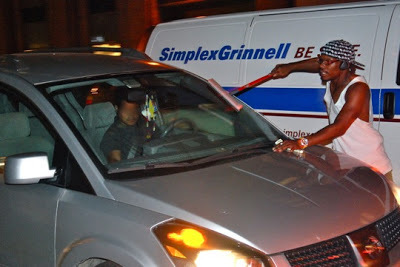 A squeegee man at work, servicing cars waiting to enter the
A squeegee man at work, servicing cars waiting to enter theHolland Tunnel.
In this city there is a long tradition of panhandlers asking for money, and others who avoid panhandling by offering or imposing a service in hopes of the same. In the 1830s doddering Revolutionary War veterans advertised their long-distant service in hopes of a handout from patriotic passers-by, although, when challenged, some of them proved amazingly fit by leaping to their feet and taking off. And in the mid-1860s Broadway was clogged with Civil War veterans in faded blue uniforms, some of them one-legged, who sold pencils and other small items in hopes of a modest remuneration. Continuing the tradition in New York and other big cities in the Depression-era 1930s were the World War I veterans selling apples on the street for a nickel.
For a firsthand impression of mid-nineteenth-century New York and its beggars, we have What I Saw in New York, or a Bird’s Eye View of City Life, by Joel H. Ross, a visitor from upstate New york, published in 1851. He records as the first object he saw to annoy him a colored female beggar, the only black woman he saw begging. (In point of fact, black people in New York City in those days almost never begged.) He saw her sitting at the corner of Broadway and Houston Street day after day, through wind and hail, snow and rain, never speaking, her hand open on her lap to receive alms, with an tattered brown cloak drawn round her so she looked like an old hen brooding chickens. Why, in a city with so much else to see, he became fixed on this woman is hard to say, but fixed he was. The more he saw her, he says, the more he became convinced she wasn’t worthy of alms. The more he observed her, the more he disliked her face and the more he was annoyed. Accustomed to seeing everyone earn their own bread and butter, he became impatient with her silent exhibition, which he viewed as an imposition, a disgrace to herself and the city, all the more so since she struck him as being strong and healthy. In time he made the acquaintance of an honest and intelligent black man who, when questioned about her, urged him not to give her anything, since she was as bad as Satan himself. So when the good doctor saw a lady about to give the woman some money, he informed her that the woman was not worthy of charity; the lady then thanked him for the warning, and the doctor warned the beggar to decamp, failing which he would have her arrested. She did then abandon her post, and several days later he saw her come out of a house to empty a pail of suds in the gutter; he at once recognized her, and she perhaps him: end of story.
Dr. Ross also reported other beggars: a blind man who could really see with one eye, and a weeping boy who claimed his mother was sick, but who, when the doctor offered to go see her, ran away. For the doctor, it seems that there was in the city no such thing as genuine poverty, only fake beggars out to fleece the gullible public. He assures the reader that some of the shabby, dirty, greasy-looking women ragpickers seen gathering rags and bones from the gutters would be out before night in their silks, and that they had money at interest in banks. As for bone boilers, dog killers, horse skinners, hot corn vendors, and street singers – or at least a good many of them – “their place is a good way out of town.” It is no surprise, then, that he advises rural folk to keep to their countrified ways and not move to the city in hopes of wealth and fame, for city life is not all it’s cracked up to be.
If I have lingered over Dr. Ross’s impressions of poverty in the city, it’s because I see in him an arch example of the honest, upright small-town and rural conservative, in this case an upstate New Yorker, who is baffled by the city’s complexities and ambiguities, and marshals against them his own middle-class prejudices and lack of comprehension. Beggars are fakers, and there are ragpickers who are out on the town nightly in their silks (the equivalent of today's alleged "welfare queens"). He visits the Five Points, the city’s worst slum, and sees firsthand how its miserable inhabitants live, but attributes their poverty to crime and indolence. Always, the fault lies with the poor, and never with the society they live in. Rabid conservatives have always struck me as tight and prickly, and liberals as loose and gooey; Dr. Ross is tight and prickly. (For an earlier take on this subject see post #18, Upstate vs. Downstate: The Great Dichotomy, July 20, 2012, accessible via Archives 2012.)
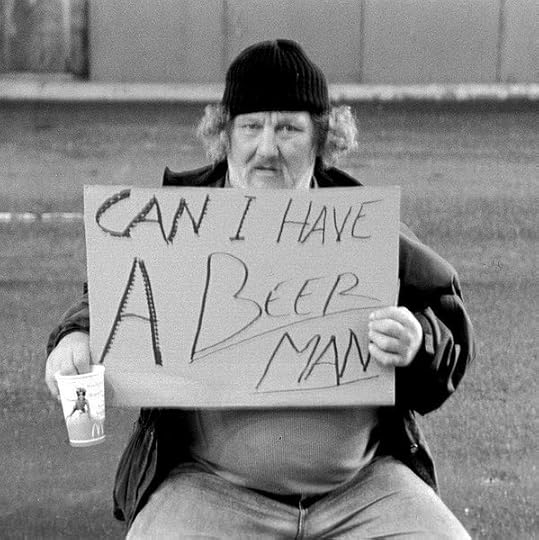 Alberto Gottardo
Alberto GottardoThese attitudes are alive and well today, and not just among the conservatives of the far right. In many American cities laws are being enacted to criminalize homelessness. Often it is against the law to sleep, camp, eat, sit, or beg in public places, with criminal penalties for violating these laws, sometimes with charges for room and board while jailed, failing to pay which results in further time in jail. (Debtors' prisons are back.) Some communities even have laws against feeding the homeless, which puts the authorities at odds with the churches. So distasteful to the snug and prosperous is the sight of poverty, that they intend to banish it altogether from their well-scrubbed communities, which results in the crudest shantytowns located at a safe remove. Unless, of course, the county takes action, too.
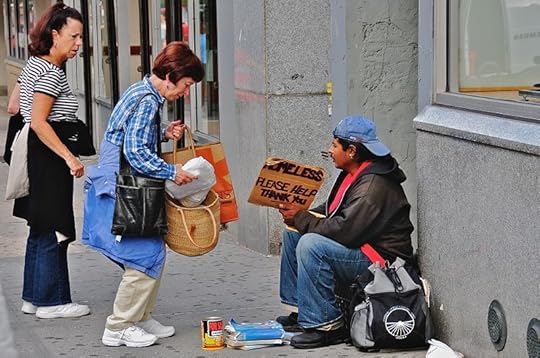 Ed Yourdon
Ed YourdonAccording to a 2006 report by the National Coalition for the Homeless and the National Law Center on Homelessness and Poverty, the twenty meanest U.S. cities, starting with the meanest of all, are as follows:
1. Sarasota, FL2. Lawrence, KS3. Little Rock, AR4. Atlanta, GA5. Las Vegas, NV6. Dallas, TX7. Houston, TX8. San Juan, PR9. Santa Monica, CA10.Flagstaff, AZ11.San Francisco, CA12.Chicago, IL13.San Antonio, TX14.New York, NY15.Austin, TX16.Anchorage, AK17.Phoenix, AZ18.Los Angeles, CA19.St. Louis, MO20.Pittsburgh, PA
This list is hardly complete. From what I have learned recently, any number of other cities could be added to it. So it goes in the Land of the Free and the Home of the Brave.
 Sarasota, Florida. Cleaner than New York, and not a homeless in sight.
Sarasota, Florida. Cleaner than New York, and not a homeless in sight.Ebyabe
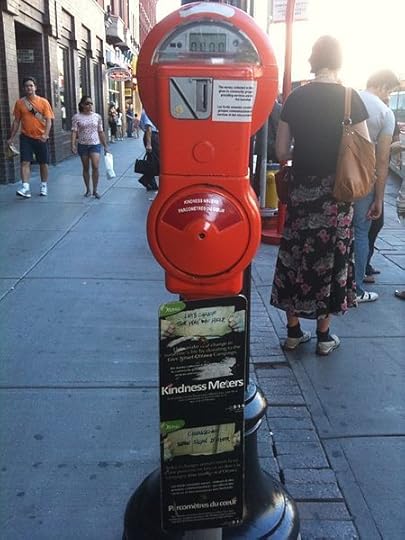 A Kindness Meter in Ottawa.
A Kindness Meter in Ottawa.OttawaAC In Ottawa the civilized Canadians are trying another way to control begging, installing so-called Kindness Meters on the streets where people can deposit donations to help the poor. This is part of an official effort to discourage panhandling and keep panhandlers from spending money on alcohol or drugs. I’m not aware of any such meters in New York, but in Denver there are similar devices called Donation Meters.
I must confess that I have always been tight with a buck. Reinforcing this tendency was a comment long ago by a radio commentator who said that he had once followed a panhandler through the city streets for an hour, counting how many handouts he reaped. He reaped forty, and assuming half were a dime and half a quarter, the panhandler made $7.00 an hour, which in those days was better than what many people earned by honest toil. His conclusion: don’t give. This was my rule for the longest time until, in the last year or two, for some mysterious reason I softened and began giving a quarter to almost any beggar who looked like he or she really needed it. A quarter isn’t much, but I also greeted them in a friendly way, thus acknowledging their humanity, which may be just as important. But I don’t judge others for their charity or lack of it; these are personal decisions, and some people prefer to give through organized charities rather than directly and haphazardly on the street.
There are always interesting cases and exceptions. I remember seeing a nun, or a woman garbed like a nun, entering a busy bar one night to be quickly paid off by the bartender. Catholic friends have since assured me that no bone fide Catholic nun would do such a thing. The most they can do is sit in a public place, eyes down, with a receptacle for donations; they cannot approach or in any way importune passersby. So beware of pushy nuns; they are imposters.
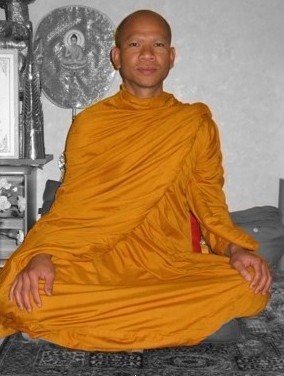 The real McCoy. He won't panhandle you.
The real McCoy. He won't panhandle you.Alexander S. Berger Likewise beware of Buddhist monks with shaved heads, beatific smiles, and flowing orange robes who wander the streets offering passersby their blessing and a tiny amulet, in return for which they request a donation. This is a new phenomenon here in New York City, where they add an additional touch of color to the Elmos and Mickey Mouses and the Naked Cowboy working the crowds in Times Square. When questioned by authentic Buddhists about their vocation and what order they belong to, they abruptly and silently depart. The authentic Buddhists dismiss them as mere beggars and deplore their actions as undermining the credibility of genuine Buddhism. The bogus monks appear to be Chinese, speak little English, and favor Mandarin with local accents from various provinces of China. They are reported also in Canada, Hong Kong, and Australia. In New York City there is no law against dressing like a monk and begging; but if they beg aggressively, then they can be arrested.
Some beggars hope to solicit handouts by displaying amputated limbs, or diseased and twisted legs. Personally, I find this offensive though, again, it’s not against the law. By way of contrast, a little old woman who years ago appeared regularly in the evening on the sidewalk outside Carnegie Hall registered the most pathetic and vulnerable look I have ever seen on a human face; hard of heart were those who failed to give her money. Though she never spoke a word, she became a legend well known to concertgoers. There were rumors that a limousine picked her up at the end of her stint on the sidewalk, but this too may be legend; I can’t confirm it. What is certain is that she was a pro of pros, at the very top of her profession.
In quite another class is Robert McMahon, a bearded Vietnam vet in combat fatigues, his left arm missing and his right leg crippled, who panhandles motorists on Ocean Parkway in the Kensington neighborhood of Brooklyn. His nickname “Rambo” is scrawled on the back of his jacket, along with his years of service with the Marines and his two tours of duty – 1972 and 1973 – that saw heavy action. His empty left sleeve is pinned to his shoulder, and he drags his crippled leg behind him. When drivers stop for a red light, he hobbles over to them and salutes, while holding a paper cup and a sign, “Vietnam vet.” He rarely fails to collect, but any driver who spurns his appeal is assailed with a volley of oaths.
McMahon’s heroic image was abruptly impaired in 2010, when a New York Post photographer, discreetly watching him at the end of his day, saw the handicapped hero nimbly cross the seven lanes of Ocean Parkway and, a few blocks later, pull his allegedly amputated left arm out from under his jacket and use both hands to count his cash. “I’ll put a bullet in the back of your head!” he yelled at the photographer, when he realized he was being photographed. He has been arrested 20 times for disorderly conduct and “fraudulent accosting,” and his Vietnam service seems doubtful. Years ago he was seen accosting motorists in a wheelchair with one leg tucked underneath him; since then the missing leg has miraculously reappeared, but the arm has vanished instead. I don’t always trust what I read in the Post (and I read it rarely), but this account, reinforced with photographs, seems credible. So maybe we could use another Dr. Ross today. But come to think of it, the Post itself more than amply supplies this need.
A panhandler of a different stamp was Eddie Wise, an enterprising black man from Harlem, the son of a four-times-convicted cocaine dealer, who died recently. Eddie preferred the term “hustler” to “panhandler,” and hustle he did on his chosen turf in the Fordham section of the Bronx, combining a distaste for regular employment, a gift for gab, and a talent for spotting small moneymaking opportunities. On Webster Avenue he would courteously greet black customers in a liquor store, “Excuse me, sir. No disrespect or harm. Can you help a brother on your way out?” But if the customer reached at once for his wallet, Eddie would say, “No, no. I’ll wait till you come out.” Wanting dollars, not quarters, Eddie had learned that a customer leaving the store with a liquor bottle was usually more generous. On a good Friday night he could make $60 in three hours – far more than he could make in a regular job. But it all depended on his skill with words. “If you don’t know how to talk, you can’t hustle.”
But Eddie did more than work the liquor store clientele for money. On nearby East 189th Street between Webster and Park he helped people unload purchases from handcarts and put them in their car, endeared himself to locals with his cheerfulness and gossip (who’s back in jail, whose mother kicked him out), and for a small fee held parking spaces for motorists, feeding the meters until they returned from their shopping. His hustling outfit included dark blue jeans, a hooded sweatshirt, and a worn leather jacket, while his hair pulled back in seven braids gave him the nickname “Braids.”
Eddie’s life took a sudden new turn when, in 2004, exasperated by repeated arrests for panhandling, he consulted a Legal Aid attorney and asked if he could sue New York’s Finest. As a result he became the lead plaintiff in a 2005 class action lawsuit accusing the New York Police Department of arresting at least 140 panhandlers, most of them in the Bronx, under an anti-panhandling law ruled unconstitutional in 1992. The complaint had merit, so in 2006 the city agreed to pay him $100,001 if he would drop out of the case, which for that princely sum he was glad to do. So a man who once ate out of garbage cans was waiting for $100,001 coming in one big fat check! News of his bonanza spread quickly through the neighborhood, where acquaintances caked out to him, “The one hundred thousand dollar man!” and passing motorists honked their horns. But an employee of the liquor store where he hustled predicted, “In three months he’ll be broke.” Indeed, years before he had received a hefty sum after his hand was crushed in an accident at work, only to spend it all in a matter of months, mostly on cocaine. But this time, he vowed, would be different.
When the city’s check arrived, he deposited it in a bank – for Eddie, a novel experience. He then withdrew $400, shoved the bills deep in a front pocket, and to get safely home (home being his girlfriend’s apartment) allowed himself the unwonted luxury of a ride in a cab. Over the next few days he bought clothes, gave handouts to fellow panhandlers and his grown daughter and two-year-old granddaughter, feasted on Chinese takeout at home while watching TV, and when tempted to go out and get some cocaine, told himself, “Don’t do it. Don’t do it. Don’t do it.” But he missed the camaraderie of the other car-parkers, and the opportunities to display his skills as a hustler, so finally he went back to 189th Street, heard the gossip of the street, got hustled for handouts by old friends and, finding it wasn’t so much fun now, left. Over the months that followed he stayed clean of cocaine, but since rumors abounded that he had blown all his money on drugs, he had the perfect answer when anyone on 189th Street asked him for money: “I ain’t got it, man. I’m broke. I spent it all on crack.”
If Eddie’s story ended here, it would have a happy ending. But when, in June 2013, he died at age 51 in the dank, rat-infested East 158th Street basement he shared with his wife, the medical examiner’s report said that he died of a brain-stem hemorrhage caused by acute cocaine intoxication and hypertensive cardiovascular disease. He was penniless, having blown most of his money on crack. He left a wife, a three-year-old daughter, and a newborn son, as well as one or more children by another woman. “He wanted a better life,” said his widow. “We had high hopes, but they never came through.”
I have lingered on the story of Eddie Wise because I find it moving, because his life was the opposite of mine, and because Eddie was the quintessential New York street hustler. His story shows the hustler’s joy and exuberance, his energy, his initiative, his love of street life, his living for the moment, his independence, his vulnerability, and the ultimate loss and heartbreak; not for him the bourgeois virtues of order, prudence, and responsibility. For all his failings, Eddie was a real New Yorker.
Source note: For information about Eddie Wise I am deeply indebted to a 2007 New York Magazine article about him by Jennifer Gonnerman.
A follow-up to post #43, Man/Boy Love: The Great Taboo: Still the post with the most views by far of all, it was published on January 20, 2013, and is accessible through the blog archive. In it I told how my longstanding pen-pal relationship (since 2000) with an inmate named Joe in North Carolina led me to a consideration of man-boy relationships, a subject I knew nothing about. Joe was serving a 20-year term – the maximum possible under the plea-bargain agreement – for multiple counts of indecent liberties with a child and crime against nature. This resulted from a three-year consensual relationship with a young teen-ager named Allen (a fictional name). Joe’s story so moved and angered me that I urged him to write his memoir. This he did, with my help; it reads like a novel. In the post I said that the earliest he could hope to be released was sometime in 2014. It is now 2014 and Joe has been released. He has even completed the obligatory three-month parole and is now a free man, if one is ever free when you have to register as a sex offender. He has a full-time job and is adjusting well to freedom. His last e-mail informed me that he just spent the weekend with Allen, now in his 30s, whom he hadn’t seen in 20 years (with the exception of a court appearance where they glimpsed each other at a distance but couldn’t talk). He says they talked for hours, updating each other on the last 20 years, and apart from that just cuddled and watched TV. Good feelings, clearly, on both sides. So much for the criminal justice system of North Carolina and its multiple counts of indecent liberties with a child and crime against nature. The title of Joe’s memoir, by the way, is Crimes Against Nature. He has a lot to say on the subject, even while telling a fascinating story. A small press is now considering it (no big press would touch it); if that fails, there are other options. Sooner or later it will be published.
Coming soon: The smells of New York (whew!); but they aren’t all bad, quite the contrary). Then: brownstone and brownstones, the why and when of them, and inside, the delights and horrors of the Victorian parlor. And then: Ralph Fasanella. Never heard of him? Well, he’s mentioned in last Friday’s Times, but I found him on my own.
© 2014 Clifford Browder
Published on September 07, 2014 04:16
August 31, 2014
142. MOMA and the Frick: Is Bigger Better?
When is bigger better? Americans have always been enamored of bigger and better, usually equating the two, which also meant faster and newer. Change was by nature good, and we generally rushed into it without assessing the cost. This was a new country with new ideas, new religions, new industries, new territories, new cities, new language, new everything, and we scorned anything old as fogyish, ancient, undemocratic, and just plain bad. Progress and Go Ahead were in, tradition and precedent were out. We were an adolescent nation, willing to take chances, to grow, to expand, to experiment, and were scornful of Europe and its mature, even decadent societies. So of course bigger is better; how could it not be? Or is it? At times we catch our breath, we wonder.
The Museum of Modern Art
In New York City, where Go Ahead has also reigned, the museums are absolutely convinced that bigger is better. The Museum of Modern Art (MOMA), a stellar attraction with a fabulous collection, has blazed ahead with dramatic renovations, so as to house its huge collection and meet its growing need for more space for educational and research activities, and to accommodate the ever growing throngs of visitors. Which hasn’t been easy, since the museum is situated in the heart of midtown Manhattan, squeezed in by other buildings on all sides.
So what has MOMA done? Expand in the only direction possible: upward. As part of its 1983 expansion it built the 52-story Museum Tower at 15 West 53rd Street, a soaring high-rise providing six floors of museum space and, above that, 248 condominium apartments with high ceilings, huge rooms, and floor-to-ceiling windows offering views of Central Park to the north and of the city skyline, and in some cases the museum’s sculpture garden. The building’s amenities include doormen, a concierge, a fitness center with a sauna, a steam room and a meditation room, a business conference room, a wine storage room, a landscaped roof terrace, and housekeeping and laundry services. What, indeed, does it not offer? But these attractions aren’t for just anyone. A one-bedroom apartment currently starts at over $2 million, and a two-bedroom at $4.5 million. So bigger is better for those who can afford it, and for the finances of the museum, which sold the air rights for the tower to a private developer for $17 million. But just who lives in the tower remains a mystery, since real estate agents promote the amenities offered but not who takes advantage of them.
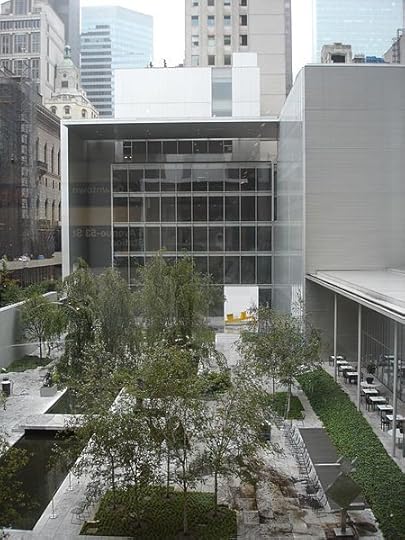 MOMA and its sculpture garden.hibino But the 1983 tower was just the beginning. In 1997 the Japanese architect Yoshio Taniguchi beat out ten other international architects to win the competition to redesign the museum once again. The museum was closed from May 21, 2002, until November 20, 2004, while Mr. Taniguchi worked his miracles, imposing a long fast on those tens of thousands, myself included, eager to feast on MOMA’s Picassos, Matisses, Van Goghs, and other splendors, unless, for a modest taste of those splendors, they were willing to undertake a perilous journey into the wilds of Queens, where a few treasures were displayed in a former staple factory in Long Island City.
MOMA and its sculpture garden.hibino But the 1983 tower was just the beginning. In 1997 the Japanese architect Yoshio Taniguchi beat out ten other international architects to win the competition to redesign the museum once again. The museum was closed from May 21, 2002, until November 20, 2004, while Mr. Taniguchi worked his miracles, imposing a long fast on those tens of thousands, myself included, eager to feast on MOMA’s Picassos, Matisses, Van Goghs, and other splendors, unless, for a modest taste of those splendors, they were willing to undertake a perilous journey into the wilds of Queens, where a few treasures were displayed in a former staple factory in Long Island City. So what wonders did the museum now offer, at a cost of $858 million? Yet more space for exhibitions, classrooms, auditoriums, library, and archives. But more than that, Mr. Taniguchi promised to make the architecture disappear. Did he? I can hazard an opinion on the public spaces, since I have set foot there, an adventure denied me for the 1983 tower. And what have I found? Plunging perspectives that make me feel distinctly uneasy, even though I have no particular fear of heights. (I have climbed to the top of pre-Columbian pyramids in Mexico and Guatemala and – the real test – come back down again without a flutter of qualms.) And glass walls that seem like there are no walls at all, which likewise makes me uneasy. Having survived these terrors, I’m always glad to enter exhibition rooms that have four solid walls, a ceiling, and a floor, with no such menacing perspectives. Architecturally I'm a hopeless old fogey.
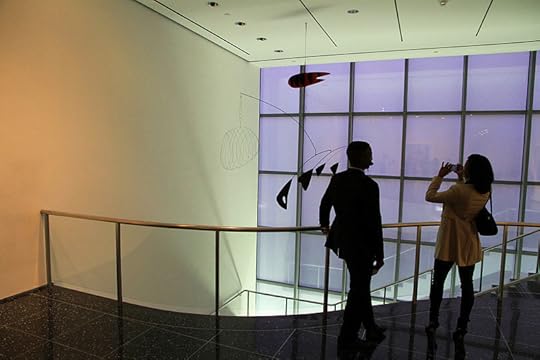 Ingfbruno
Ingfbruno
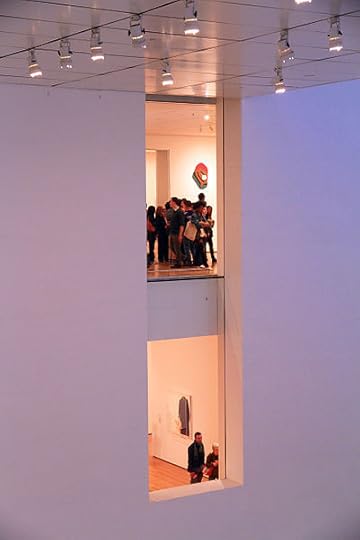 Ingfbruno
IngfbrunoWhat did the critics say of the new MOMA, the brain child of Mr. Taniguchi? Roberta Smith of the New York Times decried a “big, bleak, irrevocably formal lobby atrium,” hard-to-find escalators and elevators (true), and too-narrow glass-sided bridges (also true) in a “beautiful building that plainly doesn’t work.” Author John Updike in the New Yorker cited the “enchantment of a bank after hours, of a honeycomb emptied of honey and flooded with a soft glow.” So the prevailing note seemed to be coldness and a want of charm. Granted, New York critics have a talent for savaging anything, but in this case I’m inclined to agree. In the case of the ever expanding MOMA, bigger is not better. Better in terms of new space acquired, certainly, but at the cost of less intimacy, less warmth, less comfort and ease for visitors.
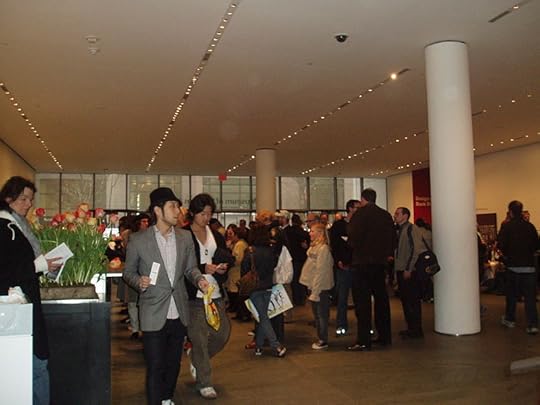 The bleak and crowded lobby.
The bleak and crowded lobby.Marlith
Is more progress or mayhem to follow? In 2007 the museum sold a lot on its west side at 53 West 53rd Street to Hines Development, an international real estate developer, for $125 million. Hines announced grandiose plans to build Tower Verre, an 88-story high-rise designed by French architect Jean Nouvel that would be almost as tall as the Empire State Building, with a faceted exterior with crisscrossing beams, its sleek form tapering to a set of crystalline peaks at the very top, where glass walls with tilting trusses will give a sense of being simultaneously both enclosed and exposed – a design that shocks some but inspires and excites many. Bland it ain’t. The city’s Department of City Planning insisted that the structure’s height be cut by 200 feet on aesthetic grounds, but it has still been welcomed as an enterprise that would finally let New York compete with the startling initiatives of Dubai and Singapore and Beijing. The tower will house three floors of exhibition space for MOMA, a 5-star hotel, and 171 luxury apartments – these last obviously just what New York City needs more of. But the economic crisis of 2008 hit architecture hard, and Hines’s soaring residential tower was delayed indefinitely until, in October 2013, the needed $1.3 billion was reported to have been found, thanks to loans from a consortium of Asian banks and from billionaire investors in Singapore, with an assist from Goldman Sachs. Construction is slated to begin in mid-2014 – in other words right about now, though I haven’t been up there to check things out.
 Singapore by night. Can New York match it?
Singapore by night. Can New York match it?Eustaquio Santimano
 The projected Tower Verre. So what do I think of the projected Glass Tower (verre = glass), not meant to be the tallest building in the world, but one that narrows, stabs, and needles upward to celestial heights? The English art critic Ruskin said of Gothic architecture, “It not only dared, but delighted in, the infringement of every servile principle.” If New York is to rival the architectural daring of Asia, what better place for it to happen than at MOMA and its midtown neighbors? I hadn’t anticipated such a conclusion, but this venture is a challenge. Can New York still dare and astonish? I hope so. It has always dared in the past, and its daring produced Central Park, the Brooklyn Bridge, the Empire State Building, Rockefeller and Lincoln Center, the UN building, and the Twin Towers – most of them unprecedented and all of them astonishing. Is Go Ahead still alive? Does the dark eros of the city, the force that drives New York, still exist? Nouvel’s surging tower suggests that it does. If foreigners have faith in the city, surely New Yorkers can, too.
The projected Tower Verre. So what do I think of the projected Glass Tower (verre = glass), not meant to be the tallest building in the world, but one that narrows, stabs, and needles upward to celestial heights? The English art critic Ruskin said of Gothic architecture, “It not only dared, but delighted in, the infringement of every servile principle.” If New York is to rival the architectural daring of Asia, what better place for it to happen than at MOMA and its midtown neighbors? I hadn’t anticipated such a conclusion, but this venture is a challenge. Can New York still dare and astonish? I hope so. It has always dared in the past, and its daring produced Central Park, the Brooklyn Bridge, the Empire State Building, Rockefeller and Lincoln Center, the UN building, and the Twin Towers – most of them unprecedented and all of them astonishing. Is Go Ahead still alive? Does the dark eros of the city, the force that drives New York, still exist? Nouvel’s surging tower suggests that it does. If foreigners have faith in the city, surely New Yorkers can, too.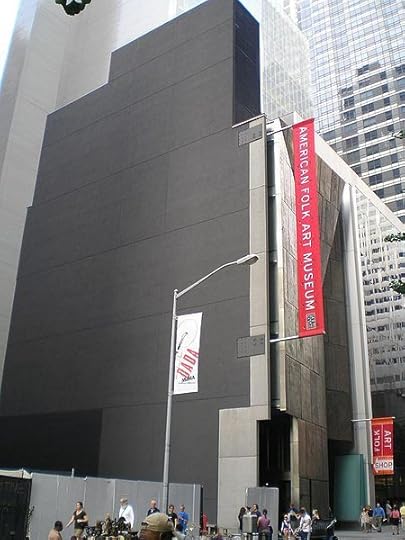 The American Folk Art Museum in 2006,
The American Folk Art Museum in 2006,in perilously proximity to MOMA.
David Shankbone What a comedown to have to state that in 2011 the ever expanding MOMA, its galleries jammed with visitors, acquired for $31.2 million the home of the financially strapped American Folk Art Museum at 45 West 53rd Street, adjoining its property on the east, and that two years later it announced plans to demolish this gem of a building, only 13 years old and therefore without landmark status. (The Folk Art Museum itself has moved to a smaller location at 66th Street and Columbus Avenue.) Howls greeted MOMA’s announcement, and pleas were made to spare the Folk Art Museum building and its somber façade made of folded planes of hammered bronze, unique. MOMA then reviewed its latest expansion plans, which included demolition of the little structure, but in January 2014 announced that it was simply impossible to save it; it would have to go. As of now, it awaits the wrecking ball. Bigger wins out again, but this time to very few cheers.
The Frick Collection
The Museum of Modern Art is about as big time as you can get. By way of contrast, the Frick Collection at East 70th Street and Fifth Avenue offers the charm of smallness and intimacy. Housed in the Gilded Age mansion of industrialist and art collector Henry Clay Frick (1849-1919), an associate of steel magnate Andrew Carnegie, it includes works by Constable, Turner, Gainsborough, Goya, Fragonard, El Greco, Holbein, Rembrandt, Piero della Francesca, and many others, plus 18th-century French furniture and porcelains, Italian bronzes, and Limoges enamels. What last drew me there was the chance to see the collection’s three Vermeers displayed side by side; it’s hard enough to find a Vermeer in this country, and to see three at once in the same room is rare indeed. Though visitors are confined to the ground floor and its annexes -- a velvet rope blocks off the grandiose marble staircase leading tantalizingly to the forbidden second floor -- I managed to experience the ambience of Frick’s home and fell in love with the place all over again. It reminds me of the Isabella Gardner Museum in Boston, another delightful relic of the Gilded Age and its moneyed art collectors, whose newly amassed fortunes let them snap up Old Masters still available, for a price, in Europe.
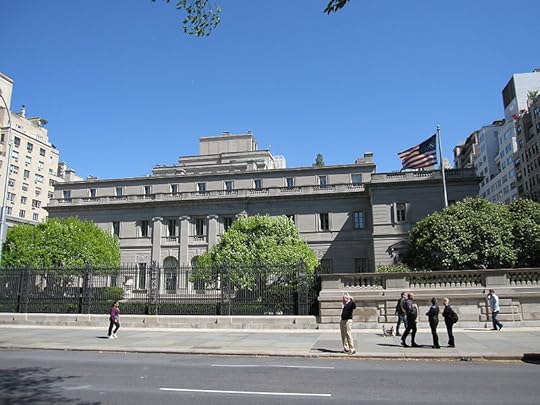 The Frick's Beaux Arts façade, facing Fifth Avenue.
The Frick's Beaux Arts façade, facing Fifth Avenue.Gryffindor
But the Frick, like MOMA, is receiving ever larger throngs of visitors and longs for greater space to accommodate them and expand its facilities. In June 2014 it announced its master plan for a long-delayed expansion that would add 40,000 square feet of space and numerous much-needed amenities: a large new reception hall, a 220-seat auditorium, a special ground-floor exhibition gallery, a passageway connecting the collection to the adjoining six-story art reference library on East 71st Street, and – finally! -- access for visitors to the mansion’s second floor. All this would be done carefully, integrating the new facilities architecturally with the original mansion and the additions done brilliantly by architect John Russell Pope in 1935 – additions so seamless and so harmonious that visitors think them part of the original structure. The new addition’s limestone façade along East 70th Street will blend in with that of the original mansion and the Pope additions and offer a rooftop garden as well with views of Central Park and the West Side of Manhattan. Respite all these changes, the Frick management assures the public that the Frick Collection will retain its gemlike quality and resonate with the comfortable grandeur of the Gilded Age.
But will it? Voices have been raised in opposition. The proposed plan entails constructing a new tower on East 70th Street replacing a gated garden dating from 1977, the creation of British landscape architect Russell Page. The garden, the Frick management reminds us, was never open to the public, but it can be viewed from the street and from the museum’s current reception hall. It features a rectangular pool with floating lotus and white lilies in summer, surrounded by gravel paths and boxwood hedges. It flowers almost year round with late-blooming crab apple and Kentucky yellowwood trees, clematis and hydrangea on trellises, and wisteria climbing up the wall. “A masterpiece of restrained minimalism,” it has been called, setting the mansion apart and dappling it with shade: one of those minor miracles that the city has managed to squeeze into small spaces here and there, alleviating its cement and concrete massiveness with a touch of green.
But more than the garden is at risk. I and many love the Frick as it is, and don’t want it to join the ranks of museums remaking themselves for huge crowds and blockbuster shows where visitors stand six deep to admire the overpublicized marvels on display. The Frick is small and should house shows that are similarly small; in my book, small is beautiful.
A friend of mine once worked at the Frick. Here is his take on the Frick then and now: “When I started working there in 1967 it was a quiet backwater housed in a discreet, if imposing, limestone mansion. People were welcome to visit, if they really wanted to; in fact, admission was free. But if nobody was asking them to come, and if they stayed away, so much the better. What was on view was the Founder’s personal art collection, augmented now and then by purchases made from the Founder’s endowment by the Board of Trustees. That was it. The idea of a special, temporary exhibition was unheard of – no, anathema! The loyal, respectful staff included many who had been there since the place opened to the public in the 1930s. It was serene, and it made you feel good to be there. “Over the years the endowment began to shrink, and those in charge began to look elsewhere for the wherewithal to keep the place running. Fundraisers were added to the staff, along with writers of grant applications, etc. The Museum Shop grew from a closet (literally) to a bustling place of commerce. The [indoor] Garden Court began to be rented out for wedding celebrations and bar mitzvahs. The most crowd-pleasing traveling exhibitions were eagerly courted; my favorite was Fairies in Victorian Art (literally).
“All of this snowballed, and now the goal is to draw in as many admission-payers as the building can hold, and then to add new space to bring in still more admission-payers. And then still more. And more. Well, you can see what I think of the extension plans.”
No, bigger is not always better. Let the site adjoining MOMA hurl its needle-nosed high-rise skyward, but let the Frick try to retain something of the small-scale charm that it once radiated. It’s now up to the city’s Landmarks Preservation Commission. The Frick will probably get something of what it wants, but maybe not all; time will tell. I’m glad I knew it way back when its charm was still intact.
Me and the American Folk Art Museum: I am chagrinned to admit that I have never visited this museum; since low attendance was one of the ills causing it to move from its midtown location, I have contributed to its financial problems. But in New York, with so many big-name museums with stellar collections, it’s easy to overlook the smaller ones, and that is what for years I have done. Now, seeing some of its treasures online – ceramics, scrimshaw, weathervanes, paintings, furniture, quilts – I have vowed to rectify this omission by paying the museum a visit, and encourage others to do so as well. Admission is free. By way of comparison: MOMA: adults $25, seniors $18, students $14. Metropolitan Museum of Art: adults $25, seniors $17, students $12 (recommended; you can get in for less). Neue Galerie: $20, students and seniors $10. Obviously, the Folk Art Museum is a rare bargain.
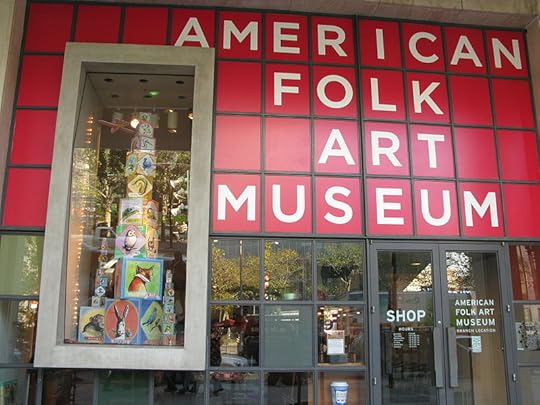 American Folk Art Museum
American Folk Art Museum Bird of Paradise quilt, 1858-1863. One of the museum's treasures that I hope to see soon.
Bird of Paradise quilt, 1858-1863. One of the museum's treasures that I hope to see soon.American Folk Art Museum
Me and gun control: A child of the Midwest, I learned to fire a shotgun at age sixteen. From my father, of course, since he was an avid hunter and fisherman, though I was not. He kept his beloved shotguns in their cases under his bed, and it never occurred to me or my more adventurous brother to ever go near them in his absence. He never forbade it, we simply couldn’t imagine doing it. Fast-forward to today: A shooting instructor was accidentally shot and killed last Monday at a shooting range in Arizona while showing a nine-year-old girl how to use a Uzi submachine gun; he was standing next to her when she pulled the trigger and the recoil sent the gun out of her control. No comment.
My audience: For both the week and the month, and sometimes for the day, this blog gets the most viewers, predictably, from the U.S., and after that, most unpredictably, from the Ukraine and Turkey. And the post with the most viewers continues to be #43, Man/Boy Love: The Great Taboo. My conclusion: People in many societies aren’t used to candid discussions of sex, least of all this subject, and so are irresistibly drawn to this post.
Coming soon: Panhandlers and hustlers of New York, including one who got $100,000 from the city. After that, the smells of New York. Let me know your favorites, pleasant and unpleasant, and I’ll include them; I’ve already got some lulus.
© Clifford Browder 2014
Published on August 31, 2014 04:27
August 24, 2014
141. Hell House and Christian Terrorism
Christian terrorism? Many will balk at the notion, given the murderous terrorisms rampant in the world today. But here is the dictionary definition of terrorism: “The systematic use of terror, especially as a means of coercion.” Now consider these scenes:
· A smashed car and two teenagers sprawled dead on the pavement, the result of drunk driving.
· The sacred institution of marriage is disgraced by the Satan-inspired wedding of two men.
· A teenager tormented by the stress of life, Satan-inspired, commits suicide.
· A young woman bleeding to death between her legs, the result of a self-induced abortion.
· A human infant sacrificed during a clandestine Satanic ritual where masked ghouls and demons utter horrific shrieks and screams in a flickering light. In the audience petrified children cling to their parents, sobbing.
· A depressed teen is pressured by witches to murder his fellow students.
· A demon dancing around the coffin of an AIDS victim, rejoicing that the dead man is now tormented in hell. “I tricked him into believing he was born gay!” the demon exults. “Have you ever heard something so silly?”
· A girl at a rave takes a pill that a young man offers her, telling her it will relax her; she passes out and is gang-raped.
· A corridor in hell where the damned reach out from peepholes begging for help.
· The Angel of the Lord in shining white and a dark-robed demon battle over a teen-age lesbian about to commit suicide. A child in the audience gasps, “I can’t breathe!” and is helped out of the room.
· A girl shrieks and gesticulates as she dies from an overdose of methamphetamine.
· Cold, uncaring medics advise a young woman to have an abortion. “Why not?” taunts a red-faced demon. “Everyone is doing it these days!”
· Scared teenagers in the audience are told by a ghoulish voice to get inside a row of upright coffins; when they do, demons pound on the sides of the coffins while shrieking loudly.
· A girl is strapped to a table for an abortion. Nurses operate, pull out gnarly-looking gobs of bloody flesh; nurses and girl are splattered with blood. Teenage girls in the audience weep. The girl having the abortion dies, goes straight to hell.
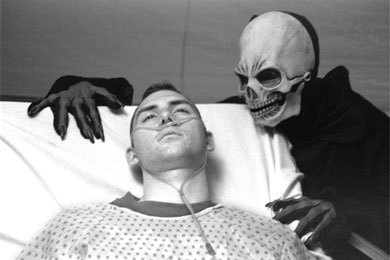
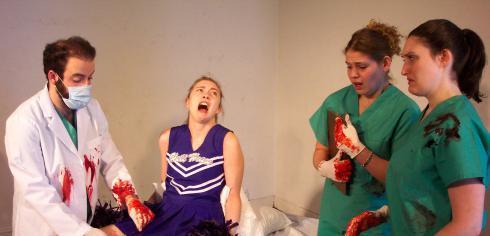
These are some of the scenes presented around Halloween each year by various fundamentalist Christian churches, in an attempt to frighten impressionable young people with the consequences of sin and then offer them a way out through commitment to Jesus. While the target is primarily teenagers, some of the accounts show that parents are taking very young children to these events, which are well designed to terrify. Ministers presiding over these presentations admit quite candidly that they are meant to frighten, not to entertain. So in this respect Hell Houses differ from the spook houses associated with Halloween and many fairs and amusement parks; the goal of the Hell Houses is to frighten you away from Satan and into the redeeming arms of Jesus. And by most accounts they do succeed in frightening, if not everyone, many impressionable young people who go to them out of curiosity, or for a thrill, or because they are already half converted. And those presenting the scenes are often teenagers themselves, members of the church sponsoring the event.
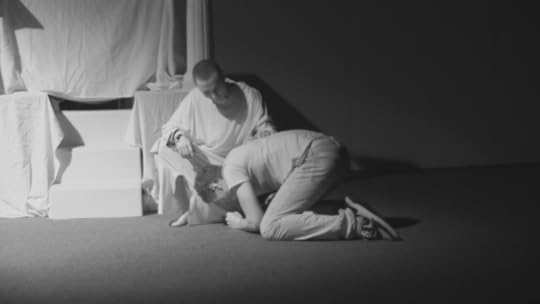 A Hell House presentation of particular judgment, judgment
A Hell House presentation of particular judgment, judgmentof an individual following death.
While Hell Houses can be found almost anywhere in the U.S. except the West Coast and the Northeast – in other words, wherever there are Christian fundamentalists -- they seem to abound in Texas. The first one is believed to have been the creation of the Trinity Assembly of God in Dallas, but they were popularized in the late 1970s by Jerry Falwell, the evangelical Southern Baptist televangelist and founder of the Moral Majority.
Today Keenan Roberts, pastor of the New Destiny Christian Center in Denver, offers kits for $299 that will let you build your own Hell House with a series of theatrical scenes; included are a DVD of Roberts’s own production, a 300-page instruction manual, and an appropriately spooky soundtrack. Roberts himself dons a long black robe, a gray face mask, and large black horns to play a demon who guides visitors from room to room of his own Hell House, which in a 2012 interview he claimed had been visited by 75,000 people over the last 16 years. He refuses to provide the media with sample kits, but excerpts have appeared online. For an abortion scene, he recommends buying “a meat product that closely resembles pieces of a baby” to put in a glass bowl; the actors playing the medical staff involved should be “cold, uncaring, abrupt and completely insensitive.” And business is good: the kits have now allegedly been sold in all 50 states and 26 foreign countries. Has his initiative been criticized? Yes, even in some Christian circles. Does it bother him? Certainly not. “God’s going to have the last word.”
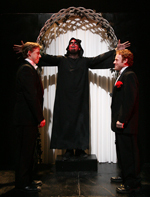 The wedding of Adam and Steve
The wedding of Adam and SteveLes Freres Corbusier Secular, easygoing New York may not seem a likely venue for a Hell House production, but in October 2006 Les Freres Corbusier, a theater company with a Jewish producer and a Catholic director, presented what they termed an “authentic rendition” of Roberts’s outreach kit in Brooklyn, straight-faced and devoid of irony, in hopes that the audience would draw their own conclusions. The sequence of horror scenes was climaxed by a steam bath of a hell with a glaring Satan; then an angel leading visitors upstairs to meet a Jesus played by an actor with intimidating sincerity; and finally, to round things out, a fruit punch and music by a live Christian rock group, and an invitation to play “Pin-the-Sin-on-the-Jesus,” where visitors pin on a cardboard cutout of Jesus a piece of paper on which they have written a secret sin obstructing their salvation, which some of them actually did (“Anal sex,” “I think Jesus is hot,” “I am a man and I wear Capri pants”). And all this without a hint of irony, a suggestion of satire; the mockery, when there was mockery, was provided by younger elements in the audience.
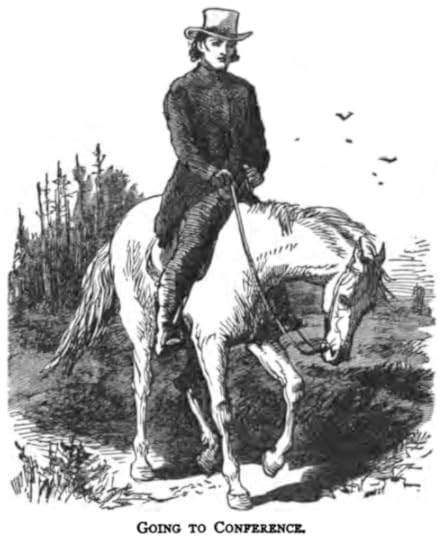 A Methodist circuit rider. So much for Hell House in the Big Apple. But Christian terrorism for the sake of converting the backslidden and the heathen has a long history in this country, which has seen a series of Great Awakenings aflame with hellfire. As late as deep into the nineteenth century most of the mainstream Protestant sects treated their faithful, and the not so faithful, to fire-and-brimstone sermons designed to scare them into repentance and salvation. No one was better at this than the Methodists, whose circuit riders ranged far and wide, both to settled churches and the constant flux of the frontier, preaching fierily in churches or, to accommodate multitudes who couldn’t fit into the churches of the neighborhood, in open fields. So let’s imagine one of these open-air meetings in a rural region where the coming of a preacher was a big event for people starved for entertainment of any kind (no radio or TV, no Internet, perhaps no newspaper), a people eager for excitement, for something meaningful and passionate.
A Methodist circuit rider. So much for Hell House in the Big Apple. But Christian terrorism for the sake of converting the backslidden and the heathen has a long history in this country, which has seen a series of Great Awakenings aflame with hellfire. As late as deep into the nineteenth century most of the mainstream Protestant sects treated their faithful, and the not so faithful, to fire-and-brimstone sermons designed to scare them into repentance and salvation. No one was better at this than the Methodists, whose circuit riders ranged far and wide, both to settled churches and the constant flux of the frontier, preaching fierily in churches or, to accommodate multitudes who couldn’t fit into the churches of the neighborhood, in open fields. So let’s imagine one of these open-air meetings in a rural region where the coming of a preacher was a big event for people starved for entertainment of any kind (no radio or TV, no Internet, perhaps no newspaper), a people eager for excitement, for something meaningful and passionate.Such meetings often began with assurances that they would outsing the Baptists, outpray the Quakers, outpreach and outlove the Presbyterians. Then, to warm things up, they would sing such classic hymns as this:
The world, the devil, and Tom Paine Have tried their force, but all in vain, They can’t prevail, the reason is The Lord protects the Methodist!
And so on for eighteen verses.
But that was just the beginning. Cries of “Praise Jesus!” and “Hallellujah!” would season the gathering, and as dusk came on, torches would be lit that cast an eerie glow. Then a preacher in a crow-black coat would climb up on a handy stump and begin.
“Brethren, I grieve at the low state of Zion. Satan is in your homes and your hearts!”
Gasps, cries of “No!”
“He is! You’ve been guilty of false pride, greed, and tobacco, of ostentatious apparel and blasphemy, of card-playing, of intemperance, adultery, and dancing! Look into your hearts and see the filth!”
They did. None of them could escape his censure, all of them had sinned.
“Fools!” cried the preacher, sweat streaming down his face as tiny bubbles spewed from his lips. “Maybe this year – this month, this day – you’ll roast in the hot flames of hell, cast down among infidels, Mahometans, and Papists, while your bones hiss and crackle, and demons tong your flesh!”
Sobs in the shadows; a flickering light on tear-stained faces.
“It need not be!” exhorted the preacher, after describing in lurid detail the torments of hell. “Renounce sin, accept the sweet love of Jesus. Cross over into Beulah land! O come to Jesus, come!”
By twos, threes, then scores, weeping and groaning, they would stagger up to the Mourners’ Bench and sit, sobbing and praying. Some might even shriek and fall to the ground.
“Pray, brethren, pray for forgiveness!”
Tears, dazed faces as they prayed. A young girl, limp in the arms of others, might speak in tongues, while other young women plucked off frills and ribbons and threw them away, and both men and women, sin-convicted, writhed and jerked on the ground. Still others, their ruddy faces glowing in the torchlight, would gather round the penitents shouting “Glory!” while the preacher, raising both arms toward heaven as he beheld the results of his preaching, might exclaim in triumph, “Ride on, glorious Redeemer!”
Few of those attending such a gathering, even if not among the sobbing penitents, could fail to be moved. Talk of it would echo through the county for days, and the memory of such a meeting could last a lifetime. As for the penitents, they were in God’s pocket.
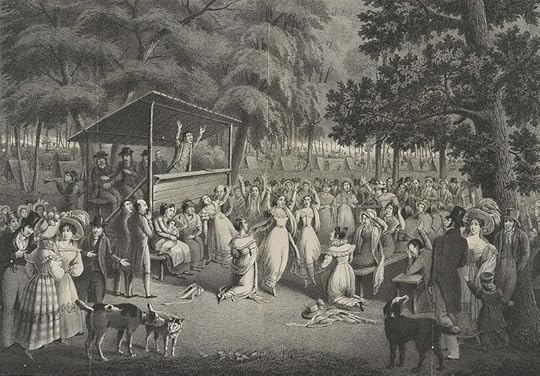 A camp meeting, circa 1829. Women seem especially susceptible.
A camp meeting, circa 1829. Women seem especially susceptible.So the Hell House of today carries on a long American tradition of scaring people into salvation, though with a difference. In those days the terrors of hell awaited sinners in the next life; in this life those sinners might be plump and prosperous. But the Hell Houses of today, while promising the same fire-and-brimstone hereafter, bring hell into people’s lives right now; the torment of the sinful begins in this life with painful abortions and rape and AIDS, before being heightened in the next.
But the tradition of Christian terrorism goes back even further, to the morality plays of the 15th and 16thcenturies in Europe, where a central character like Everyman was assaulted by the Seven Deadly Sins (Lust, Gluttony, Greed, Sloth, Wrath, Envy, and Pride), but aided by such allegorical figures as Good Deeds, Knowledge, Discretion, and Strength. The whole drama consisted of Everyman’s struggle to lead a godly life, failing which the gates of hell gaped wide to receive him.
Everyman’s struggle points back to the western façade of the great Gothic cathedrals of France, the façade facing the sunset and its suggestion of finality, the façade that often showed the Christ of the Second Coming, the Christ of the Last Judgment. Thus the sculpture over the central portal of Notre Dame in Paris shows Christ flanked on his right by the kneeling Virgin Mary and on his left, also kneeling, St. John the Evangelist; under them a winged Saint Michael and a grinning demon weigh souls, and another demon leads the damned off to perdition. The cathedral, like all the Gothic cathedrals of Northern France, was dedicated to the Virgin, whose compassion would hopefully mitigate the stern judgment of her Son. Even so, this was the main entrance, so its subject gave a cheery greeting to the faithful as they came to attend Mass or pray.
 The central portal of Notre Dame de Paris.
The central portal of Notre Dame de Paris.Jebulon
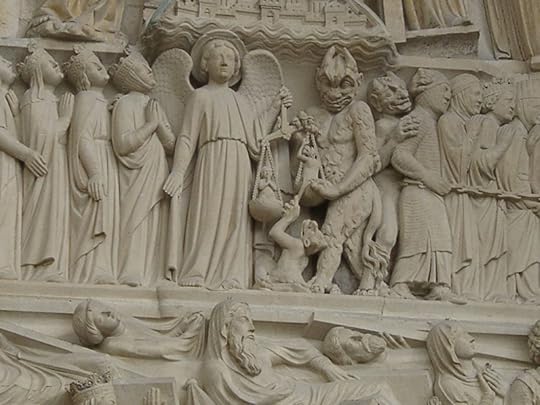 Saint Michael and a demon weighing souls.
Saint Michael and a demon weighing souls.Julie Kertesz
This scene of the Second Coming was portrayed as well by painters, most notably by Michelangelo in his vast fresco on the altar wall of the Sistine Chapel in the Vatican, where a muscular and angry Christ gestures dramatically to condemn the nude figures of the damned descending to hell and its demons on his left (our right, as we view it), while the saved, also nude, ascend to heaven on his right. The sculpted sinners of the cathedral portals tend to be stiff and stylized, without much differentiation, whereas Michelangelo’s sinners are painted with Renaissance dynamism and drama, no two of them alike. Especially gripping is one chubby male who, gripped by a demon, buries his face in one hand as he hunches over, stricken with dread and despair as he realizes he is damned for all eternity; nothing a Hell House offers can match it.
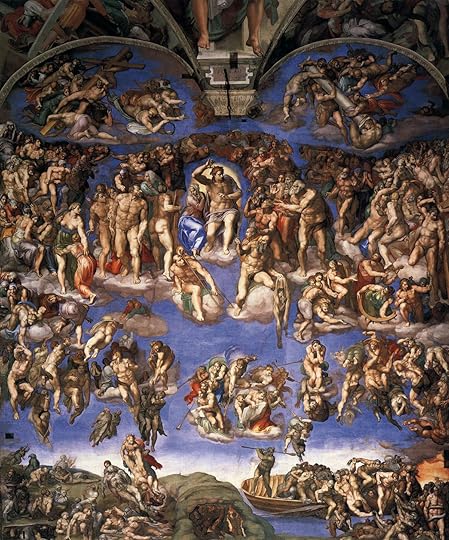 Michelangelo's Last Judgment.
Michelangelo's Last Judgment.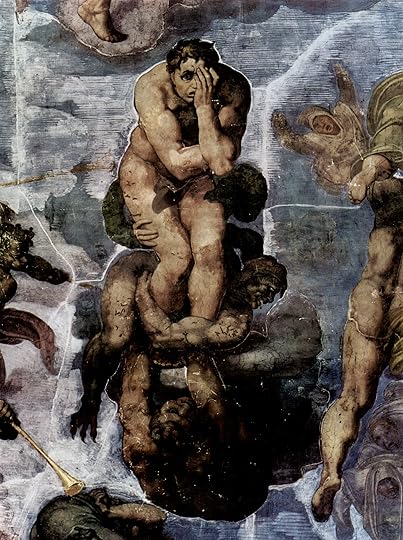
So where is the Virgin, that figure of warmth and compassion? She is there, just to the left of her Son and fully garbed, but she is dwarfed by comparison and turns away from him, almost cowering; this is his scene, not hers. Not much lovingkindness here; Christ is much more Judge than Redeemer. (Unlike so many Italian painters, Michelangelo was not one to portray a gentle, merciful Virgin; his females, far from being soft and motherly, tend toward the stern and majestic, like the Sybils of the Sistine ceiling.)
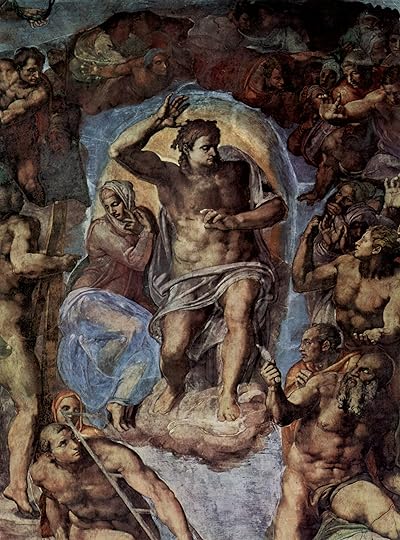
From Michelangelo to the Gospels is only one quick leap. In Matthew 23:33 Jesus says, “Ye serpents, ye generation of vipers, how can ye escape the damnation of hell?” And in Luke 12:5: “But I will forewarn you whom ye shall fear: Fear him, which after he hath killed hath power to cast into hell; yea, I say unto you, Fear him.” And in Matthew 13:49-50: “So shall it be at the end of the world: the angels shall come forth, and sever the wicked from among the just, And shall cast them into the furnace of fire: there shall be wailing and gnashing of teeth.” And in Matthew 25:41: “Then shall he say also unto them on the left hand, Depart from me, ye cursed, into everlasting fire, prepared for the devil and his angels.” So in the Gospels hell is a very real place of torment, and God is to be feared. Jesus promises forgiveness elsewhere and promises heaven to the righteous, but here he stresses judgment and fear.
All of which is awkward for those many Christians who today shy away from notions of Satan and hell and torment, uncomfy as they are. Since the nineteenth century vast numbers of Americans have opted for religion without God, salvation without sin, a kind of feel-good faith emphasizing good works for those less fortunate than ourselves, and the Golden Rule for all. I should know, since I grew up in a liberal Methodism that said nothing of hell and torment, and a great deal about compassion and tolerance and sharing. I will always be grateful to those gentle Methodists for not ramming ideology down my tender throat, for not imposing a set of strict rules on me, for offering me examples of warmth and love in action and, in the case of a few, a genuine, deep-rooted spirituality.
Admittedly, there are risks in de-Satanizing Christianity, in dousing hellfire so as to emphasize exclusively Christian love and compassion. The result is often a namby-pamby religion where everyone gets to heaven, a religion without spine and rigor. You can see it in the sentimentality of much nineteenth- and twentieth-century religious art, as for example the slides shown me in Sunday School classes every Easter. The slides served their purpose by immersing our callow minds in the drama of Holy Week, but in retrospect I realize how insipid they were artistically.
The sentimentalizing of religion is also seen in Hollywood movies about priests and nuns, as for instance Loretta Young in the 1949 film Come to the Stable, where she plays a beatific nun, her smile benign, her goals noble, and her utterance pure sugar. I’d like to think that, Hollywood notwithstanding, such insipidity is confined to a certain brand of Protestantism, but one glance at websites offering Catholic religious objects for sale disabuses me. There are figurines of Mary and the saints (“Saint Joseph will help you sell you home”) that are equally insipid, sometimes offered in a “blow-out sale.”
The figures I remember being sold in stores for small indoor Christmas Nativities were among the worst, with feminine angels with flowing blond hair and dainty features, but the larger ones advertised online today are no better. All these winged cuties are a far cry from the fearsome male angels of an earlier age, epitomized memorably in Saint Michael, the fearsome warrior archangel who will weigh the souls at the Last Judgment, and who led God’s forces in driving Satan and his rebellious cohorts out of heaven and hurling them down to hell.
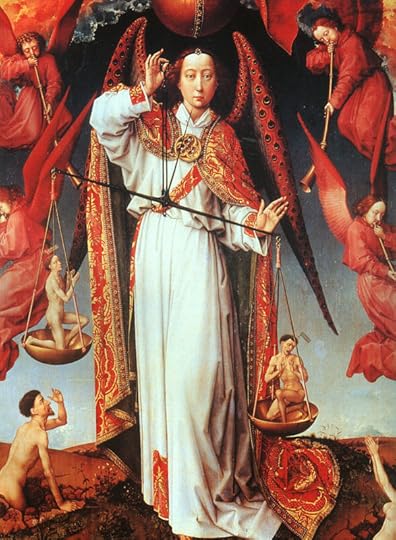 Saint Michael, weigher of souls at the Last Judgment. Rogier van der Weyden,
Saint Michael, weigher of souls at the Last Judgment. Rogier van der Weyden,1443-1446. This guy you wouldn't mess around with; he means business.
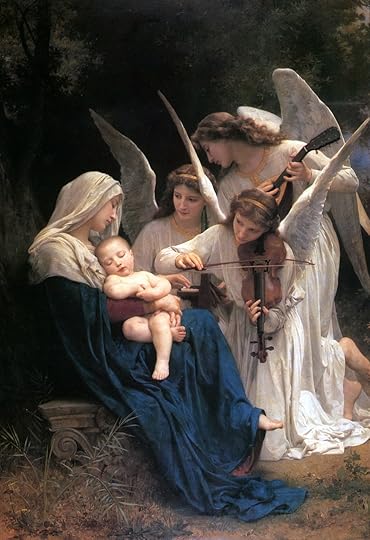 William-Adolphe Bouguereau, Song of the Angels, 1881. You think
William-Adolphe Bouguereau, Song of the Angels, 1881. You think this is the ultimate in 19th-century religious sentimentality? Just wait.
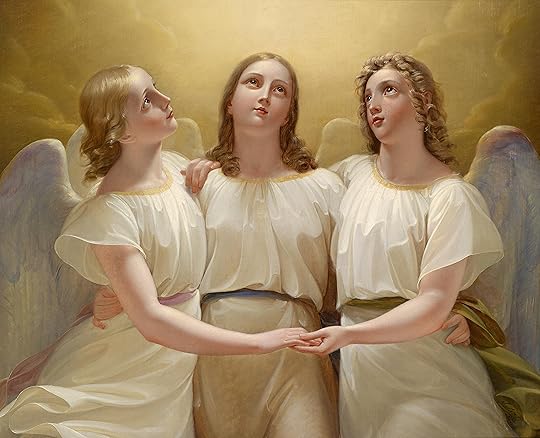
Franz Kadlik, Three Angels, 1822. It can't get worse than this.
Almost makes you yearn for a Hell House.
So insipidly saccharine are some nineteenth-century renditions of angels that I find them just as objectionable as the horrors of the Hell Houses. It can easily be argued that eliminating Satan and hell rips the very guts out of Christianity, leaves it limp and flaccid, robs it of its essential drama. Maybe what the secular world of today needs is a reimagining of Satan and hell, a fresh incarnation of evil that resonates. Anyone aware of recent history knows that evil exists, and we humans long for a cosmic order that punishes it. I leave it to the thinkers and writers and artists of our time to find this new representation of evil that will grab hold of our psyche, shake it up, excite it, obsess it, and thus make evil once again something we can’t ignore. Unless, of course, this new representation exists already and I, poor fool, am simply unaware of it.
Hell Houses do indeed remind us of what has been left out of a kinder, gentler Christianity, but I don’t miss those features, rooted in the Gospels though they be. Hell Houses terrify small children, whereas Jesus said, “Suffer little children, and forbid them not, to come [to me], for of such is the kingdom of heaven” (Matthew 19:14). If the liberal Christianity of today is selective in what it takes from the Gospels, so is the fundamentalism that sponsors Hell Houses; it leaves out, or at least minimizes, kindness and compassion and love.
When I started this post with accounts of Hell House, I had no idea I would gravitate via morality plays and Last Judgments to the Gospels and end up where I have. So it goes. But if you have access to a Hell House next Halloween, go visit it for curiosity’s sake and some thrills. Just don’t get converted – not there, on their grim terms. And for God’s sake (and theirs and your own) don’t take any young children with you; this is not for them.

Coming soon: Is Bigger Better? MOMA’s expansions and the Frick’s, and what I and others think of them. And then a post on panhandlers and hustlersof New York: Elmos and Spider Men in Times Square, tight and prickly conservatives vs. loose and gooey liberals, the 20 meanest cities in America (is New York one of them?), Buddhist monks and their amulets, a crippled vet who recovers miraculously, and the panhandler who won a hundred thousand dollars.
© 2014 Clifford Browder
Published on August 24, 2014 04:29



